LG Electronics USA PDA-L05C-WL PDA With 802.11b WLAN and Bluetooth User Manual
LG Electronics USA PDA With 802.11b WLAN and Bluetooth
User Manual

User’s Guide
HP iPAQ hx2000 Series Pocket PC
Document Part Number: 366426-001
June 2004
Note: Not all models described are
available in all regions. Model shown in
illustrations is iPAQ hx2?00 Series Pocket
PC

© 2004 Hewlett-Packard Development Company, L.P.
HP, Hewlett Packard, and the Hewlett-Packard logo are trademarks of
Hewlett-Packard Company in the U.S. and other countries.
iPAQ is a trademark of Hewlett-Packard Development Company, L.P. in the
U.S. and other countries.
Microsoft, Windows, the Windows logo, Outlook, and ActiveSync are
trademarks of Microsoft Corporation in the U.S. and other countries.
HP iPAQ Pocket PC is Powered by Microsoft® Windows®.
SD Logo is a trademark of Secure Digital.
Credent Logo is a trademark of Credent Technologies.
BluetoothTM is a trademark owned by the Bluetooth SIG, Inc.
All other product names mentioned herein may be trademarks of their
respective companies.
Hewlett-Packard Company shall not be liable for technical or editorial
errors or omissions contained herein. The information is provided “as is”
without warranty of any kind and is subject to change without notice. The
warranties for Hewlett-Packard products are set forth in the express limited
warranty statements accompanying such products. Nothing herein should
be construed as an additional warranty.
This document contains proprietary information that is protected by
copyright. No part of this document may be photocopied, reproduced, or
translated to another language without the prior written consent of
Hewlett-Packard Company.
ÅWARNING: Text set off in this manner indicates that failure to
follow directions could result in bodily harm or loss of life.
ÄCAUTION: Text set off in this manner indicates that failure to follow
directions could result in damage to equipment or loss of information.
User’s Guide
HP iPAQ hx2000 Series Pocket PC
First Edition (June 2004)
Document Part Number: 366426-001

8VHU·V*XLGH LLL
Contents
1 Getting to Know Your iPAQ Pocket PC
Using the Stylus . . . . . . . . . . . . . . . . . . . . . . . . . . . . . . . . 1-5
Setting the Date and Time . . . . . . . . . . . . . . . . . . . . . . . . 1-5
Setting the Time for Home and Locations You Are
Visiting . . . . . . . . . . . . . . . . . . . . . . . . . . . . . . . . . . . 1-6
Setting the Date . . . . . . . . . . . . . . . . . . . . . . . . . . . . . 1-6
Entering Owner Information . . . . . . . . . . . . . . . . . . . . . . 1-7
Setting a Password. . . . . . . . . . . . . . . . . . . . . . . . . . . 1-8
Resetting the Unit. . . . . . . . . . . . . . . . . . . . . . . . . . . . . . . 1-8
Performing a Soft Reset. . . . . . . . . . . . . . . . . . . . . . . 1-9
Performing a Hard Reset . . . . . . . . . . . . . . . . . . . . . . 1-9
Aligning the Screen . . . . . . . . . . . . . . . . . . . . . . . . . . . . 1-11
Using the Touchpad or Cursor . . . . . . . . . . . . . . . . . . . . 1-11
Routine Care. . . . . . . . . . . . . . . . . . . . . . . . . . . . . . . . . . 1-12
Traveling with your Pocket PC . . . . . . . . . . . . . . . . . . . 1-12
2 Synchronizing with Your Computer
Using Microsoft ActiveSync . . . . . . . . . . . . . . . . . . . . . . . 2-1
Installing ActiveSync . . . . . . . . . . . . . . . . . . . . . . . . 2-1
Synchronizing with Your Computer . . . . . . . . . . . . . 2-3
Changing Synchronization Settings. . . . . . . . . . . . . . 2-3
Copying Files . . . . . . . . . . . . . . . . . . . . . . . . . . . . . . . . . . 2-5
Installing Programs . . . . . . . . . . . . . . . . . . . . . . . . . . . . . 2-6
Backing up and Restoring Files . . . . . . . . . . . . . . . . . . . . 2-6
Synchronizing Links . . . . . . . . . . . . . . . . . . . . . . . . . . . . 2-6

LY 8VHU·V*XLGH
&RQWHQWV
Sending and Receiving E-mail. . . . . . . . . . . . . . . . . . . . . 2-7
Requesting Meetings . . . . . . . . . . . . . . . . . . . . . . . . . . . . . 2-7
3 Managing the Battery
Installing the Battery . . . . . . . . . . . . . . . . . . . . . . . . . . . . 3-1
Removing the Battery . . . . . . . . . . . . . . . . . . . . . . . . . . . 3-4
Charging with the AC Adapter . . . . . . . . . . . . . . . . . 3-5
Charging with the HP iPAQ Cradle and
AC Adapter . . . . . . . . . . . . . . . . . . . . . . . . . . . . . . . . 3-7
Charging with the HP iPAQ Cradle and
USB Cable . . . . . . . . . . . . . . . . . . . . . . . . . . . . . . . . . 3-8
Charging a Spare Battery. . . . . . . . . . . . . . . . . . . . . . 3-9
Manually Checking the Battery Charge Level. . . . . . . . 3-10
Battery Saving Tips . . . . . . . . . . . . . . . . . . . . . . . . . . . . 3-11
Changing the Backlight Settings . . . . . . . . . . . . . . . 3-12
Changing Wi-Fi Power Saving Modes . . . . . . . . . . 3-13
Disabling Buttons . . . . . . . . . . . . . . . . . . . . . . . . . . 3-13
4 Learning the Basics
Using the Today Screen . . . . . . . . . . . . . . . . . . . . . . . . . . 4-1
Navigation Bar and Command Bar . . . . . . . . . . . . . . 4-2
Status Icons . . . . . . . . . . . . . . . . . . . . . . . . . . . . . . . . . . . 4-3
Pop-Up Menus . . . . . . . . . . . . . . . . . . . . . . . . . . . . . . . . . 4-4
Creating Information . . . . . . . . . . . . . . . . . . . . . . . . . 4-5
Customizing the Today Screen . . . . . . . . . . . . . . . . . 4-5
Changing the Screen Orientation . . . . . . . . . . . . . . . . . . . 4-7
Opening and Closing Applications . . . . . . . . . . . . . . . . . 4-8
Closing with iTask. . . . . . . . . . . . . . . . . . . . . . . . . . . 4-9
Closing Manually . . . . . . . . . . . . . . . . . . . . . . . . . . . 4-9
Installing Applications . . . . . . . . . . . . . . . . . . . . . . . . . . . 4-9
Backing Up Information . . . . . . . . . . . . . . . . . . . . . . . . 4-10
Using iPAQ File Store Folder . . . . . . . . . . . . . . . . . . . . 4-10

&RQWHQWV
8VHU·V*XLGH Y
5 Learning Input Methods
Using Input Software . . . . . . . . . . . . . . . . . . . . . . . . . . . . 5-1
Changing Word Suggestion Options . . . . . . . . . . . . . 5-1
Using the On-Screen Keyboard. . . . . . . . . . . . . . . . . 5-4
Writing with the Stylus and the Letter Recognizer . . 5-5
Using the Touchpad or Cursor . . . . . . . . . . . . . . . . . . . . . 5-6
Personalizing Your Touchpad Settings . . . . . . . . . . . 5-6
Writing with the Stylus and Microsoft Transcriber . . . . . 5-7
Writing with the Stylus and Block Recognizer . . . . . 5-7
Drawing and Writing on the Screen . . . . . . . . . . . . . 5-8
6 Using Security Features
Using HP ProtectTools. . . . . . . . . . . . . . . . . . . . . . . . . . . 6-1
Configuring Security . . . . . . . . . . . . . . . . . . . . . . . . . 6-1
Changing Your Security Information . . . . . . . . . . . . 6-4
Encrypting Your Data Using Vaults . . . . . . . . . . . . . 6-5
Using the Fingerprint Reader . . . . . . . . . . . . . . . . . . . . . . 6-7
Learning to Enroll a Fingerprint . . . . . . . . . . . . . . . . 6-8
Working with Fingerprints . . . . . . . . . . . . . . . . . . . 6-11
Setting Logon Passwords. . . . . . . . . . . . . . . . . . . . . 6-15
Logging On Using PIN, Passwords, and
Fingerprints . . . . . . . . . . . . . . . . . . . . . . . . . . . . . . . 6-22
Setting Security Options . . . . . . . . . . . . . . . . . . . . . 6-25
7 Applications
Installing Applications . . . . . . . . . . . . . . . . . . . . . . . . . . . 7-2
Removing Applications . . . . . . . . . . . . . . . . . . . . . . . . . . 7-2
Using DockWare . . . . . . . . . . . . . . . . . . . . . . . . . . . . . . . 7-2
Starting DockWare . . . . . . . . . . . . . . . . . . . . . . . . . . 7-3
Stopping DockWare . . . . . . . . . . . . . . . . . . . . . . . . . 7-3
Adding Pictures . . . . . . . . . . . . . . . . . . . . . . . . . . . . . 7-4
Using iPAQ Image Zone . . . . . . . . . . . . . . . . . . . . . . . . . 7-4
Viewing Pictures . . . . . . . . . . . . . . . . . . . . . . . . . . . . 7-4
Viewing a Picture Full-Screen. . . . . . . . . . . . . . . . . . 7-5

YL 8VHU·V*XLGH
&RQWHQWV
Recording Sound With a Picture . . . . . . . . . . . . . . . . 7-5
Viewing a Slideshow . . . . . . . . . . . . . . . . . . . . . . . . . 7-6
Printing Pictures . . . . . . . . . . . . . . . . . . . . . . . . . . . . 7-6
E-mailing Pictures . . . . . . . . . . . . . . . . . . . . . . . . . . . 7-7
Using iPAQ Backup to Backup/Restore . . . . . . . . . . . . . 7-7
Using ActiveSync To Backup/Restore . . . . . . . . . . . 7-8
Using Pocket Informant . . . . . . . . . . . . . . . . . . . . . . . . . . 7-9
Pocket Informant Toolbar . . . . . . . . . . . . . . . . . . . . . 7-9
Menus and Options . . . . . . . . . . . . . . . . . . . . . . . . . 7-10
Using Pocket Panel Lite . . . . . . . . . . . . . . . . . . . . . . . . . 7-11
Using iTask . . . . . . . . . . . . . . . . . . . . . . . . . . . . . . . . . . 7-11
HP ProtectTools . . . . . . . . . . . . . . . . . . . . . . . . . . . . . . . 7-11
HP Mobile Printing . . . . . . . . . . . . . . . . . . . . . . . . . . . . 7-12
8 Using Wi-Fi
Getting Acquainted . . . . . . . . . . . . . . . . . . . . . . . . . . . . . 8-1
Learning the Terms . . . . . . . . . . . . . . . . . . . . . . . . . . . . . 8-2
Getting Started with Wi-Fi. . . . . . . . . . . . . . . . . . . . . . . . 8-3
Powering Wi-Fi On or Off. . . . . . . . . . . . . . . . . . . . . 8-3
Automatically Connecting to a Network . . . . . . . . . . 8-4
Manually Entering New Network Settings . . . . . . . . 8-5
Searching for Networks to Access. . . . . . . . . . . . . . . 8-7
Managing Wireless Network Settings . . . . . . . . . . . . . . . 8-7
Viewing or Editing a Wireless Network . . . . . . . . . . 8-7
Deleting a Wireless Network. . . . . . . . . . . . . . . . . . . 8-8
Monitoring Signal Strength and Status . . . . . . . . . . . . . . 8-8
Working with Network Settings. . . . . . . . . . . . . . . . . . . . 8-9
Looking Up an IP Address . . . . . . . . . . . . . . . . . . . . 8-9
Changing TCP/IP Settings. . . . . . . . . . . . . . . . . . . . 8-10
Changing DNS and WINS Settings. . . . . . . . . . . . . 8-11
Setting Up VPN Server Connections. . . . . . . . . . . . 8-12
Changing VPN Server Connections . . . . . . . . . . . . 8-13
Starting VPN Server Connections . . . . . . . . . . . . . . 8-14
Setting Up Proxy Server Settings . . . . . . . . . . . . . . 8-14
Wi-Fi Security Protocol Utilities . . . . . . . . . . . . . . . . . . 8-15

&RQWHQWV
8VHU·V*XLGH YLL
802.1X Certificate Enroller . . . . . . . . . . . . . . . . . . . 8-15
LEAP Registration Utility . . . . . . . . . . . . . . . . . . . . 8-16
9 Using Bluetooth
Getting Acquainted with Bluetooth . . . . . . . . . . . . . . . . . . 9-2
Understanding Terms . . . . . . . . . . . . . . . . . . . . . . . . 9-3
Supported Services . . . . . . . . . . . . . . . . . . . . . . . . . . 9-4
Working with Bluetooth Settings. . . . . . . . . . . . . . . . . . . 9-4
Turning On/Off Bluetooth . . . . . . . . . . . . . . . . . . . . . 9-5
Opening Bluetooth Settings. . . . . . . . . . . . . . . . . . . . 9-5
Setting Accessibility Properties. . . . . . . . . . . . . . . . . 9-6
Enabling Bluetooth Services . . . . . . . . . . . . . . . . . . . 9-7
Setting a Shared Folder . . . . . . . . . . . . . . . . . . . . . . 9-10
Understanding Profiles . . . . . . . . . . . . . . . . . . . . . . 9-11
Working with Bluetooth Manager . . . . . . . . . . . . . . . . . 9-13
Opening Bluetooth Manager . . . . . . . . . . . . . . . . . . 9-13
Locating and Selecting a Device . . . . . . . . . . . . . . . 9-13
Connecting to Other Devices . . . . . . . . . . . . . . . . . . . . . 9-15
Identifying the Communications Port . . . . . . . . . . . 9-15
Establishing an ActiveSync Connection . . . . . . . . . 9-15
Establishing a Serial Connection. . . . . . . . . . . . . . . 9-19
Dial-Up Networking . . . . . . . . . . . . . . . . . . . . . . . . 9-20
Joining a Personal Area Network . . . . . . . . . . . . . . 9-21
Working with Files. . . . . . . . . . . . . . . . . . . . . . . . . . . . . . 9-21
Creating a File Transfer Connection . . . . . . . . . . . . 9-22
Sending Files . . . . . . . . . . . . . . . . . . . . . . . . . . . . . . 9-22
Creating a Folder on a Remote Device . . . . . . . . . . 9-22
Receiving a File from a Remote Device . . . . . . . . . 9-23
Deleting a File from a Remote Device . . . . . . . . . . 9-23
Using Business Card Exchange. . . . . . . . . . . . . . . . 9-23
Setting Up Your Business Card Information. . . . . . 9-24
Opening a Connection . . . . . . . . . . . . . . . . . . . . . . . . . . 9-25
Viewing Connection Status . . . . . . . . . . . . . . . . . . . 9-26
Closing a Connection. . . . . . . . . . . . . . . . . . . . . . . . 9-26

YLLL 8VHU·V*XLGH
&RQWHQWV
Viewing Connection Information . . . . . . . . . . . . . . 9-26
Working with Connections . . . . . . . . . . . . . . . . . . . 9-27
10 Connecting to the Internet
Connecting to a Private Network . . . . . . . . . . . . . . . . . . 10-2
Entering an Internet Address . . . . . . . . . . . . . . . . . . . . . 10-2
Using a Favorites List . . . . . . . . . . . . . . . . . . . . . . . . . . 10-3
11 Expansion Cards
Installing a Secure Digital (SD) Expansion Card . . . . . 11-2
Removing a Secure Digital (SD) Expansion Card. . . . . 11-3
Installing a Compact Flash (CF) Expansion Card . . . . . 11-4
Removing a Compact Flash (CF) Expansion Card . . . . 11-5
Viewing the Content of Memory Cards . . . . . . . . . . . . . 11-5
12 Troubleshooting
Common Problems. . . . . . . . . . . . . . . . . . . . . . . . . . . . . 12-1
ActiveSync . . . . . . . . . . . . . . . . . . . . . . . . . . . . . . . . . . . 12-5
Expansion Cards. . . . . . . . . . . . . . . . . . . . . . . . . . . . . . . 12-7
Bluetooth . . . . . . . . . . . . . . . . . . . . . . . . . . . . . . . . . . . . 12-8
Wi-Fi . . . . . . . . . . . . . . . . . . . . . . . . . . . . . . . . . . . . . . 12-10
Appendix A Regulatory Notices
Federal Communications Commission Notice. . . . . . . . . A-1
Declaration of Conformity for products marked
with the FCC logo—United States only . . . . . . . . . . A-2
Canadian Notice . . . . . . . . . . . . . . . . . . . . . . . . . . . . . . . . A-3
Avis Canadien . . . . . . . . . . . . . . . . . . . . . . . . . . . . . . A-3
Japanese Notice . . . . . . . . . . . . . . . . . . . . . . . . . . . . . . . . A-3
Korean Notice . . . . . . . . . . . . . . . . . . . . . . . . . . . . . . . . . A-3
European Regulatory Notice . . . . . . . . . . . . . . . . . . . . . . A-3
Declaration of Conformity. . . . . . . . . . . . . . . . . . . . . A-4
Battery Warning . . . . . . . . . . . . . . . . . . . . . . . . . . . . . . . . A-6

&RQWHQWV
8VHU·V*XLGH L[
Equipment Warning . . . . . . . . . . . . . . . . . . . . . . . . . . . . . A-7
Airline Travel Notice . . . . . . . . . . . . . . . . . . . . . . . . . . . . A-7
Wireless Notices. . . . . . . . . . . . . . . . . . . . . . . . . . . . . . . . A-7
U.S. Regulatory Wireless Notice. . . . . . . . . . . . . . . . A-8
Canadian Regulatory Wireless Notice. . . . . . . . . . . . A-8
Japanese Regulatory Wireless Notice . . . . . . . . . . . . A-8
Brazilian Regulatory Wireless Notice . . . . . . . . . . . . A-9
Appendix B Specifications
System Specifications . . . . . . . . . . . . . . . . . . . . . . . . . . . B-1
Physical Specifications. . . . . . . . . . . . . . . . . . . . . . . . . . . .B-3
Operating Environment . . . . . . . . . . . . . . . . . . . . . . . . . . .B-3

8VHU·V*XLGH ²
1
Getting to Know Your iPAQ
Pocket PC
Congratulations on purchasing your HP iPAQ hx2000 Series
Pocket PC. Use this guide to help you set up your Pocket PC and
to learn how it works.
The software programs described below are preinstalled on your
iPAQ Pocket PC. You can find detailed information for using
these programs in the Help files located on your iPAQ Pocket PC.
To access these Help files, tap Start > Programs > Help and
select a program.
Note: If your Pocket PC loses power, the preinstalled programs
are not deleted.
In addition, the Microsoft Pocket PC Basics Help provides
instructions on operating the Pocket PC. To locate Pocket PC
Basics, tap Start > Programs > Help > Pocket PC Basics.
HP iPAQ Software Function
Asset Viewer Lists detailed information about your system
and its configuration.
Backlight Enables changes to the Pocket PC backlight
settings such as brightness, and conserving on
battery and external power.
Bluetooth Enables short-range wireless communications
technology capable of exchanging information
up to a distance of about 30 feet (10 meters).

*HWWLQJWR.QRZ<RXUL3$43RFNHW3&
8VHU·V*XLGH ²
Button Lock Enable this feature while the Pocket PC is in
standby mode to disable all buttons except the
power button to ensure the device is not
accidentally turned on.
ClearVue Presentation
Viewer
Allows you to view presentations as they were
created or you can create a custom slide list of
which slide you want to view. (Located on the
Companion CD.)
ClearVue PDF Viewer Allows you to view portable document format
(pdf) files. (Located on the Companion CD.)
DockWare A personalized desk clock and calendar for
your Pocket PC, where you can select pictures
to be used as a slideshow in the background.
HP Mobile Print Center Enables printing.
HP Profiles Allows the user to change alerts (ring type and
tone or vibrate mode). For example, if your in a
meeting, you can change the ring type for
incoming calls to vibrate.
HP ProtectTools Software security residing on the Pocket PC to
ensure there is no risk of losing sensitive data.
iPAQ Backup Allows you to back up your data to protect it
from loss due to a drained battery, accidental
deletion, or hardware failure.
iPAQ Image Zone Displays individual images and runs slide
shows. Also displays images from a digital
camera’s SD storage card.
iPAQ Wireless Provides a centralized control to all wireless
features on your Pocket PC. Allows you to turn
all wireless features on and off and configure
settings for the Wireless Local Area Network
(WLAN), Bluetooth, etc.
HP iPAQ Software Function
(Continued)

8VHU·V*XLGH ²
*HWWLQJWR.QRZ<RXUL3$43RFNHW3&
Note: Press and hold the iTask button ( ) on the front of your
iPAQ Pocket PC to switch between the current application and the
last application you were running.
iTask Allows you to quickly access the most
frequently used features on your iPAQ
Pocket PC.
Pocket Panel Lite Allows you to manage battery power and
adjust the Pocket PC backlight.
Self-Test Runs a basic diagnostic test on the device.
HP iPAQ Software Function
(Continued)
Microsoft Pocket PC
Software Function
ActiveSync Synchronizes the information between your
Pocket PC and computer so you have the latest
information in both locations. Be sure you
install ActiveSync on your computer before
connecting the cradle and iPAQ Pocket PC to
your computer.
Calculator Performs calculations and converts currency.
Calendar Schedules appointments, meetings, and other
events, and sets an alarm to remind you of the
appointments. Appointments for the day are
displayed on the Today screen.
Connections Connects your Pocket PC to the Internet and
intranet to browse Web sites, sends and
receives e-mail, and synchronizes information
using ActiveSync.
Contacts Provides a list of colleagues and friends to
e-mail and telephone.

*HWWLQJWR.QRZ<RXUL3$43RFNHW3&
8VHU·V*XLGH ²
Inbox Receives and sends Internet e-mail messages
in Inbox on your iPAQ Pocket PC or your
computer if ActiveSync is installed. You must
have an e-mail address provided by your
Internet Service Provider (ISP) or employer to
send and receive e-mail.
Notes Creates handwritten or typed notes, drawings,
and recordings.
Pictures Views individual pictures, runs a slide show, or
sets a picture as the background on the Today
screen.
Pocket Excel Able to create and edit workbooks or view and
edit Excel workbooks created on your
computer.
Pocket Internet Explorer Browses the Internet and downloads pages
through synchronization or by connecting to the
Internet.
Pocket Word Creates new documents or views and edits
Word documents created on your computer.
Settings Obtains quick access to settings for the
backlight, clock, memory, power, regional
settings, Today screen, password, sounds and
notifications, etc.
Tas ks Tra ck s yo u r t o - d o l i s t .
Terminal Services Client Logs onto your computer and uses all the
programs available on that computer from your
Pocket PC (Windows 2000 and XP or later).
Windows Media Player
9Series
Plays digital audio and video files in Windows
Media or MP3 format on your device.
Microsoft Pocket PC
Software Function
(Continued)

8VHU·V*XLGH ²
*HWWLQJWR.QRZ<RXUL3$43RFNHW3&
Using the Stylus
Your iPAQ Pocket PC comes with a stylus that you should use to
tap or write on your screen.
ÄCAUTION: To prevent damage to your iPAQ Pocket PC screen, never
use any device other than the stylus that comes with the Pocket PC
or an approved replacement to tap or write on the screen. If you
lose or break your stylus, you can order extras at
www.hp.com/go/ipaqaccessories.
You can perform three basic actions using the stylus:
Tap—Lightly touch the screen to select or open an item. Lift the
stylus after you tap an item. Tapping is equivalent to clicking an
item with the mouse on your computer.
Drag—Place the point of the stylus on the screen and drag an
item across the screen without lifting the stylus until you have
completed the selection. Dragging is equivalent to dragging with
the left mouse button pressed on your computer.
Tap and hold—Hold the stylus pointer on an item for a short
time until a menu displays. Tapping and holding is equivalent to
right-clicking your computer mouse button. When you tap and
hold, a circle of red dots appears around the stylus to indicate that
the menu will soon pop up.
Setting the Date and Time
When you turn on your iPAQ Pocket PC for the first time, you are
requested to select your time zone. After setting the time zone,
you still need to set the time and date on your unit. All three
settings are located in the Clock Settings screen and can be set
at the same time.
Note: By default, the time on the iPAQ Pocket PC is synchronized
with your computer each time the two devices connect using
ActiveSync.

*HWWLQJWR.QRZ<RXUL3$43RFNHW3&
8VHU·V*XLGH ²
Setting the Time for Home and Locations
You Are Visiting
From the Start menu, tap Settings > System tab > Clock &
Alarms icon.
Shortcut: From the Today screen, tap the Clock icon to set
the time.
1. Tap either Home or Visiting.
2. Tap the time-zone down arrow, and select the appropriate
time zone.
3. Tap the hour, minutes, or seconds, and use the up and down
arrows to adjust the time.
Shortcut: You can also adjust the time by moving the hands of
the clock with the stylus.
4. Tap AM or PM.
5. Tap OK.
6. Tap Yes to save the clock settings.
Setting the Date
1. From the Start menu, tap Settings > System tab > Clock &
Alarms icon.
Shortcut: From the Today screen, tap the Clock icon to set
the date.
2. Tap the down arrow by the date.
3. Tap the left or right arrow to select a month and year.
4. Tap a day.
5. Tap OK.
6. Tap Yes to save the date settings.

8VHU·V*XLGH ²
*HWWLQJWR.QRZ<RXUL3$43RFNHW3&
You need to reset your time zone, time, and date if:
■The location time (Home or Visiting) needs to be changed.
■All power to the iPAQ Pocket PC is lost, which removes all
saved settings.
■You perform a full reset of your iPAQ Pocket PC.
Shortcut: From the Today screen, tap the Clock icon to set
the time zone, time, and date.
Entering Owner Information
You can personalize your iPAQ Pocket PC by entering owner
information. To enter owner information:
1. From the Today screen, tap Start > Settings > Owner
Information.
Shortcut: From the Today screen, tap Tap here to set owner
information.
2. Tap in the Name field. A keyboard appears at the bottom of
the screen. Tap on the characters to enter your name.
Note: If you prefer, you can use Letter Recognizer, Microsoft
Transcriber, or Block Recognizer to input information. Refer to
Chapter 5, “Learning Input Methods.” for more information.
3. Tap the Tab key on the keyboard to move the cursor to the
next field.
4. Continue entering whatever information you want to include.
5. To display owner information at startup, tap the Options tab
and select the Identification information checkbox.
6. Tap on the Notes tab to enter any notes.
7. Tap OK to save the information and return to the Today
screen.

*HWWLQJWR.QRZ<RXUL3$43RFNHW3&
8VHU·V*XLGH ²
Setting a Password
You can set a password to prevent unauthorized access to or use
of your Pocket PC.
1. From the Start menu, tap Settings > Personal tab >
Password.
2. On the Password screen, tap the box next to Prompt if device
unused for, and then set the amount of time allotted to pass
before the Pocket PC prompts the user for a password.
3. Tap the list box to select Simple 4 digit password or Strong
alphanumeric password.
4. Enter your password in the Password box using the screen
keyboard and tap OK.
NOTE: Keep a record of your password in a safe place in case you
forget it. If you are unable to retrieve your password, you must
perform a hard reset on your Pocket PC and will lose settings and
information that are not saved in iPAQ File Store. See the section
in this chapter “Performing a Hard Reset” for more information.
Resetting the Unit
Sometimes there is a need to reset your Pocket PC. Resetting the
unit is known as performing a “soft” or “hard” reset. A soft reset
(also known as a normal reset) stops all running applications, but
does not erase any programs or saved data.
A hard reset (also known as a full reset) is used when you want to
clear all user-installed settings, programs, and data from the
Read-Only Memory (ROM). By performing a hard reset, you
return the device to its original shipping state.
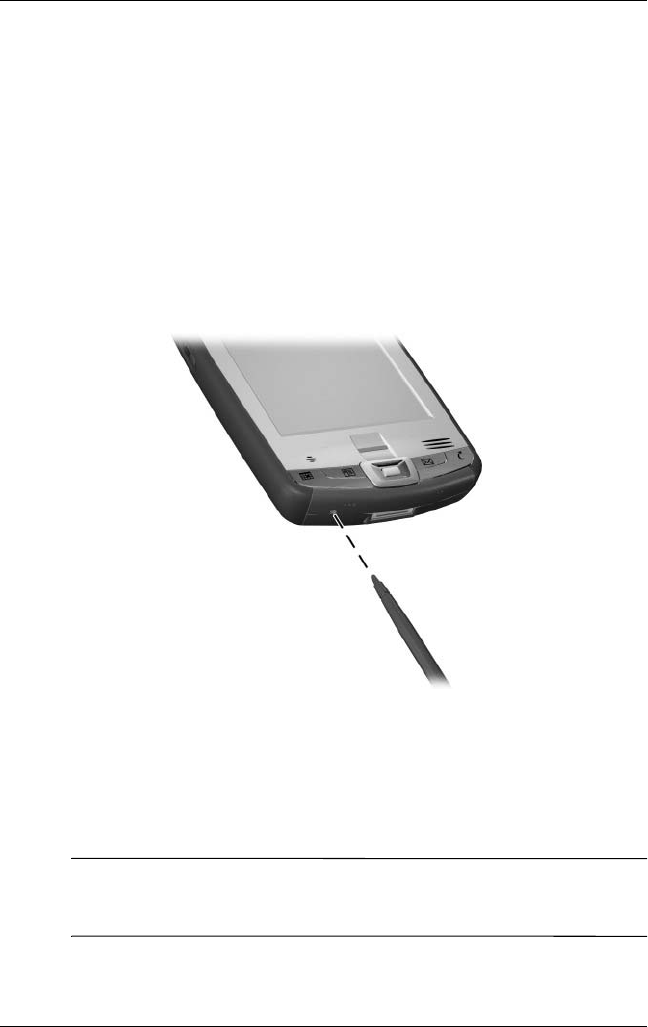
8VHU·V*XLGH ²
*HWWLQJWR.QRZ<RXUL3$43RFNHW3&
Performing a Soft Reset
Since a soft reset stops all running applications, be sure to save
any unsaved data within a running application before performing
a soft reset.
To perform a soft reset:
1. Locate the recessed Reset button on the bottom of your iPAQ
Pocket PC.
2. Use the stylus to lightly press the Reset button.
The Pocket PC restarts and displays the Today screen.
Performing a Hard Reset
Perform a hard reset only when it is necessary because this
process does clear all user-installed settings, programs, and data
from ROM.
ÄCAUTION: If you perform a hard reset, your Pocket PC returns to its
default settings and loses all data and programs not saved in iPAQ File
Store.
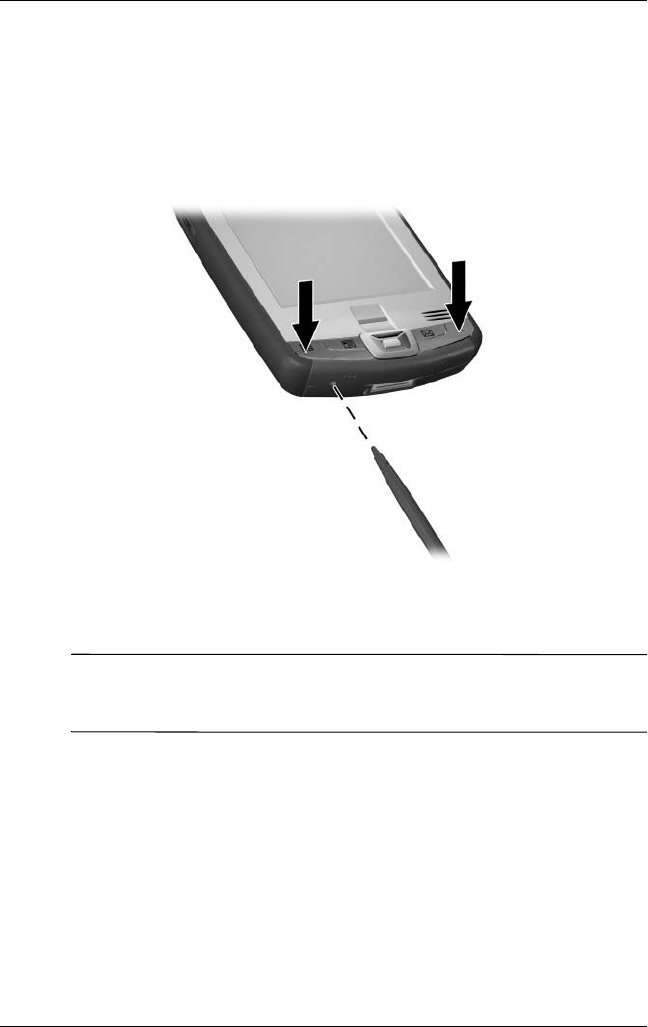
*HWWLQJWR.QRZ<RXUL3$43RFNHW3&
8VHU·V*XLGH ²
To perform a hard reset:
1. Press and hold down the Calendar and iTask buttons.
2. While holding down these buttons, use the stylus to
lightly press the Reset button on the bottom of the iPAQ
Pocket PC for about two seconds.
3. When the Pocket PC screen begins to fade, release the
Calendar and iTask buttons first, and then remove the stylus
from the Reset button.
ÄCAUTION: If you push and hold the Reset button for more than two
seconds, the battery disconnects. To restart the unit, either plug the unit
into the AC Adapter or press the Reset button again.
4. The Pocket PC resets and powers on.

8VHU·V*XLGH ²
*HWWLQJWR.QRZ<RXUL3$43RFNHW3&
Aligning the Screen
When the iPAQ Pocket PC is turned on for the first time, you are
guided through a screen alignment process. You must realign
your screen if:
■The Pocket PC does not respond accurately to your taps.
■You perform a full reset of your Pocket PC.
To realign the iPAQ Pocket PC screen:
1. From the Start menu, tap Settings > System tab > Screen
icon.
2. Tap the Align Screen button.
Shortcut: To access the Align Screen application without
tapping on the screen, press and release all four application
buttons at the same time. [Verification to come.]
3. Tap the cross-hair object at each location. Be precise when
tapping the cross-hair object.
4. Tap OK.
Using the Touchscreen
[Information to come.]

*HWWLQJWR.QRZ<RXUL3$43RFNHW3&
8VHU·V*XLGH ²
Routine Care
To keep your Pocket PC in good condition and working properly,
follow these guidelines:
■Keep your Pocket PC away from excessive moisture and
temperature extremes.
■Do not expose your Pocket PC to liquids or precipitation.
■Do not place anything on top of your Pocket PC to prevent
damage to the screen.
■Clean your Pocket PC by wiping the screen and the exterior
with a soft, damp cloth lightly moistened only with water.
■Avoid exposing your Pocket PC to direct sunlight or strong
ultraviolet light for extended periods of time.
■Avoid scratching the surface of the screen and banging it
against hard objects.
■Use only the stylus that comes with your Pocket PC or an
approved replacement on the screen to prevent scratching it.
ÄCAUTION: To reduce the risk of damage to the internal components,
do not spray liquid directly on the screen, or allow excess liquid to drip
inside your Pocket PC. Using soap or other cleaning products on the
screen might discolor the finish and damage it.
Traveling with your Pocket PC
Use the following guidelines when traveling with your Pocket
PC.
■Back up your information.
■Take a copy of your backup with you on an SD memory card.
■Disconnect all external devices.
■Take the AC Adapter and Charger Adapter with you.

8VHU·V*XLGH ²
*HWWLQJWR.QRZ<RXUL3$43RFNHW3&
■Keep your Pocket PC in a protective case and keep it in your
carry-on luggage.
■For air travel, be sure to turn off the Phone, Bluetooth, and
Wi-Fi. To turn off all wireless features, from the Today
screen, tap Start > iPAQ Wireless > All Off.
■If you are traveling internationally, be sure you have the plug
adapter appropriate for the country you are visiting.

8VHU·V*XLGH ²
2
Synchronizing with Your
Computer
Using Microsoft ActiveSync
Your device can be connected to a computer so you can transfer
files back and forth. In this way, you only have to input data once.
Microsoft ActiveSync is a synchronization program you install
on your desktop or laptop computer to:
■Copy files (data, audio or video) between your device and up
to two host computers so you always have the latest
information in all locations.
■Install programs on your device
■Back up and restore device information
■Synchronize links
■Send and receive e-mail
■Request meetings
Installing ActiveSync
ÄCAUTION: For synchronization to work properly, install Microsoft
ActiveSync on your computer (Steps 1 and 2 below) before you
connect your iPAQ Pocket PC to your computer (Step 3).
To install Microsoft ActiveSync on your host computer:
1. Insert the Companion CD into the CD tray or slot on your
computer.
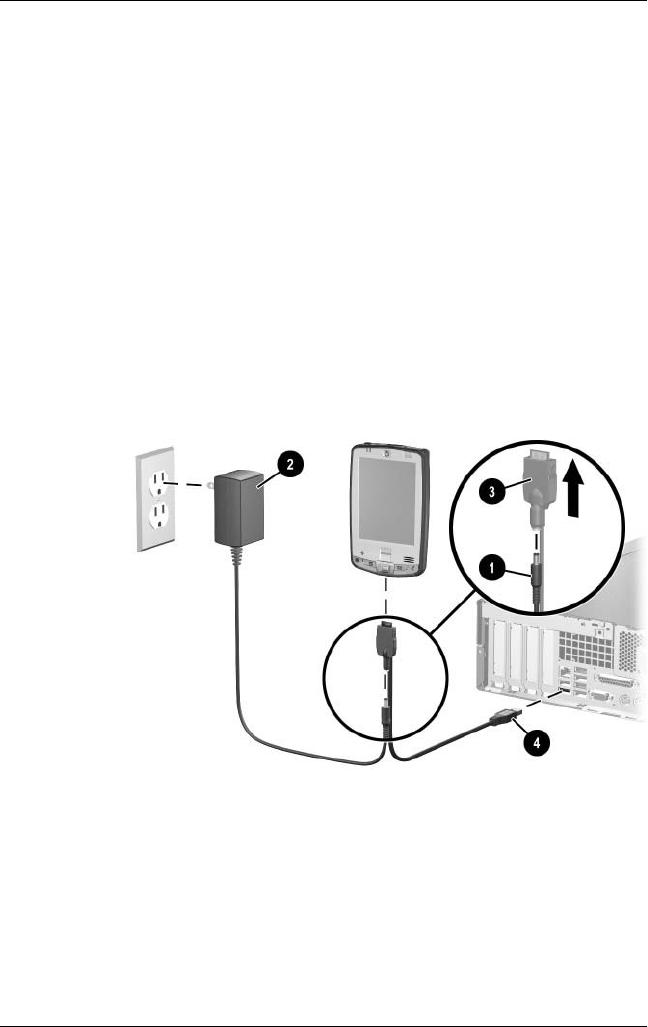
8VHU·V*XLGH ²
6\QFKURQL]LQJZLWK<RXU&RPSXWHU
2. After the introductory screen displays, click Setup Wizard.
The Setup Wizard detects the programs on your computer,
and guides you step by step so you can install ActiveSync on
your computer as well as other programs on your Pocket PC.
3. Follow the screen recommendations and when prompted,
connect your Pocket PC to your personal computer:
a. Plug the round end of the AC Adapter 1 into the charger
adapter on the sync cable.
b. Connect the AC Adapter 2 to a standard electrical outlet.
c. Connect one end of the sync cable 3 to the bottom of the
Pocket PC.
d. Connect the USB connector on the sync cable 4 to the
USB port on your computer.
4. Once you are finished with the Setup Wizard, you can
disconnect the Pocket PC from the sync cable.

6\QFKURQL]LQJZLWK<RXU&RPSXWHU
8VHU·V*XLGH ²
Synchronizing with Your Computer
With ActiveSync installed on your computer, you can:
■Use it any time to create an additional partnership so you can
synchronize information with up to two computers.
■Add or delete the type of data (Contacts, Calendar, Inbox,
Tasks, Favorites, Files, Notes, and AvantGo) you want
synchronized with your Pocket PC.
Note: When you synchronize files, you can drag and drop the
selected files from your computer to the synchronized folder on
your iPAQ Pocket PC. If you named your device “PC1” when you
created your partnership, then the synchronized folder is named
“PC1.” When you synchronize, the files are automatically moved
to and from your iPAQ Pocket PC.
Changing Synchronization Settings
You can modify your synchronization settings for Microsoft
ActiveSync to:
■Change when your iPAQ Pocket PC synchronizes with your
host computer.
■Change the type of connection (serial, USB, or infrared) from
your iPAQ Pocket PC to your computer.
■Select the files and information to synchronize.
■Select the files and information you do not want to
synchronize (for example, e-mail attachments).
■Determine how conflicts between information on your
iPAQ Pocket PC and information on your computer are to be
handled.

8VHU·V*XLGH ²
6\QFKURQL]LQJZLWK<RXU&RPSXWHU
To change synchronization settings:
1. From the Start menu on your computer, click Programs >
Microsoft ActiveSync > Tools > Options.
a. On the Sync Options tab, select the files and information
to synchronize with your computer.
b. On the Schedule tab, select when your iPAQ Pocket PC
synchronizes with your computer.
c. On the Rules tab, determine how conflicts between
information on your iPAQ Pocket PC and information
on your computer are to be handled.
2. Tap OK when you are finished.
3. From the File menu, click Connection Settings. Select the
type of connection to be allowed between the iPAQ Pocket
PC and the computer.
Using the Infrared Connection
As an alternative to using the desktop cradle, you can synchronize
your Pocket PC and your computer using the infrared connection
if you have an infrared port or an infrared USB adapter installed
on your computer. The infrared connection option works only on
computers that have Microsoft Windows 98SE, Me, 2000, or XP
operating systems installed.
To set up an infrared connection to a computer:
1. Synchronize your Pocket PC with your computer using the
desktop cradle before the first time you establish an
ActiveSync connection via infrared.
2. Follow your computer manufacturer’s instructions to install
and set up an infrared port.
3. Remove the Pocket PC from the cradle and line up the
infrared port with the computer infrared port so they are
unobstructed and within 12 inches (30.5 cm) of each other.

6\QFKURQL]LQJZLWK<RXU&RPSXWHU
8VHU·V*XLGH ²
4. Initiate a connection by tapping Start > Programs >
ActiveSync > Tools >Connect via IR. Synchronization
begins on your device.
5. To disconnect, move the devices away from each other or
tap X in the upper right of the screen to turn off.
Copying Files
You can copy files to and from your host computer using Explore
in ActiveSync and Windows Explorer.
To copy files:
1. Insert your iPAQ Pocket PC into the sync cable.
2. From the Start menu on your computer, click Programs >
Microsoft ActiveSync.
3. Click Explore.
4. Double-click the My Pocket PC.
5. On your computer, right-click the Start menu, and select
Explore.
6. Locate the file to be moved.
Note: You cannot copy preinstalled files or system files.
7. Drag and drop your files between your iPAQ Pocket PC and
your computer. ActiveSync converts the files so that they can
be used by the Pocket Office programs, if necessary.
Note: Move your files directly into My Documents on your
iPAQ Pocket PC (or into a folder inside My Documents), so
the programs on your iPAQ Pocket PC can locate them.

8VHU·V*XLGH ²
6\QFKURQL]LQJZLWK<RXU&RPSXWHU
Installing Programs
To install programs on your iPAQ Pocket PC from your computer
using ActiveSync:
1. Connect your iPAQ Pocket PC to your computer using the
sync cable.
2. Follow the instructions on the screen.
3. Check the screen of your iPAQ Pocket PC to see if any
further steps are necessary to complete the installation.
Backing up and Restoring Files
To help reduce the chance of losing information, you should back
up information to your computer regularly. For more information
on backing up and restoring information using Microsoft
ActiveSync, refer to Chapter 7, in section “Using iPAQ Backup
to Backup/Restore.”
Synchronizing Links
You can synchronize links to websites from the Favorites list on
your computer to view them offline with Pocket Internet
Explorer.
1. From the Start menu on your computer, click Programs
and double-click the Internet Explorer.
2. Click Favorites to see the list of links to your favorite
websites.
3. To save a website link to Mobile Favorites, open the website
and click Create Mobile Favorite.
If you select “Favorites” as an information type to be
synchronized, ActiveSync copies your mobile favorite
to your Pocket PC the next time you synchronize.
4. Follow the instructions in Synchronize information to
manually synchronize your favorite links.

6\QFKURQL]LQJZLWK<RXU&RPSXWHU
8VHU·V*XLGH ²
Sending and Receiving E-mail
You can send and receive e-mail messages by synchronizing your
iPAQ Pocket PC with your computer using ActiveSync. If you are
using ActiveSync to send and receive e-mail messages, the name
of the folder you are using is displayed at the bottom of the
screen. For more information on sending and receiving e-mail
using ActiveSync, from the Start menu, tap Help > Inbox.
Requesting Meetings
You can schedule a meeting and send a meeting request through
ActiveSync. For more information, from the Start menu, tap
Help > Calendar.

8VHU·V*XLGH ²
3
Managing the Battery
Your iPAQ Pocket PC is shipped with a rechargeable battery that
is partially charged. It is recommended that you fully charge the
Pocket PC battery before setting up the unit, and recharge
regularly. Your Pocket PC uses some power to maintain files in
RAM and the clock. While working at your desk, keep the Pocket
PC and AC Adapter connected through the USB Synchronization
Common cradle. When you travel, it is recommended that you
carry the AC Adapter, Charger Adapter plug, or an optional spare
battery with you.
ÄCAUTION: Use only an HP approved battery for your iPAQ Pocket
PC. Inserting a battery that does not comply with HP requirements might
cause the Pocket PC to malfunction.
The iPAQ Pocket PC also has a small internal backup battery that
allows you to change the main battery without losing RAM data
(user-installed programs and data) as long as it is replaced within
15 minutes. The internal battery can only be removed by
qualified HP Technical Support.
Installing the Battery
To install the removable/rechargeable battery:
1. Insert the right side of the battery into the right side of the
battery compartment.
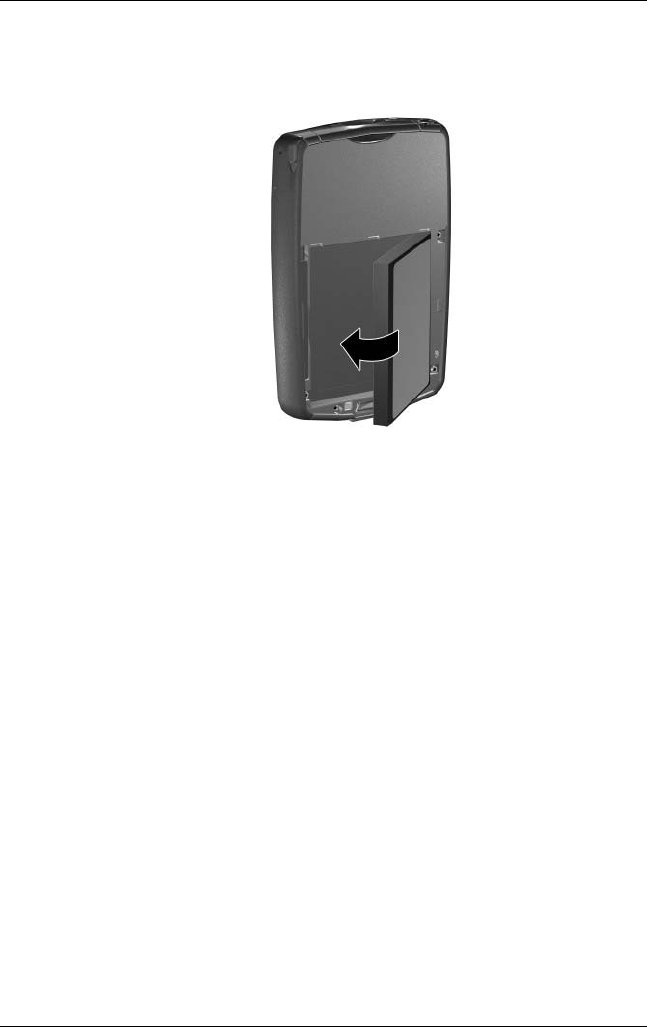
0DQDJLQJWKH%DWWHU\
8VHU·V*XLGH ²
2. Press the left side of the battery into place.
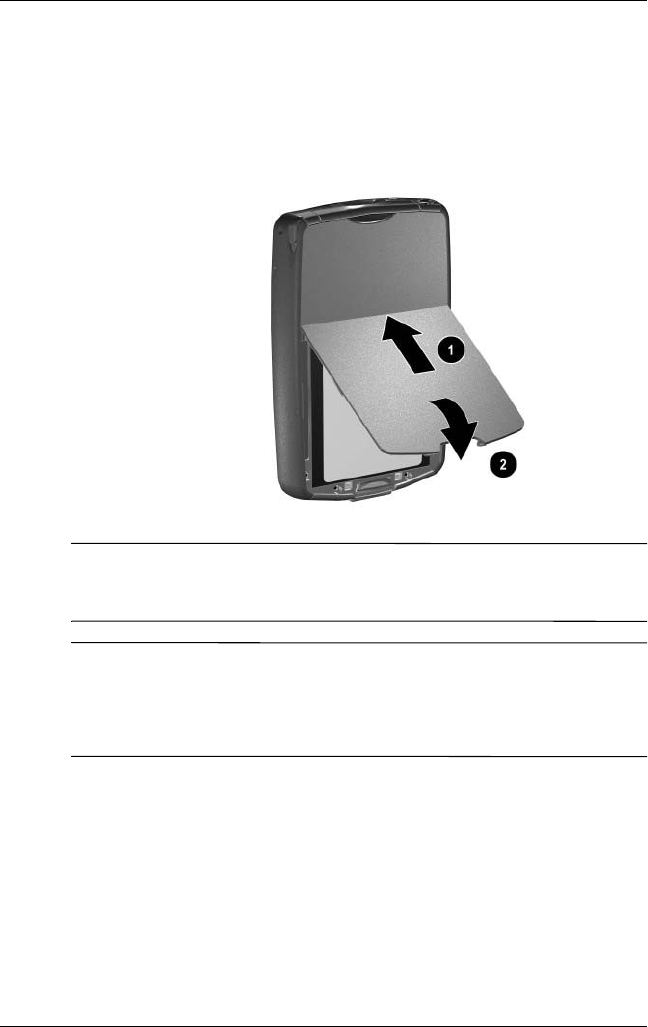
8VHU·V*XLGH ²
0DQDJLQJWKH%DWWHU\
3. Insert the top of the battery cover into the top of the battery
compartment 1.
4. Press the bottom of the battery cover into place until it clicks
2.
ÄCAUTION: The cover must be in place for the Pocket PC to operate. If
the battery cover is not in place when you press the Power button, the
Pocket PC will not power on.
NOTE: If the battery is fully discharged, you must connect the
AC Adapter to the Pocket PC to fully charge it before continuing.
It takes up to four hours to fully charge a completely drained
battery.
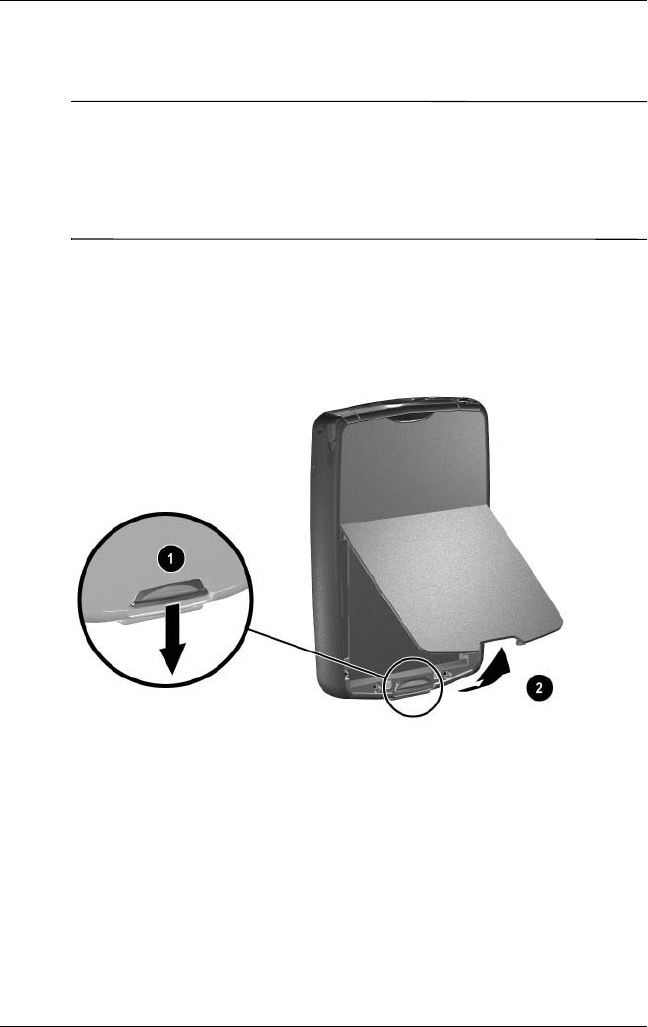
0DQDJLQJWKH%DWWHU\
8VHU·V*XLGH ²
Removing the Battery
ÄCAUTION: Before removing the battery, use iPAQ Backup or
ActiveSync to back up data on your Pocket PC. If you need to clear the
memory during the removal process, you will be able to restore the
data. To prevent losing information, you can also copy user-installed
applications to the iPAQ File Store folder. For more information on the
File Store, refer to Chapter 4, in section “Using iPAQ File Store Folder.”
To remove the battery:
1. Press the battery button down 1.
2. Swing the battery door up and remove it from the unit 2.
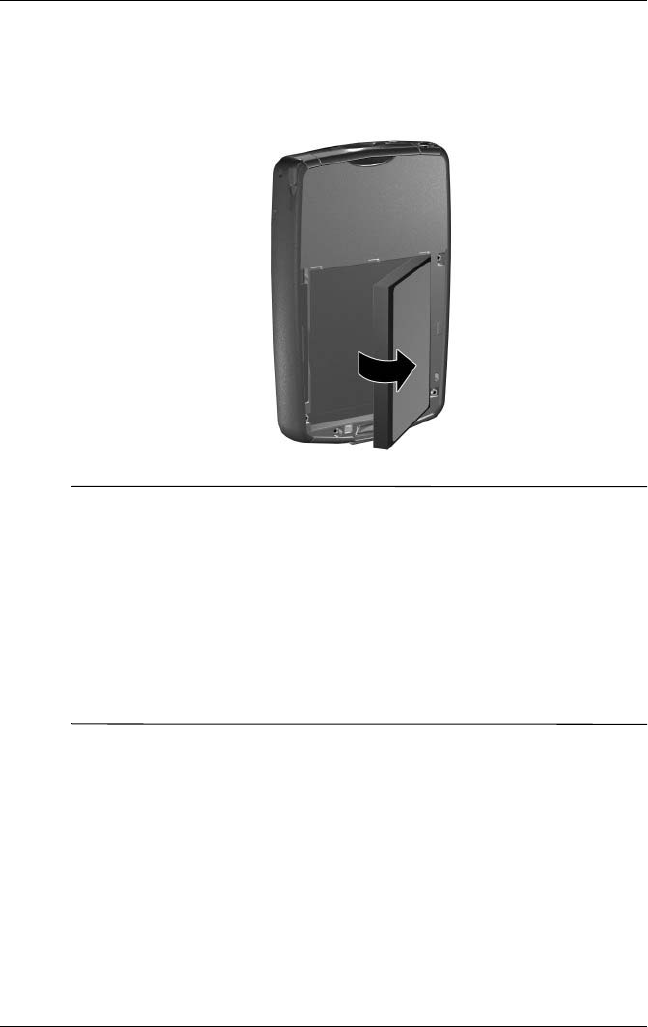
8VHU·V*XLGH ²
0DQDJLQJWKH%DWWHU\
3. Lift the left side of the battery up and remove it from the
Pokcet PC.
ÄCAUTION: Because most of the applications and data you install on
your Pocket PC are held in memory (RAM), you will need to reinstall
them if the battery completely discharges or if the battery is removed
from the unit for more than 15 minutes. Otherwise, when fully charged,
the internal backup battery saves the user-installed data for up to 15
minutes when the standard battery is removed. Before removing the
battery, check to see that the internal backup battery is fully charged by
tapping Start > Settings > System tab > Power.
You do not need to reinstall applications and data installed in the iPAQ
File Store folder because they are saved in nonvolatile memory.
Charging with the AC Adapter
The standard AC Adapter works in a standard electrical outlet.
You can also charge your Pocket PC in your automobile with an
optional automobile adapter that works in your vehicle’s
electrical cigarette lighter or a 12-volt power outlet.
To purchase an optional automobile adapter, refer to the HP Web
site at: www.hp.com/go/ipaqaccessories.
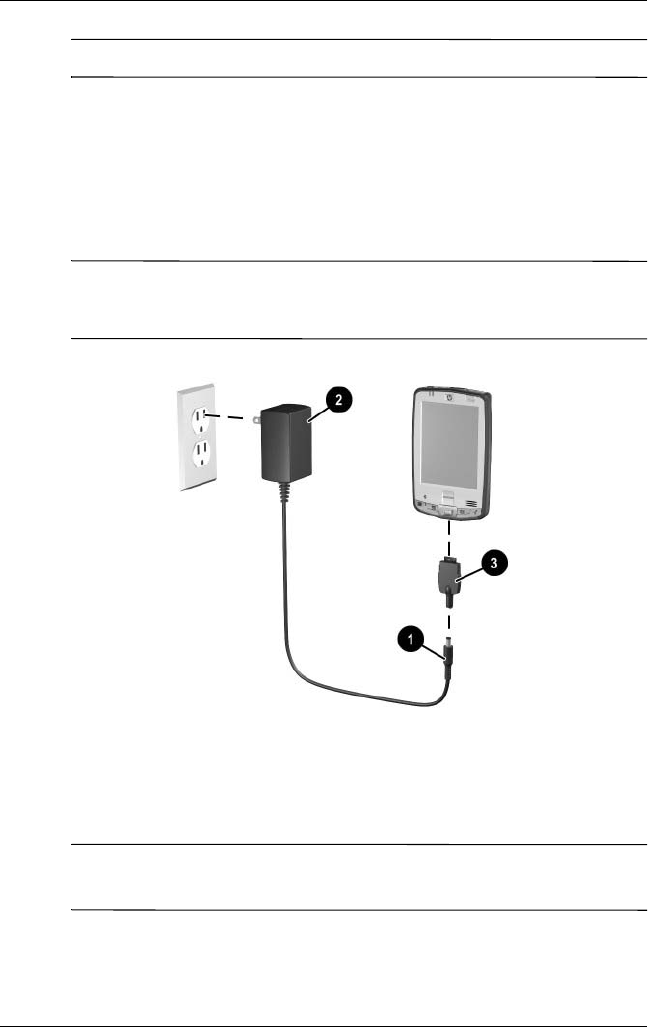
0DQDJLQJWKH%DWWHU\
8VHU·V*XLGH ²
ÄCAUTION: Use only HP recommended AC adapters.
To charge your Pocket PC using the AC Adapter:
1. Insert the AC Adapter plug into the AC Charger adapter 1.
2. Plug the AC Adapter into an electrical outlet 2.
3. Insert the AC Charger adapter into the bottom of the
Pocket PC 3.
ÄCAUTION: To avoid damaging your Pocket PC or the AC Adapter,
check to be sure all connectors are properly aligned before connecting
them.
4. When the Power button indicator on the front of the Pocket
PC turns solid amber, the unit is fully charged and you can
disconnect the AC Adapter. The approximate time to fully
charge a drained battery is four hours.
NOTE: A standard battery can be charged in about four hours, an
optional extended battery takes longer.
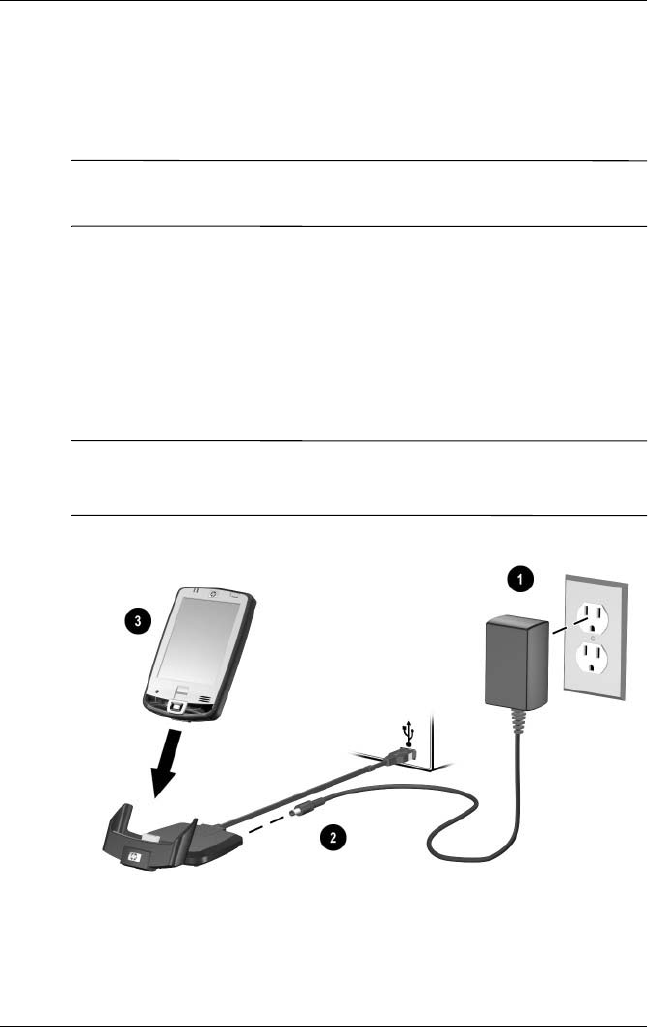
8VHU·V*XLGH ²
0DQDJLQJWKH%DWWHU\
Charging with the HP iPAQ Cradle and
AC Adapter
Use the HP iPAQ cradle to charge your Pocket PC.
NOTE: It is not necessary to synchronize your Pocket PC before
charging it.
To charge your Pocket PC using the HP iPAQ cradle:
1. Plug the AC Adapter into an electrical outlet 1 and connect
the other end of the AC Adapter to the AC connector on the
HP iPAQ cradle 2.
2. Slide the bottom of your Pocket PC into the HP iPAQ
cradle 3 and push firmly to seat it.
ÄCAUTION: To avoid damaging your Pocket PC or the cradle, check to
be sure the Pocket PC and cradle connectors are properly aligned
before pushing the Pocket PC into the HP iPAQ cradle.
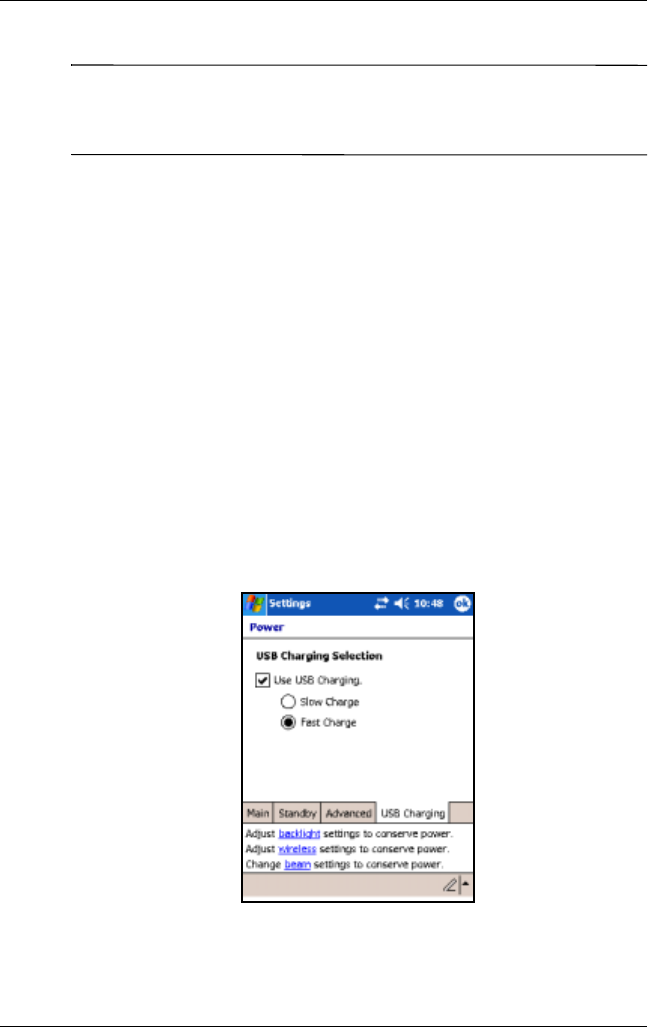
0DQDJLQJWKH%DWWHU\
8VHU·V*XLGH ²
NOTE: The amber charge light on the front of the Pocket PC
blinks while the battery is recharging and turns solid amber
(nonblinking) when the battery is fully charged.
Charging with the HP iPAQ Cradle and USB
Cable
An alternative method of charging the Pocket PC is to charge the
unit by using a USB cable. However, because this charging
method drains the host battery (i.e., laptop), you must enable
USB charging on the Pocket PC before you can charge the unit.
To charge your Pocket PC using the HP iPAQ Cradle and USB
Cable:
1. Turn on USB charging by tapping Start > Settings > System
tab > Power on the Pocket PC.
2. Select the USB Charging tab, and then check Use USB
Charging.
3. Tap OK once USB Charging has been enabled.

8VHU·V*XLGH ²
0DQDJLQJWKH%DWWHU\
4. Connect one end of the USB sync cabe to the bottom of the
Pocket PC.
5. Connect the USB cable to an available USB Port on your
USB powered device, such as a laptop.
NOTE: The Pocket PC charges slower when using an USB cable
than with an AC Adapter.
Charging a Spare Battery
Battery Saving Tip: To ensure you always have battery power
available, invest in an extra Standard Slim Battery or
Extended Battery. These batteries can be charged in the HP
iPAQ Battery Charger. To purchase an extra battery and/or a
battery charger, refer to the HP Web site at
www.hp.com/go/ipaqaccessories.
To charge a spare battery:
1. Plug the AC Adapter into an electrical outlet 1 and connect
the other end of the AC Adapter to the AC connector on the
battery charger 2.
2. Insert the battery into the battery compartment 3 with the
connectors on the top of the battery lined up with the
connectors inside the battery compartment, and push in to
seat it 4.
3. When the light on the front of the battery charger 5 is
blinking amber, the battery is charging. When the light
becomes solid amber, the battery is completely charged and
ready to use.
NOTE: If the battery light goes out when you are charging the
battery, you either have a bad battery or a timeout has occurred.
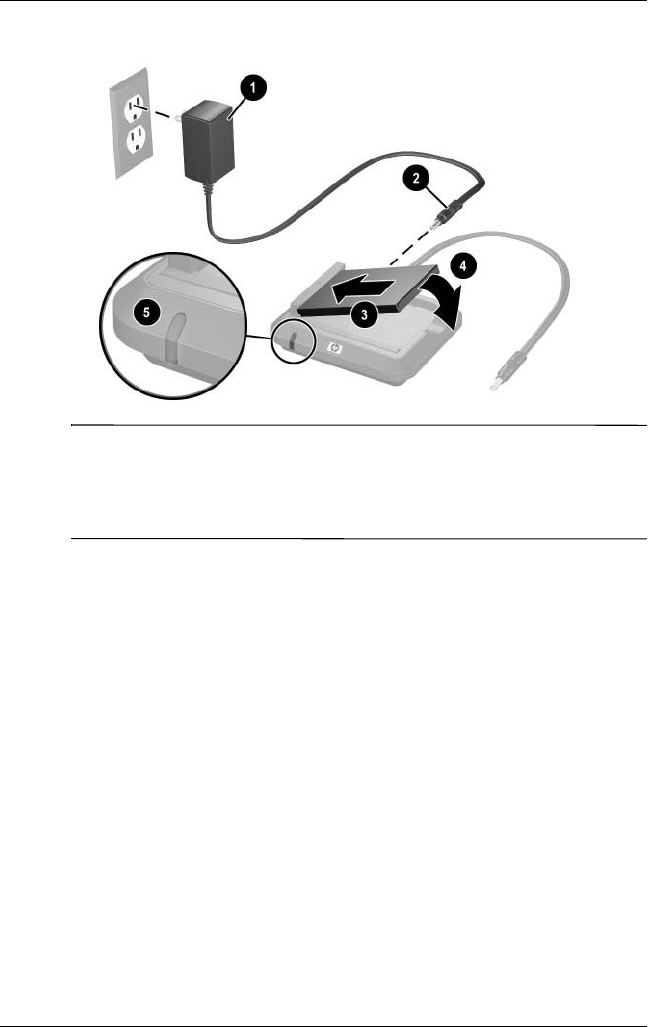
0DQDJLQJWKH%DWWHU\
8VHU·V*XLGH ²
NOTE: If you connect another Pocket PC while you are charging a
spare battery, charging time increases. Depending how many
units you have hooked up, it can take from up 30 hours to charge
the battery.
Manually Checking the Battery Charge
Level
To manually monitor the battery power:
1. From the Start menu, tap Settings > System tab.
2. Tap Power > Battery tab.
If the battery charge level is low, connect to AC power using
the HP iPAQ Cradle and the AC Adapter, or change the battery.
For information on purchasing a spare battery or optional
Extended Battery, visit the HP Web site at
www.hp.com/go/ipaqaccessories.

8VHU·V*XLGH ²
0DQDJLQJWKH%DWWHU\
To use a shortcut to view your battery charge level, tap the
battery icon located in the Pocket Panel Lite on the Today screen
plug in.
Battery Saving Tip: Tap Start > Settings > System tab > Power >
Advanced tab, and then tap the Turn off device if not used for
checkbox and set it to turn your iPAQ Pocket PC off after a short
time of not being used.
CAUTION: It is recommended that you do not allow the battery
installed in your iPAQ Pocket PC to discharge completely. Doing so
does not harm your Pocket PC or battery; however, you will lose all
data not stored in File Store (ROM). Discharging the battery
completely is similar to performing a hard reset. Refer to Chapter 1,
“Performing a Hard Reset” for more information.
Battery Saving Tips
Here are some battery saving tips to help save energy in your
Pocket PC battery.
■Leave your Pocket PC connected to AC power at all times
when you’re not using it. For more information, refer to
“Charging with the AC Adapter” earlier in this chapter.
■Set your Pocket PC to turn off after a short time if not being
used. Tap Start > Settings > System tab > Power >
Advanced tab. Next, check the “Turn off device if not used
for” box, and then select a time duration.
■Set the backlight to go off quickly (10 or 30 seconds) after
you stop using your Pocket PC, or implement Power Save
mode to turn off the backlight completely. For more
information, refer to “Changing the Backlight Settings” later
in this chapter.
■Turn off all wireless activities when not in use. Refer to
Chapter 8, in section “Powering Wi-Fi On or Off” and
Chapter 9, in section “Turning On/Off Bluetooth.”

0DQDJLQJWKH%DWWHU\
8VHU·V*XLGH ²
■Turn off the “Receive all incoming beams” setting and
receive infrared beams manually instead. Refer to Chapter 2,
“Synchronizing with Your Computer.”
■You can program an Application Button to turn off the screen
when an MP3 is playing, thus saving battery power used to
run the screen. Tap Start > Windows Media > Tools >
Settings > Buttons. From the Select Function drop-down
list, tap Screen Toggle. Press either the Contacts or Inbox
application buttons on the front of your iPAQ Pocket PC, and
then tap OK.
■Power off your Pocket PC when it is being charged to allow it
to charge at a faster rate.
Changing the Backlight Settings
To adjust the backlight settings in order to conserve more battery
power:
1. From the Start menu, tap Settings > System tab >
Backlight.
2. Select from the following backlight settings:
■Battery Power
■External Power
■Brightness
3. Make your changes to the backlight settings, and then tap
OK.
Battery Saving Tip: Set the backlight to go off quickly after
you stop using your iPAQ Pocket PC, or change the
brightness level to save power.

8VHU·V*XLGH ²
0DQDJLQJWKH%DWWHU\
Changing Wi-Fi Power Saving Modes
<Exact settings and user interface subject to change. More
information to come.>
To change Wi-Fi power saving modes:
1. From the Start menu, tap Settings > System tab > Power >
Wireless settings link located at the bottom of the screen.
2. For Wi-Fi Power Save mode, select:
■OFF—No Wi-Fi Power Save. Use only if the absolute
highest Wi-Fi throughput is required or if your network
configuration does not support these modes.
■Auto—Automatically switches between Power Save and
no power save.
■Extended—Uses the least battery power while
maintaining a Wi-Fi connection. This mode significantly
reduces the Wi-Fi data throughput.
It is not recommended for large file transfers.
Note: The Extended power saving mode is not recommended if
Bluetooth is also on.
Disabling Buttons
The Button Lock application allows you to disable all the buttons
on your Pocket PC, except the power button whenever the unit is
in Standby mode. By enabling this feature, you can ensure the
device is not accidentally turned on, thus draining your battery.
To enable the button lock feature:
1. From the Start menu, tap Settings > Buttons icon.
2. Tap the Lock tab and check Disable all buttons except
power button.
3. Tap OK.
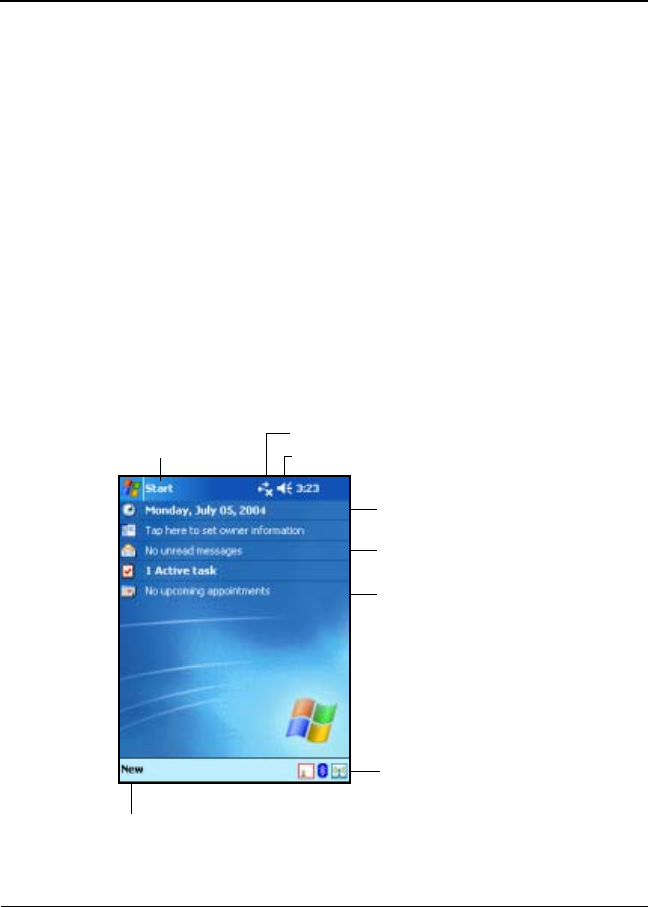
8VHU·V*XLGH ²
4
Learning the Basics
Using the Today Screen
When you first turn on your iPAQ Pocket PC, the Today screen
displays. You can also display it by tapping Start > Today. Use
the Today screen to view:
■Owner information
■Upcoming appointments
■Unread and unsent messages
■Tasks that need to be completed
Tap to view
Programs menu Tap to change volume or mute all sounds
Tap to view Connections
Tap to change date and time
Tap to read e-mail
Tap to set appointment or
Tap to view and set Wi-Fi and
view existing appointments
Bluetooth settings
Tap to create a new item
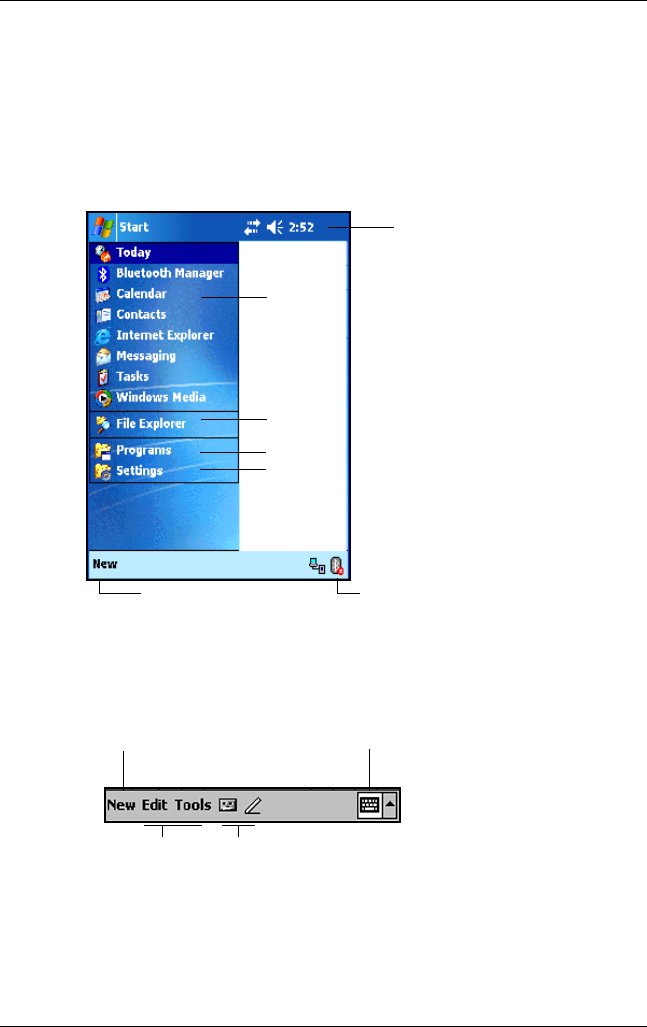
8VHU·V*XLGH ²
/HDUQLQJWKH%DVLFV
Navigation Bar and Command Bar
The Navigation Bar is located at the top of the screen. It displays
the Start button, active notifications (such as new e-mail, Wi-Fi
connection status, speaker status) and current time. Use the Start
menu to select a program.
The Command bar is located at the bottom of the screen. The
New menu provides shortcuts in creating new appointments,
contacts, tasks, notes, etc. The Input panel button allows you to
enter text.
Tap to view online Help. Tap for Bluetooth features.
Tap to select a program you used recently.
Tap to see additional programs.
Tap to customize the settings.
Tap to select a program.
Navigation Bar
New button Input panel button
Menu Buttons
actions
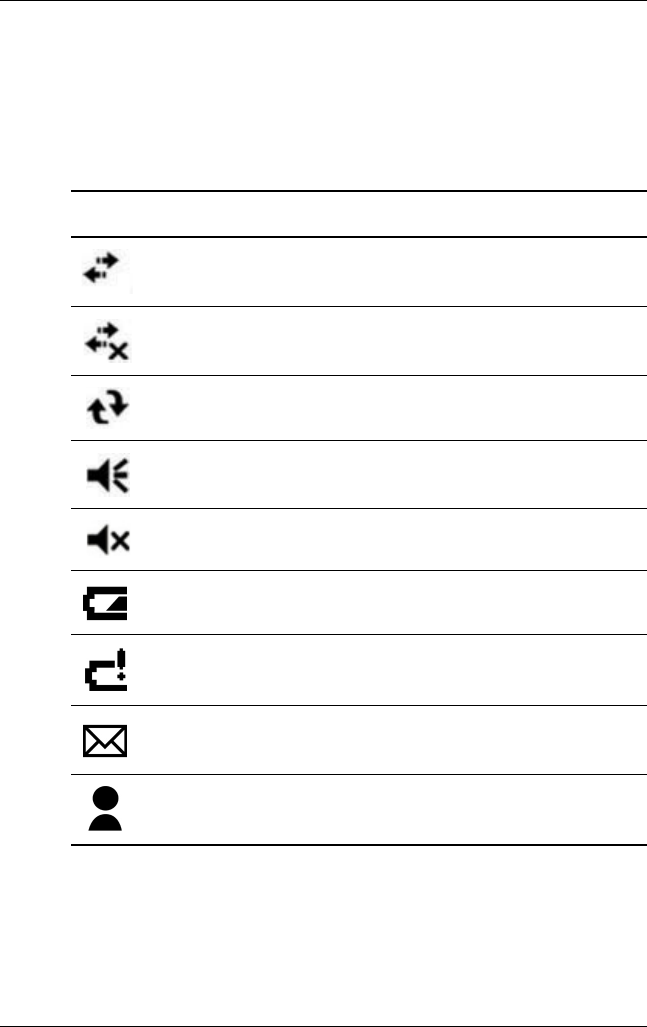
/HDUQLQJWKH%DVLFV
8VHU·V*XLGH ²
Status Icons
You may see the following status icons displayed on the
Navigation or Command bar. Tap the icon on the screen to view
more information related to the item.
Icon Status
Active connection to computer or wireless network.
Inactive connection to computer or wireless network.
Microsoft ActiveSync is synchronizing.
Speaker is on.
Speaker is off (or in mute position).
Battery power is low.
Battery power is very low.
E-mail, SMS or MMS messages received.
Instant messages received.
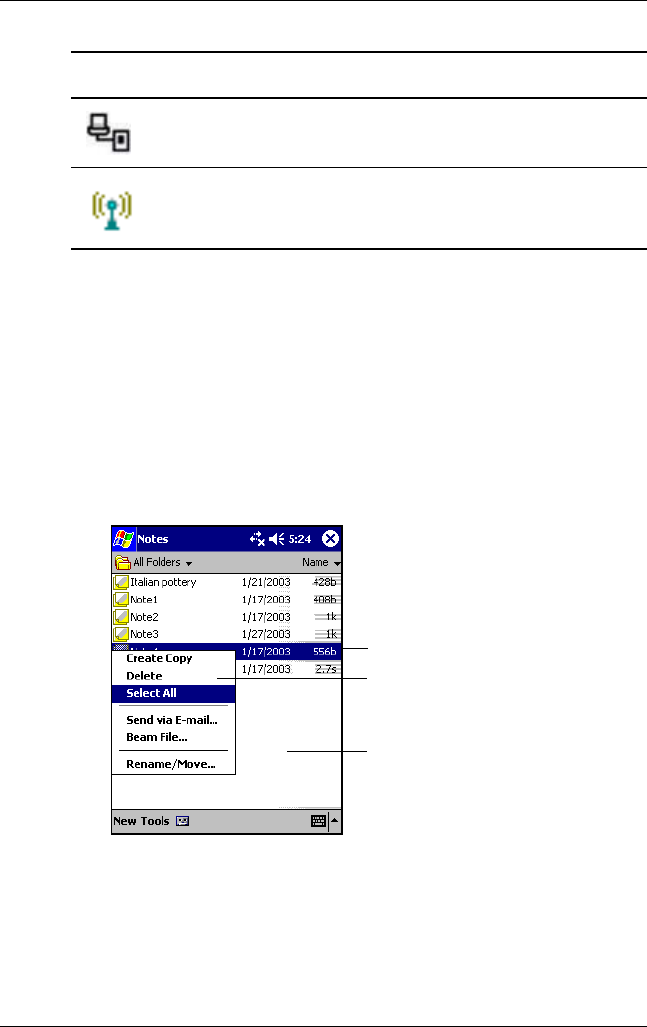
8VHU·V*XLGH ²
/HDUQLQJWKH%DVLFV
Pop-Up Menus
Pop-up menus allow you to quickly perform an action. Use the
pop-up menu to cut, copy, rename, and delete an item, also send
an e-mail or send a file to another device.
To access a pop-up menu, tap and hold the stylus on the item on
which you want to perform the action. When the menu appears,
tap the desired action, or tap anywhere outside the menu to close
it without performing an action.
iPAQ Pocket PC is connected with the desktop cradle. This
icon appears only when there is an active connection.
iPAQ Wireless icon—Tap to display Wireless screen.
Provides a control center to turn all wireless activities on
and off, and to configure their settings.
Icon Status &RQWLQXHG
Tap and hold to display
the pop-up menu.
Tap the action you want.
Tap outside the menu to close
it without performing an action.

/HDUQLQJWKH%DVLFV
8VHU·V*XLGH ²
Creating Information
From the Today screen, you can create new information,
including:
■Appointments
■Contacts
■Messages
■Excel Workbook
■Notes
■Tasks
■Word documents
1. From the Start menu, tap Today > New at the bottom of the
screen.
2. Tap an option to create a new item.
3. Tap OK after you finish creating a new item.
Customizing the Today Screen
From the Settings Today screen, you can:
■Add a picture as the background.
■Select the information that appears on the Today screen.
■Select the Today screen theme.
■Set the order of the information.
■Set when to see the Today screen.
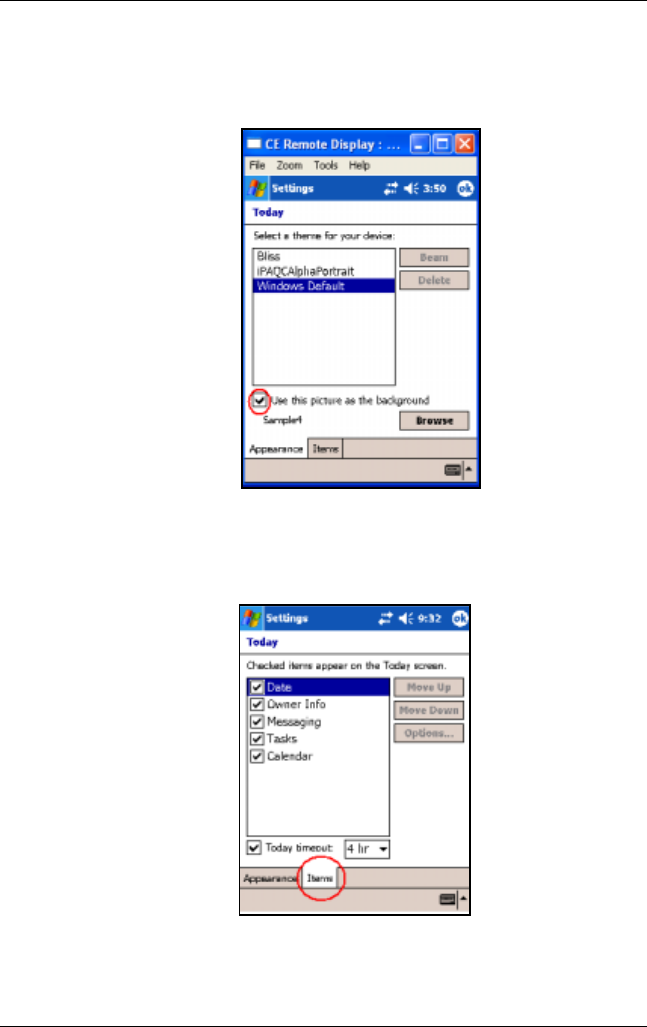
8VHU·V*XLGH ²
/HDUQLQJWKH%DVLFV
1. From the Start menu, tap Settings >Today.
2. Select Use this picture as the background checkbox.
3. Tap Browse to select a picture from File Explorer.
4. Tap the Items tab to select or reorder the information on the
Today screen.
5. Tap an item to highlight it.

/HDUQLQJWKH%DVLFV
8VHU·V*XLGH ²
6. Tap Move Up or Move Down to change the order of items on
the Today screen.
Note: You cannot change the placement of the Date on the Today
screen.
7. Tap the down arrow associated with Today timout checkbox
to determine how many hours must pass before the Today
screen displays.
8. Tap OK.
Changing the Screen Orientation
You can change the screen orientation of your Pocket PC from
Portrait to Landscape mode. You can also change the Pocket PC
font text size or enable ClearType for smoothing font edges for
easier readability.
To change the screen orientation of your Pocket PC:
1. From the Start menu, tap Settings >System tab.
2. Tap the Screen icon > General tab, and then select Portrait or
Landscape orientation.
For Landscape mode, you have a choice of right-handed or
left-handed screen orientation.
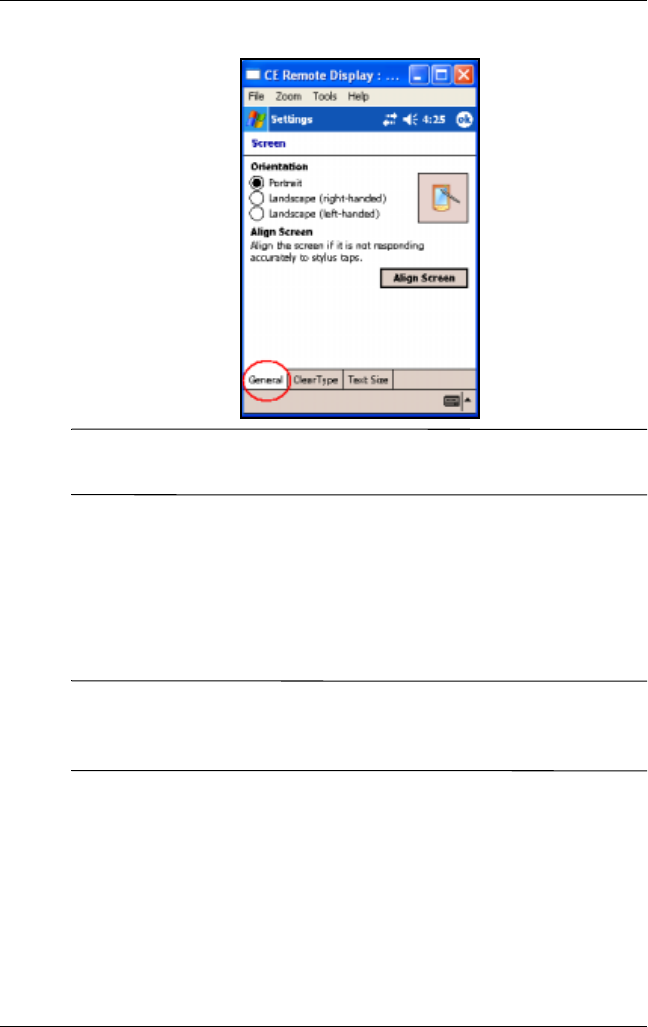
8VHU·V*XLGH ²
/HDUQLQJWKH%DVLFV
Note: Enable ClearType and Text Size to smooth font edges and
increases text size.
3. Tap OK when you have completed making your changes.
Opening and Closing Applications
Open any application on your iPAQ Pocket PC from the
Start menu.
Note: You can also open an application by assigning it to an
Application Button. To assign Application Buttons, from the
Today screen, tap Start > Settings > Buttons.
To open an application:
1. Tap Start > Programs.
2. Tap the desired application title or logo.

/HDUQLQJWKH%DVLFV
8VHU·V*XLGH ²
To minimize an open application, tap the x at the top right of the
screen.
Close applications either manually or by using iTask.
Note: Applications automatically close based on available
memory.
Closing with iTask
1. Press the iTask button (Application Button 4 on the lower
right side of your unit).
2. Tap and hold the program to be closed.
3. From the pop-up menu, tap Close This Task.
Closing Manually
1. From the Start menu, tap Settings > System tab >
Memory >Running Programs tab.
2. Tap Stop All or select a particular application, then tap Stop.
Note: To bring a currently running program to the foreground,
tap Activate.
Installing Applications
Install applications on your iPAQ Pocket PC from your:
■Computer by using Microsoft ActiveSync.
■iPAQ Pocket PC if the application file has a .cab extension.
■ iPAQ Pocket PC or your computer by copying an application
file that has an .exe or .cef extension.
When installing applications, look for the correct version for your
iPAQ model or Pocket PC 2003.

8VHU·V*XLGH ²
/HDUQLQJWKH%DVLFV
■Follow the instructions provided with the application and by
the installation Wizard to install applications from your
computer.
■Tap the application file in File Explorer on your iPAQ Pocket
PC and follow the instructions on the installation Wizard to
install applications on your Pocket PC.
Backing Up Information
Use iPAQ Backup or Microsoft ActiveSync Backup to back up
and restore information on your iPAQ Pocket PC.
Note: Your iPAQ Pocket PC came preinstalled with iPAQ Backup.
However, you must install ActiveSync on your computer before
using ActiveSync Backup.
To help reduce the chance of losing information, you should back
up information on a regular schedule. For more information on
backing up your data, refer to Chapter 7, in section “Using iPAQ
Backup to Backup/Restore.”
Using iPAQ File Store Folder
You can install programs and save files to the iPAQ File
Store folder, which is accessed from File Explorer on your
iPAQ Pocket PC.
Programs and files stored in iPAQ File Store are held in ROM and
are saved if you perform a full reset of your iPAQ Pocket PC or if
the battery discharges completely.

/HDUQLQJWKH%DVLFV
8VHU·V*XLGH ²
To save to iPAQ File Store:
1. Copy the files to be saved to the iPAQ File Store folder.
2. From the Start menu, tap Programs > File Explorer >
My Device > iPAQ File Store.
3. Paste the selected files.
Note: Before saving files to the iPAQ File Store folder, it is a good
idea to determine how much memory is available in the folder. To
view the amount of memory, from the Start menu, tap Settings >
System tab > Memory > Storage Card tab, then select iPAQ
File Store from the drop down menu.

8VHU·V*XLGH ²
5
Learning Input Methods
Using Input Software
ÄCAUTION: To avoid damaging your iPAQ Pocket PC screen, always
use a stylus. Never use a pen or any type of metal pointer on the
screen.
To input information to your Pocket PC, you can tap the
on-screen keyboard or write with the Letter Recognizer,
Microsoft Transcriber, or Block Recognizer in any application.
You can use the stylus to draw and write on the screen in the
Notes application and from any Notes tab in the Calendar,
Contacts, and Tasks applications.
Changing Word Suggestion Options
As you type or write, the Pocket PC suggests words for you in a
box above the keyboard, Letter Recognizer, or Block Recognizer,
but not in the Transcriber.
You determine:
■If words are suggested.
■The number of letters you enter before a word is suggested.
■The number of words that are suggested per entry.
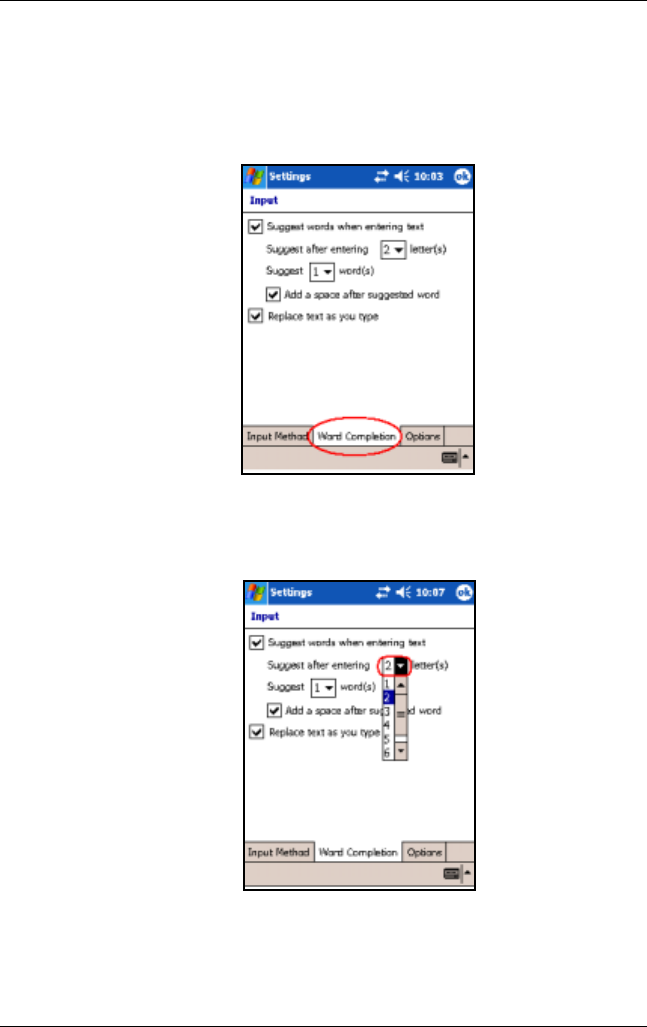
/HDUQLQJ,QSXW0HWKRGV
8VHU·V*XLGH ²
To change settings for word suggestions:
1. From the Start menu, tap Settings > Input.
2. Tap the Word Completion tab.
3. Tap the down arrow associated with letters and select the
number of letters you want to type before a word is
suggested.
t
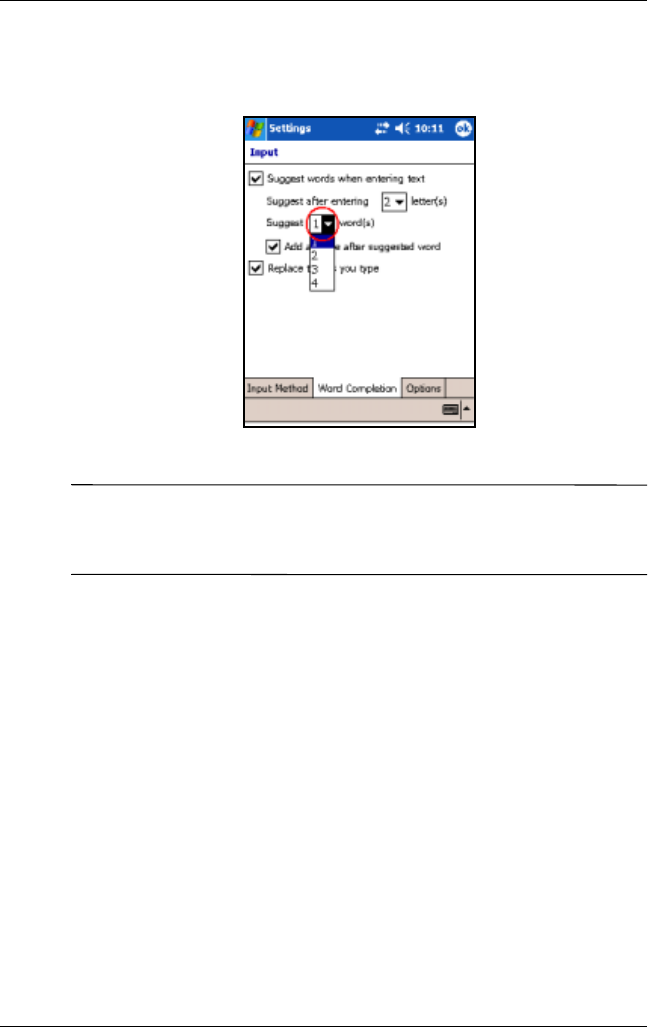
8VHU·V*XLGH ²
/HDUQLQJ,QSXW0HWKRGV
4. Tap the down arrow associated with words and select the
number of words you want suggested.
5. Tap OK.
Note: If you do not want any words suggested, remove the
checkmark by tapping the checkbox next to Suggest Words
When Entering Text.
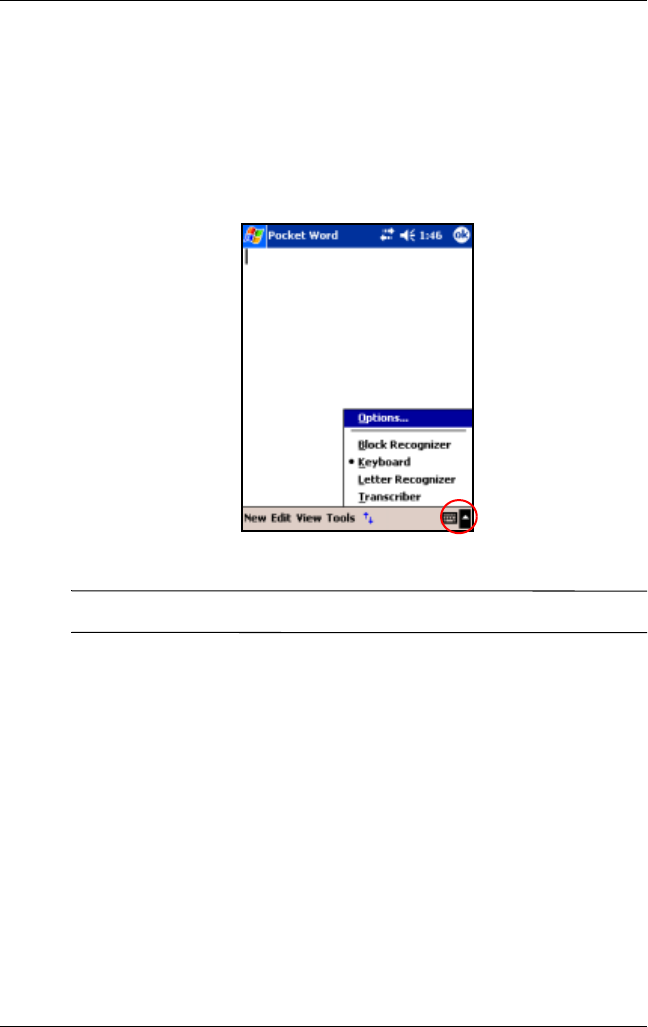
/HDUQLQJ,QSXW0HWKRGV
8VHU·V*XLGH ²
Using the On-Screen Keyboard
Use the stylus to tap letters, numbers, and symbols on the
on-screen keyboard to enter typed text directly onto the screen.
1. From any application, tap the up arrow next to the Input
Panel icon.
2. Tap Keyboard to display a keyboard on the screen.
Note: To see symbols, tap the 123 key.
3. Tap a letter, symbol, or number to enter information.
4. Tap OK.

8VHU·V*XLGH ²
/HDUQLQJ,QSXW0HWKRGV
Writing with the Stylus and the Letter
Recognizer
Use the stylus and Letter Recognizer to write letters, numbers,
and symbols on the screen. Create words and sentences by
writing in uppercase (ABC), lowercase (abc), and symbols (123)
as instructed here.
To write with the stylus and Letter Recognizer:
1. From any application, tap the up arrow next to the Input
Panel icon.
2. Tap Letter Recognizer.
3. Write a letter or symbol between the dashed line and
baseline.
❏To display in uppercase, write a letter between the hatch
marks labeled ABC.
❏To display in lowercase, write a letter between the hatch
marks labeled abc.
❏Write a number or draw a symbol between the hatch
marks labeled 123.
What you write will be converted to text.
Note: A question mark within a program indicates a Help file.
Note: For the Letter Recognizer to work effectively, write
characters between the dashed line and baseline.
■If you are writing a letter like “p,” write the top portion
within the dashed line and baseline, and the tail portion
below the baseline.
■If you writing a letter like “b,” write the bottom portion
within the dashed line and baseline, and the top portion
above the dashed line.

/HDUQLQJ,QSXW0HWKRGV
8VHU·V*XLGH ²
Using the Touchpad or Cursor
The touch-sensitive pad on your HP iPAQ senses the position of a
person's finger on its surface to provide screen navigation, cursor
movement, and interactive input. Use your touchpad to select
items, scroll, launch applications, and cursor control.
The touchpad is similar to using a mouse. Here are some terms
used when using the touchpad or cursor.
■Center Tap selects an item or launches an application.
■Tapping means quickly touching and then lifting your finger
off the Touchpad surface.
■Swipe Gesture swipes a specified number of steps in the
direction you swipe (vertical or horizontal).
■Swipe-and-Hold provides continuous scrolling in the
direction you want to scroll.
Personalizing Your Touchpad Settings
You can personalize the following settings for your HP iPAQ
touchpad:
■Touchpad sensitivity allows you to control how much finger
pressure is required to move the pointer at a particular speed.
■Scrolling Rate specifies how many steps a Swipe gesture or
a Swipe-and-Hold gesture scrolls when you are in Navigation
Mode.
■Cursor Speed allows you to adjust how quickly the cursor
moves in your iPAQ screen when you are in Cursor Mode.
For more information on your HP iPAQ touchpad, refer to the
online help on your HP iPAQ or go to the Synaptics NavPoint
tutorial located on the Companion CD. To locate the online help,
go to the Start menu > Help > ...<need new ROM to fill in>.

8VHU·V*XLGH ²
/HDUQLQJ,QSXW0HWKRGV
Writing with the Stylus and
Microsoft Transcriber
Use the stylus and Microsoft Transcriber to write words, letters,
numbers, and symbols anywhere on the screen.
1. From any application, tap the up arrow next to the Input
Panel icon.
2. Tap Transcriber to display the Transcriber Intro screen.
3. Tap OK.
4. Tap New at the bottom of the screen.
5. Begin writing on the screen. What you write will be
converted to text.
Note: To “teach” Transcriber your style of writing, tap on the “a”
icon at the bottom of the screen to display the Letter Shapes
screen and follow the instructions.
Writing with the Stylus and Block
Recognizer
Write letters, numbers, and symbols using the stylus and Block
Recognizer. Create words and sentences by writing letters and
numbers in specific areas.
1. From any application, tap the up arrow next to the Input
Panel button.
2. Tap Block Recognizer.
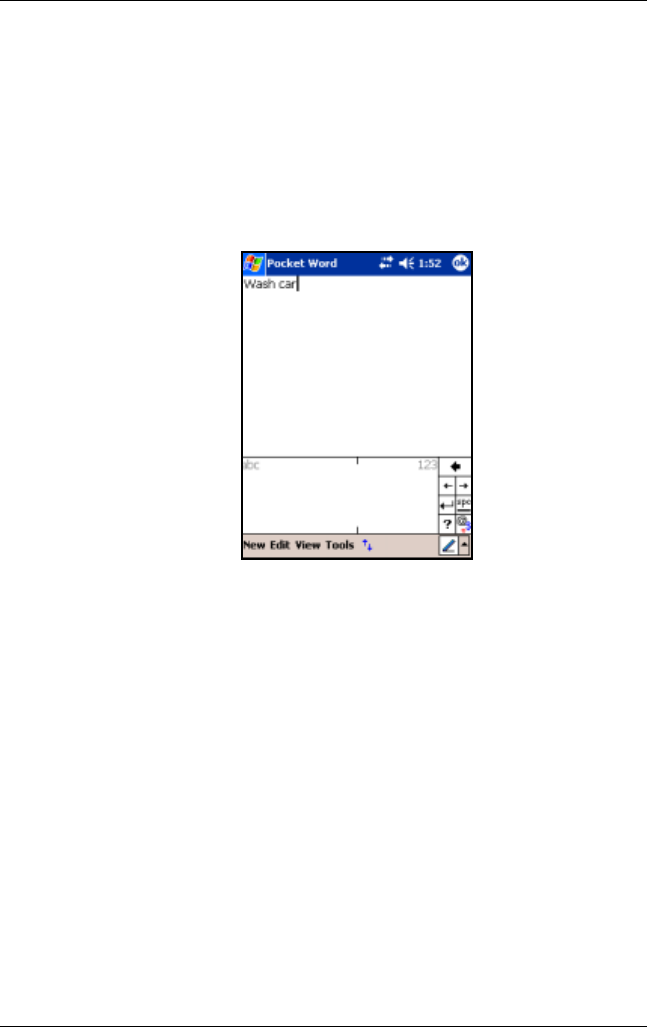
/HDUQLQJ,QSXW0HWKRGV
8VHU·V*XLGH ²
3. Write a word, letter, or symbol between the hatch marks.
❏To type text, write a letter between the hatch marks
labeled “abc.”
❏To type numbers or symbols, write a number or symbol
between the hatch marks labeled “123.”
What you write will be converted to text.
Drawing and Writing on the Screen
Use the stylus as a pen to draw and write on the screen in the
Notes program or from the Notes tab in Calendar, Contacts,
or Tasks.
1. From the Start menu, tap Notes > New.
2. Draw and write on the screen.
3. Tap the Pen icon.
4. Tap OK.

8VHU·V*XLGH ²
/HDUQLQJ,QSXW0HWKRGV
Converting Writing to Text
You can convert your writing to text when you write with the
stylus in the Notes program or from the Notes tab in:
■Calendar
■Contacts
■Tasks
To convert writing to text:
1. From the Start menu, tap Notes or tap the Notes tab in
Calendar, Contacts, or Tasks.
2. Tap a note to open it.
3. Tap Tools.
4. Tap Recognize.
Note: To convert a particular word or phrase, highlight it before
you tap Recognize. If a word is not recognized, it will not be
converted.
5. Tap OK.

8VHU·V*XLGH ²
6
Using Security Features
<Exact settings and user interface subject to change. More
information to come.>
The widespread use of Pocket PCs has significantly increased
employee productivity. However, non-secured or inadequately
secured Pocket PCs are creating network security issues for the
corporate workplace when they connect to a secure network.
Valuable information is bypassing network security and being
stored on inadequately secured Pocket PCs. The HP ProtectTools
and Fingerprint Reader security features have on-device security
protection so there is no risk of losing sensitive information on
your Pocket PC.
Using HP ProtectTools
Note: The following is a brief overview of the HP ProtectTools.
For more detailed information, refer to the HP ProtectTools
User’s Guide located on the Companion CD that came with your
Pocket PC.
Configuring Security
There are two ways to protect the privacy of the data on your
Pocket PC. They are:
■Lock the Pocket PC whenever it is not in use
■Log off the unit and encrypt the data

8VHU·V*XLGH ²
8VLQJ6HFXULW\)HDWXUHV
A discussion on data encryption comes later in this chapter under
the section called “Encrypting Your Data Using Vaults.”
Locking Your Pocket PC
To lock your Pocket PC:
1. From the Today screen, tap Start > Settings >System tab.
2. Tap HP ProtectTools icon > Lock Device.
The authentication screen appears and the device is locked until
authentication occurs.
Unlocking Your Pocket PC
The authentication method for unlocking your Pocket PC is as
follows:
■If you successfully enter your PIN, the device unlocks. If not,
you are prompted for a password.
■If you successfully enter your password, the device unlocks.
If not, you are prompted to answer the hint question you
defined.
■If you successfully answer your hint question, the device
unlocks. If not, the device locks and you are forced to
perform a hard reset.
Note: After you successfully authenticate, you are prompted to
reset any authentication information you didn't enter correctly.
For example, if you forgot your PIN, but successfully enter your
password, you're prompted to enter a new PIN.
Logging in Using Your PIN
To login using your PIN:
1. From the Today screen, tap Start > Settings > System tab >
HP ProtectTools.
The authentication screen appears.

8VLQJ6HFXULW\)HDWXUHV
8VHU·V*XLGH ²
2. Enter your PIN and the device unlocks.
Note: If you do not remember your PIN, you can tap Forgot PIN
in the lower left corner of the screen to enter your password
instead.
■If you enter an incorrect PIN, the message "Invalid PIN
entered" appears. Enter your PIN again.
■If you do not enter the correct PIN within three attempts, the
password screen appears.
Logging in Using Your Password
To login using your Password:
1. Enter your password and tap OK.
A message appears, indicating that you authenticated
successfully.
2. Tap OK.
If you entered the incorrect PIN, you will be prompted to create a
new PIN.
Note: If you do not remember your password, you can tap Forgot
Password in the lower left corner of the screen to answer your
hint question instead.
■If you enter an incorrect password, the message "Invalid
Password entered" appears. Enter your password again.
■If you do not enter the correct password within the configured
number of attempts, the question/answer screen appears.

8VHU·V*XLGH ²
8VLQJ6HFXULW\)HDWXUHV
Logging in Using a Question
To login using your hint question:
1. Enter the answer to your hint question in the Answer field
and tap OK.
A message appears, indicating that you authenticated
successfully.
2. Tap OK.
■If you entered the incorrect PIN and password at this point,
you will be prompted to create a new ones.
■If you enter an incorrect answer, the message "Invalid answer
entered" appears. Enter your answer again.
ÄCAUTION: If you do not enter the correct answer three times, your
Pocket PC locks and you are forced to perform a hard reset.
Changing Your Security Information
If you want to change your PIN, password, or question/answer,
you can do so easily.
Note: Any time authentication information expires, the Pocket PC
prompts you to change your PIN, password, or question.
Changing Your PIN
To change your PIN:
1. From the Today screen, tap Start > Settings > System tab,
and then HP ProtectTools icon.
2. Tap Change PIN when the Options screen appears.
3. Enter a new 4-digit PIN.
4. Confirm your PIN by entering it again. The message "Your
PIN has been successfully updated" appears.
5. Tap OK.

8VLQJ6HFXULW\)HDWXUHV
8VHU·V*XLGH ²
Changing Your Password
To change your password:
1. From the Today screen, tap Start > Settings > System tab,
and then HP ProtectTools icon.
2. Tap Change Passwords on the Options screen.
3. Enter a new password in the Password field.
4. Confirm your password by entering it again, and then tap
OK. The message "Your password has been successfully
updated" appears.
5. Tap OK.
Resetting Your Hint Question
To change your hint question:
1. From the Today screen, tap Start > Settings > System tab,
and then HP ProtectTools icon. The Options screen appears.
2. Tap Change Question/Answer.
3. Enter a new question in the Question field.
4. Enter the answer to the new question in the Answer field.
5. Enter the same new answer in the Confirm field, and then tap
OK. The message "Your answer has been successfully
updated" appears.
6. Tap OK.
Encrypting Your Data Using Vaults
Any data that is placed in a vault is automatically encrypted. The
HP ProtectTools security application decrypts the information
when you view it; however, first you must log on to the Pocket
PC.
ÄCAUTION: You must unmount all vaults to be able to back up (or
restore) your Pocket PC or the backup/restore will fail.

8VHU·V*XLGH ²
8VLQJ6HFXULW\)HDWXUHV
Creating a Vault
Only eight vaults can be active (or mounted) at once. HP
ProtectTools mounts the first eight vaults you select. Although if
you insert an external storage card that has one or more vaults
already on it, you can have more than eight secure vaults appear
in the secure vaults list.
To create a vault:
1. From the Today screen, tap Start > Settings > System tab,
and then HP ProtectTools icon.
2. Tap Manage Secure Vaults.
3. Tap the Vault menu in the lower left corner, and then tap
Add.
4. Enter a Name for the vault.
5. Select a Location for the vault from the drop-down list box.
6. Select a Size for the vault.
7. Tap OK and the vault is created.
Unmounting a Secure Vault
You decrypt files by moving or copying them out of the vault to
any other location on your Pocket PC, a storage card, or your
desktop.
NOTE: Before you remove a storage card from your Pocket PC,
unmount all vaults on the card.
To unmount a secure vault:<need information from Credant to
complete.>
1. From the Today screen, tap Start > Settings > System tab,
and then HP ProtectTools icon.
2. Tap Manage Secure Vaults and do one of the following:
❏Tap the Vault menu in the lower left corner, and then tap
Unmount All.

8VLQJ6HFXULW\)HDWXUHV
8VHU·V*XLGH ²
❏Select a vault from the list, tap the Vault menu, and then
tap Unmount Selected.
NOTE: Mounted vaults are identified by a folder icon with a key,
while unmounted vaults are identified by a plain folder.
Viewing Vault Properties
To view the properites of a vault:
1. From the Today screen, tap Start > Settings > System tab,
and then HP ProtectTools icon.
2. Tap Manage Secure Vaults and select the vault in which
you want to work.
3. Tap the Vault menu, and then tap Properties.
Using the Fingerprint Reader
You can increase the security of the data stored in your iPAQ
Pocket PC by using the iPAQ Fingerprint Reader. This feature
allows you to require a PIN, password, and/or fingerprint be
entered before you can log on to your iPAQ Pocket PC.
ÄCAUTION: In the event that an incorrect or unsuccessful PIN,
password, and/or fingerprint is repeatedly or incorrectly entered, all
data and applications stored in RAM are erased and the
iPAQ Pocket PC is returned to the as-shipped configuration. It is
recommended that you back up all data frequently when using the
security features.
It is recommended that you complete the fingerprint reader
training on your iPAQ Pocket PC prior to changing your security
settings.
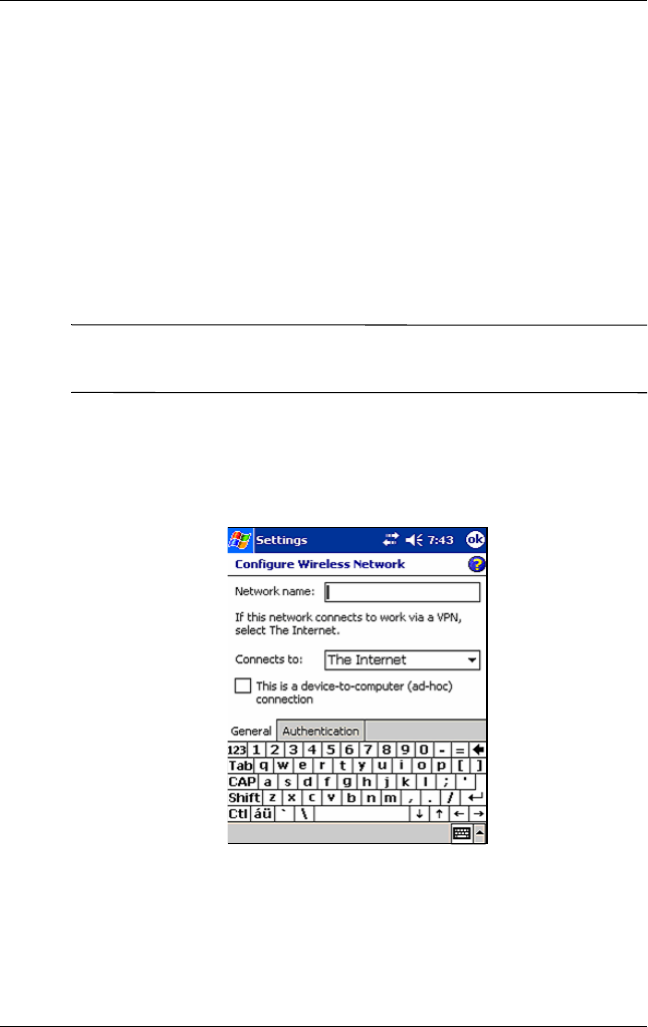
8VHU·V*XLGH ²
8VLQJ6HFXULW\)HDWXUHV
Learning to Enroll a Fingerprint
Fingerprint Reader enrollment training is available on the iPAQ
Pocket PC to assist you in proper enrollment of your unique
fingerprint. You can access the training in two ways:
■First time you open a Fingerprint screen
■Tap the Training button from one of the logon setup
fingerprint screens
To learn to enroll fingerprints:
✎You can tap OK at the top of the screen at anytime to exit the
training.
1. From the Today screen, tap Start > Settings > Password.
2. Select PIN OR fingerprint from the down arrow list to
access training.
3. Tap 4 digits in the PIN field.
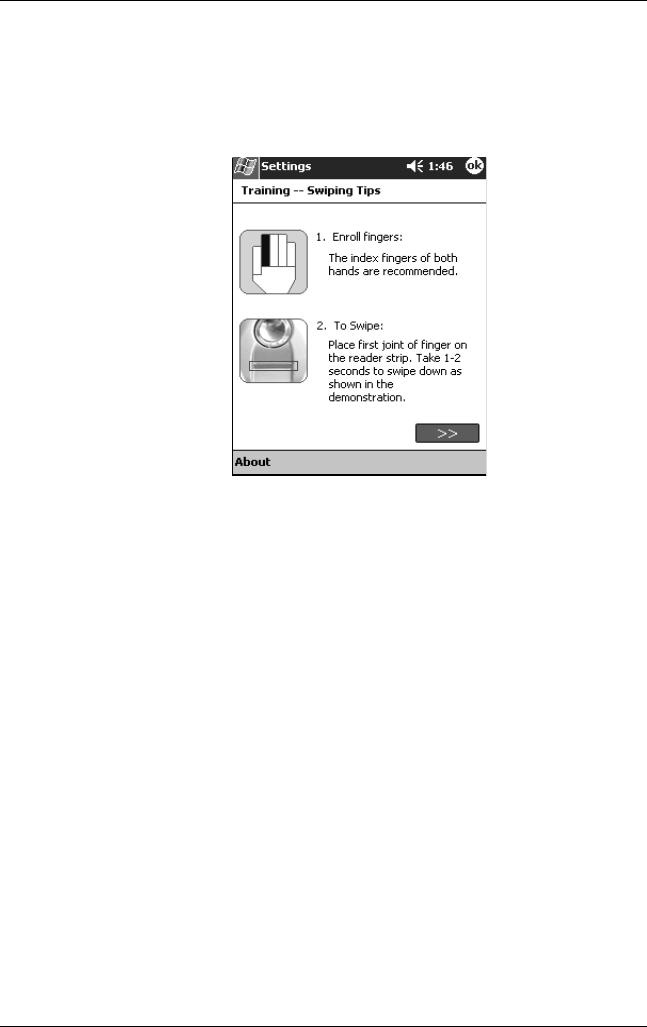
8VLQJ6HFXULW\)HDWXUHV
8VHU·V*XLGH ²
4. Tap OK or ENTR.
5. Tap the Training button to begin Fingerprint Reader
training.
6. Read the swiping tips.
7. Tap the double arrows button.
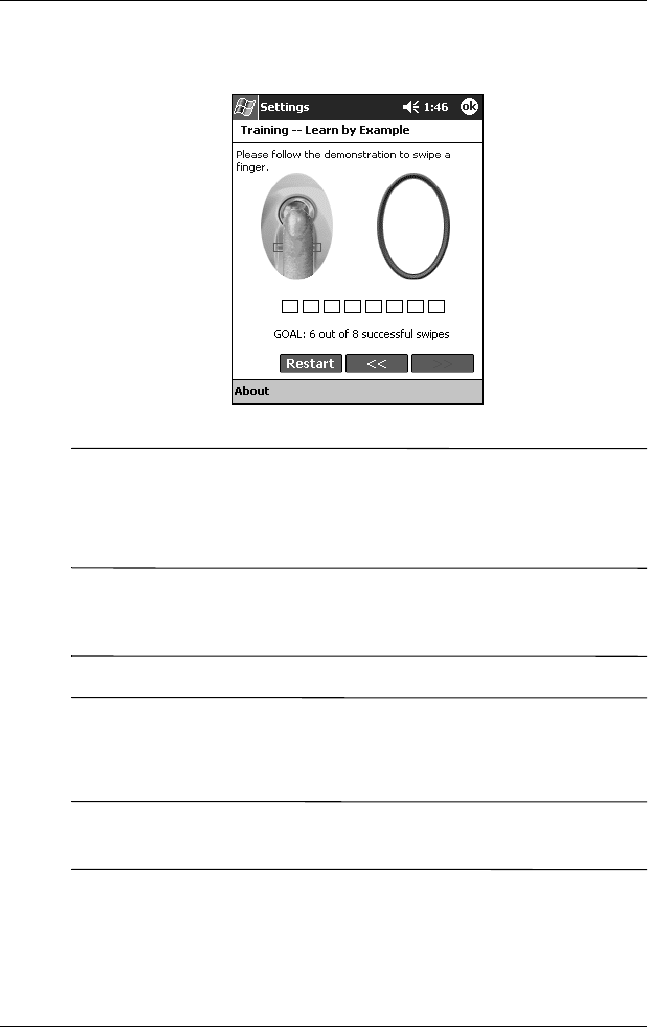
8VHU·V*XLGH ²
8VLQJ6HFXULW\)HDWXUHV
8. Follow the on-screen demonstration to swipe a finger.
✎If the finger swipe is acceptable, the oval frame turns green and
the message “Good. Please continue!” displays. If the finger
swipe is unacceptable, the oval frame turns red and the message
“Poor quality” or “No image. Try again!” displays.
9. Repeat the finger swiping exercise as prompted until you
have completed six out of eight successful swipes.
✎You must perform six acceptable swipes to continue the training.
10. Tap the double arrows button to continue the Self-test.
11. Perform eight finger swipes in the Self-test.
✎You must perform seven acceptable swipes to complete the
training.
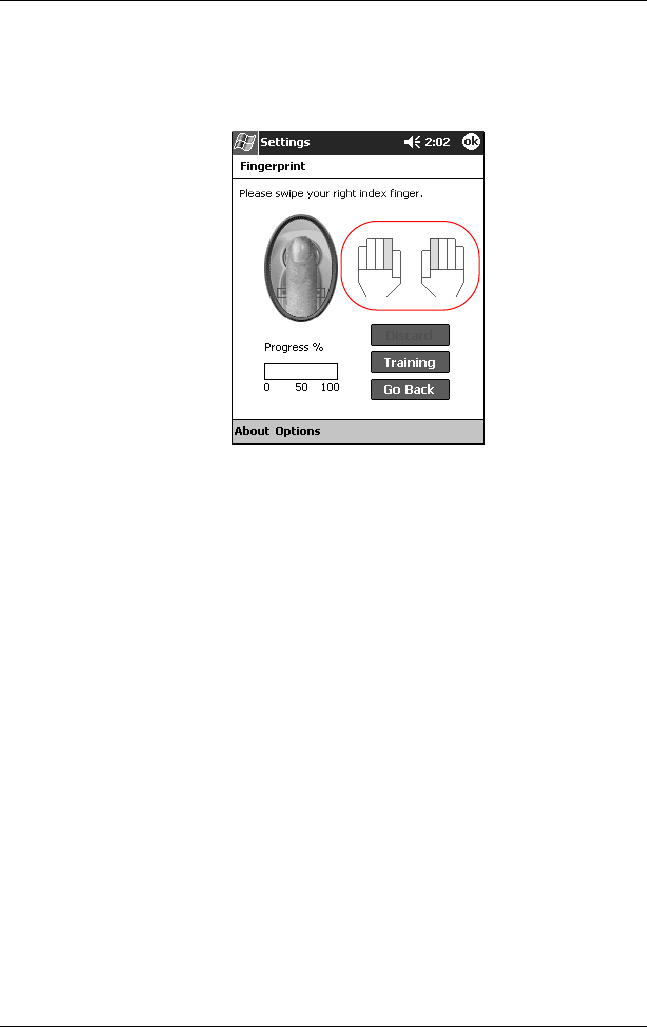
8VLQJ6HFXULW\)HDWXUHV
8VHU·V*XLGH ²
12. Tap Finish to end the training.
13. Tap OK to exit or tap a finger to enroll.
Working with Fingerprints
iPAQ Fingerprint Reader suggests fingers for you to use during
the swiping activity. You can select a different finger at any time.
It is recommended that you enroll at least two fingers (index
fingers are suggested). To enroll a fingerprint, you must take
between two and eight quality finger swipes.
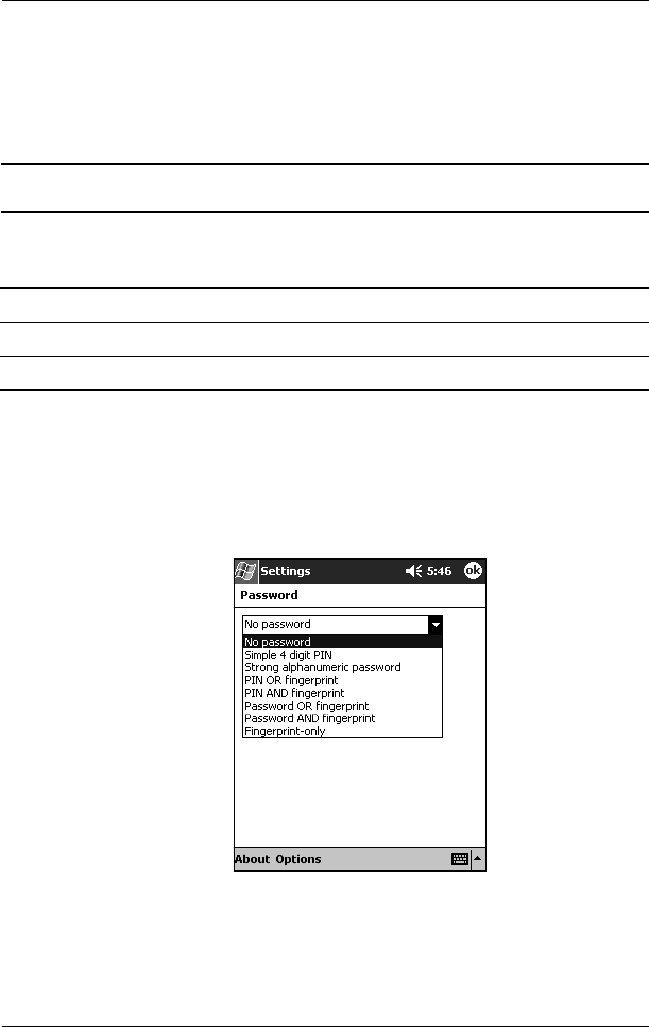
8VHU·V*XLGH ²
8VLQJ6HFXULW\)HDWXUHV
Enrolling a Fingerprint
The Fingerprint screen uses color coding to display the status of
your fingerprint swipe.
To enroll a fingerprint:
1. From the Today screen, tap Start > Settings > Password.
2. Select the option from the down arrow list that you choose
for your security setting.
3. Enter either your PIN or password, when prompted.
4. On the Fingerprint screen, tap the finger on the display you
want to enroll.
Fingerprint Status
If the color around the
oval is...
Then...
Blue No fingerprint has been taken for the finger.
Green The fingerprint swipe was good quality.
Red The fingerprint swipe was poor quality.
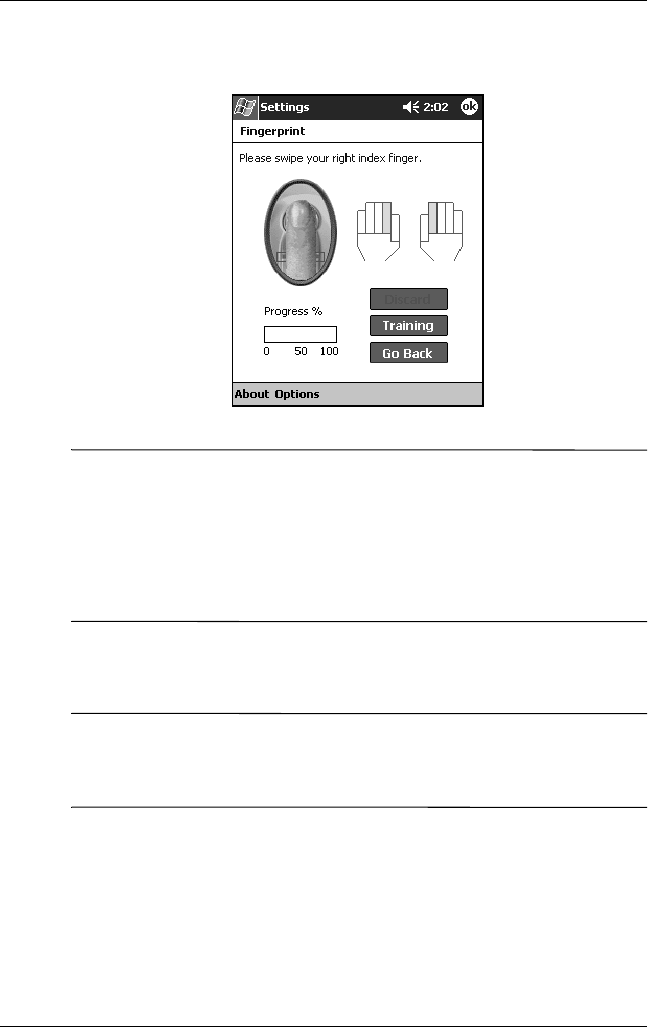
8VLQJ6HFXULW\)HDWXUHV
8VHU·V*XLGH ²
5. Swipe the selected finger, as instructed.
✎It is recommended that you gently swipe your finger downward
across the sensor. You should begin the swipe at the first joint of
your finger and continue downward with a smooth slow motion.
If you need additional assistance at any time, tap the Training
button.
6. Monitor the status to see if your fingerprint was correctly
swiped.
✎If OK, the perimeter of the oval turns green and a message
displays indicating the quality was good. If poor quality, the
perimeter of the oval turns red and a message displays.
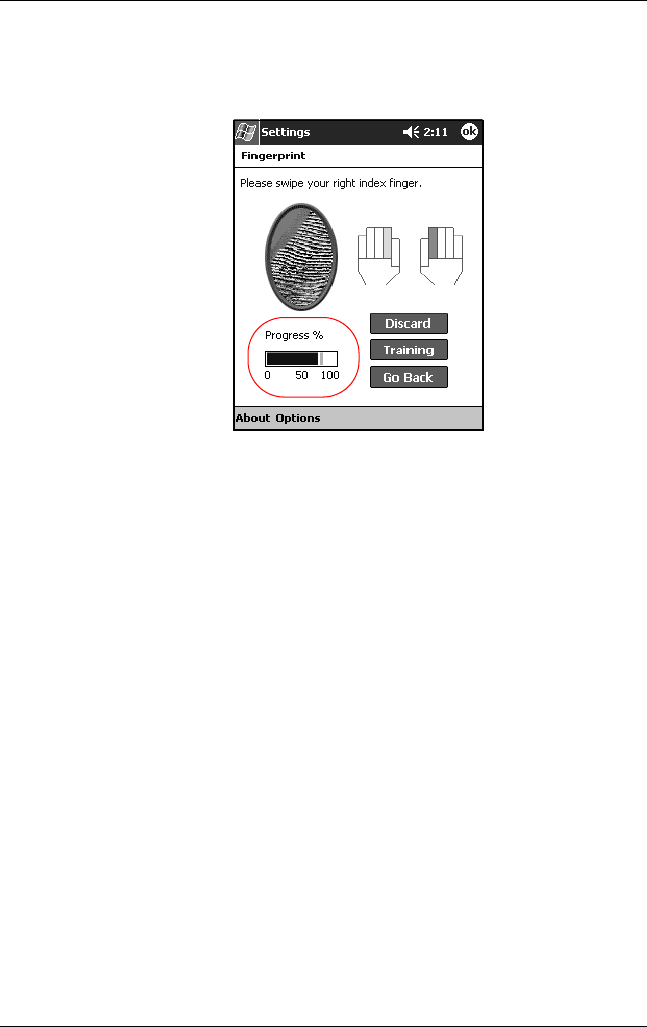
8VHU·V*XLGH ²
8VLQJ6HFXULW\)HDWXUHV
7. Repeat steps 5 and 6 to acquire a sufficient number of quality
swipes (notice the progress bar) to enroll the print.
8. Tap OK.
9. Tap Ye s .
Deleting a Fingerprint
You can delete any saved fingerprints.
1. From the Today screen, tap Start > Settings > Password.
2. Enter your PIN or swipe one of the enrolled fingers.
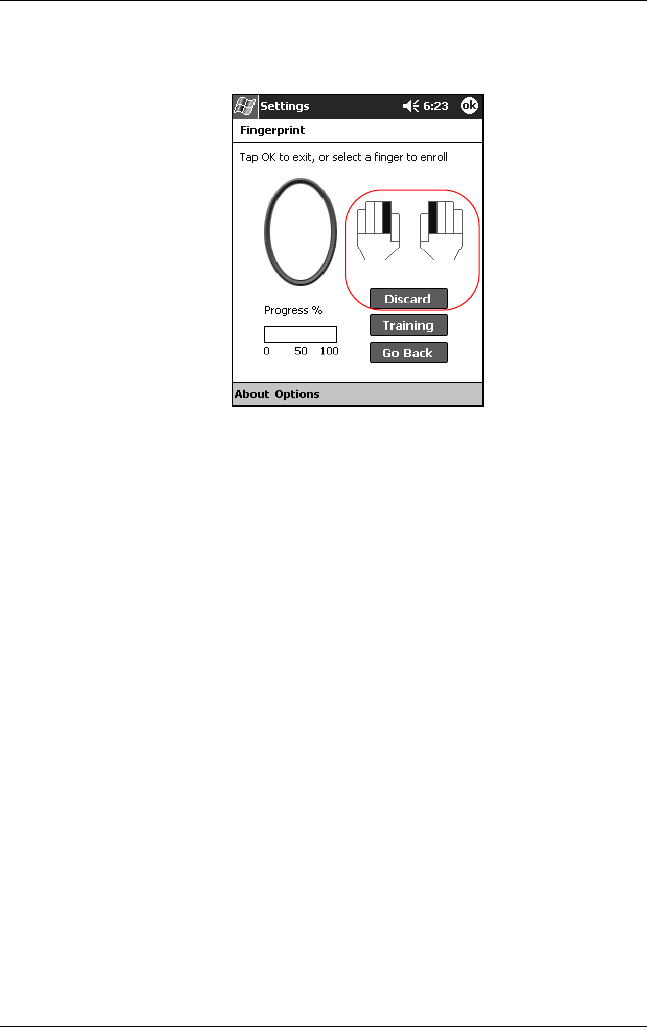
8VLQJ6HFXULW\)HDWXUHV
8VHU·V*XLGH ²
3. Tap the finger you want to delete, then tap Discard.
4. Tap Yes to confirm the deletion.
Setting Logon Passwords
You have a variety of options for setting logon passwords. You
can select:
■No password (default)
■4-digit PIN
■Alphanumeric password
■PIN or fingerprint
■PIN and fingerprint
■Alphanumeric password or fingerprint
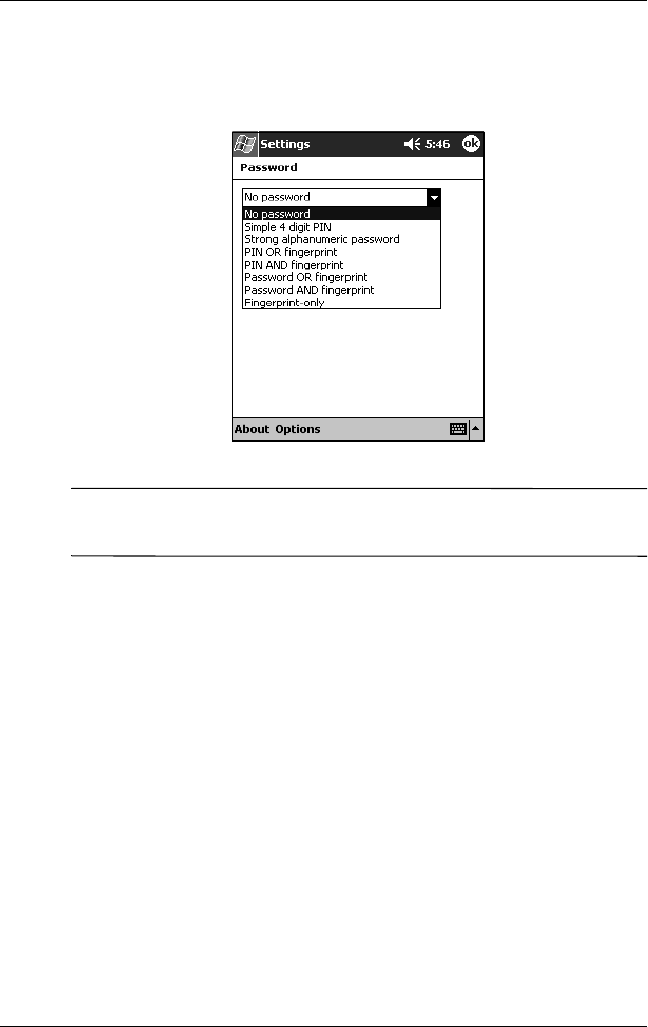
8VHU·V*XLGH ²
8VLQJ6HFXULW\)HDWXUHV
■Alphanumeric password and fingerprint
■Fingerprint only
✎If you are using ActiveSync, you must enter a password on your
personal computer to begin synchronization.
Setting “No password” for Logon
In this mode, you are not required to enter a PIN, password, or
fingerprint to logon.
1. From the Today screen, tap Start > Settings > Password.
2. Select “No password” from the down arrow list.
3. Tap OK.
4. Tap Ye s to save the changes.
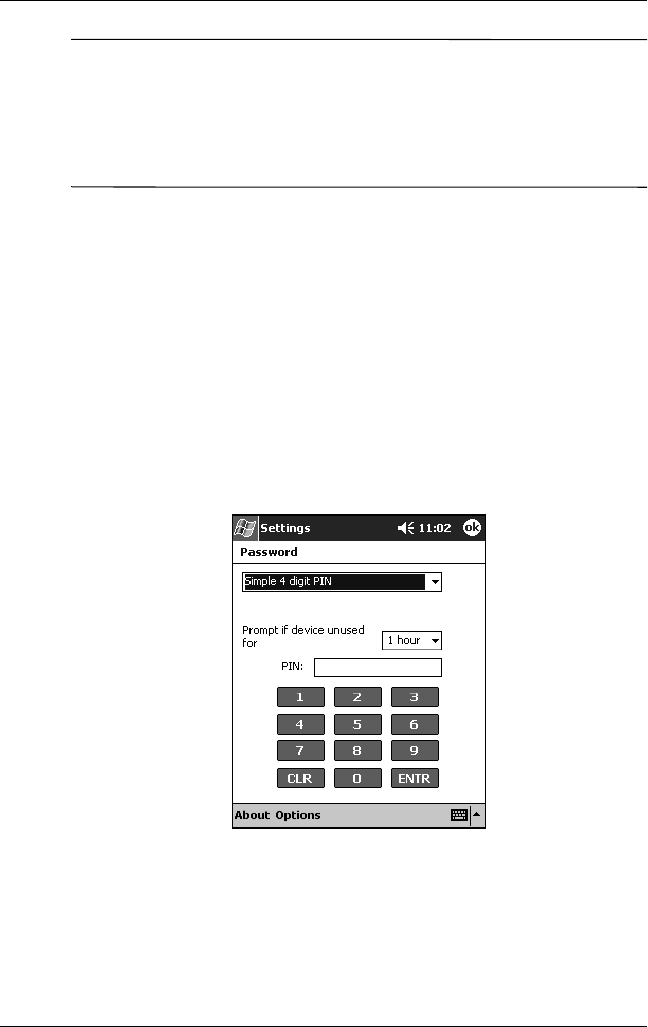
8VLQJ6HFXULW\)HDWXUHV
8VHU·V*XLGH ²
ÄCAUTION: In the event that an incorrect or unsuccessful PIN,
password, and/or fingerprint is repeatedly or incorrectly entered,
all data and applications stored in RAM are erased and the
iPAQ Pocket PC is returned to the as-shipped configuration. It is
recommended that you back up all data frequently when using the
security features.
Setting “Simple 4 digit PIN” for Logon
In this mode, you are required to enter a 4-digit PIN to logon.
1. From the Today screen, tap Start > Settings > Password.
2. Select “Simple 4 digit PIN” from the down arrow list.
3. Select from the down arrow list the length of time the
iPAQ Pocket PC can remain unused before you must reenter
the PIN.
4. Tap 4 digits in the PIN field.
5. Tap OK or ENTR.
6. Tap Ye s to save the changes.

8VHU·V*XLGH ²
8VLQJ6HFXULW\)HDWXUHV
Setting “Strong alphanumeric password” for Logon
In this mode, you are required to enter a strong password with
at least seven characters to logon. This password must contain a
combination of upper and lowercase letters, numerals, or
punctuation.
1. From the Today screen, tap Start > Settings > Password.
2. Select “Strong alphanumeric password” from the down
arrow list.
3. Select from the down arrow list the length of time the
iPAQ Pocket PC can remain unused before you must reenter
the password.
4. Enter seven alphanumeric characters in the Password field.
✎Your password must have at least seven characters and contain
both upper and lower case letters and numbers. You can use
punctuation marks.
5. Repeat step 4 in the Confirm field.
6. Tap OK.
7. Tap Ye s to save.
Setting “PIN OR fingerprint” for Logon
In this mode, you are required to enter a 4-digit PIN or fingerprint
to logon.
1. From the Today screen, tap Start > Settings > Password.
2. Select “PIN OR fingerprint” from the down arrow list.
3. Tap 4 digits in the PIN field.
4. Select from the down arrow list the length of time the
iPAQ Pocket PC can remain unused before you must reenter
the PIN.

8VLQJ6HFXULW\)HDWXUHV
8VHU·V*XLGH ²
5. Tap OK or ENTR.
6. Tap a finger to enroll.
7. Swipe the selected finger, as instructed.
✎For more information on finger swiping, see the section
“Enrolling a Fingerprint” or tap the Training button.
8. Tap OK.
9. Tap Ye s to save changes.
Setting “PIN AND fingerprint” for Logon
In this mode, you are required to enter both a PIN and a
fingerprint to logon.
1. From the Today screen, tap Start > Settings > Password.
2. Select “PIN AND fingerprint” from down arrow list.
3. Select from the down arrow list the length of time the
iPAQ Pocket PC can remain unused before you must reenter
the PIN.
4. Tap 4 digits in the PIN field.
5. Tap OK or ENTR.
6. Tap a finger to enroll.
7. Swipe the selected finger, as instructed.
✎For more information on finger swiping, see the section
“Enrolling a Fingerprint” or tap the Training button.
8. Tap OK.
9. Tap Ye s to save changes.

8VHU·V*XLGH ²
8VLQJ6HFXULW\)HDWXUHV
Setting “Password OR fingerprint” for Logon
In this mode, you are required to enter an alphanumeric password
with at least seven characters or a fingerprint to logon.
✎The alphanumeric password must contain a combination of upper
and lower case letters, numbers, and punctuation.
1. From the Today screen, tap Start > Settings > Password.
2. Select “Password OR fingerprint” from the down arrow list.
3. Select from the down arrow list the length of time the
iPAQ Pocket PC can remain unused before you must reenter
the password.
4. Enter seven alphanumeric characters in the Password field.
5. Repeat step 4 in the Confirm field.
6. Tap OK.
7. Tap a finger to enroll.
8. Swipe the selected finger, as instructed.
✎For more information on finger swiping, see the section
“Enrolling a Fingerprint” or tap the Training button.
9. Tap OK.
10. Tap Ye s to save changes.
Setting “Password AND Fingerprint” for Logon
In this mode, you are required to enter both a password with at
least seven characters and a fingerprint to logon.
✎The alphanumeric password must contain a combination of upper
and lower case letters, numbers, and punctuation.

8VLQJ6HFXULW\)HDWXUHV
8VHU·V*XLGH ²
1. From the Today screen, tap Start > Settings > Password.
2. Select “Password AND fingerprint” from down arrow list.
3. Select from the down arrow list the length of time the iPAQ
Pocket PC can remain unused before you must reenter the
password.
4. Enter seven alphanumeric characters in the Password field.
5. Repeat step 4 in the Confirm field.
6. Tap OK.
7. Tap a finger to enroll.
8. Swipe the selected finger, as instructed.
✎For more information on finger swiping, see the section
“Enrolling a Fingerprint” or tap the Training button.
9. Tap OK.
10. Tap Ye s to save changes.
Setting “Fingerprint-only” for Logon
In this mode, you are required to enter a successful fingerprint to
logon.
ÄCAUTION: In the event that an incorrect or unsuccessful fingerprint
is repeatedly or incorrectly entered, all data and applications stored
in RAM are erased and the iPAQ Pocket PC is returned to the
as-shipped configuration. It is recommended that you back up all
data frequently when using the security features.
1. From the Today screen, tap Start > Settings > Password.
2. Select “fingerprint-only” from the down arrow list.
✎If you are using ActiveSync, you must enter a password on your
personal computer to begin synchronization.

8VHU·V*XLGH ²
8VLQJ6HFXULW\)HDWXUHV
3. Tap the finger to enroll.
4. Swipe the selected finger as instructed.
✎For more information on finger swiping, see the section
“Enrolling a Fingerprint” or tap the Training button.
5. Tap OK.
6. Tap Ye s to save changes.
Logging On Using PIN, Passwords, and
Fingerprints
If you have set up a PIN, password, and/or fingerprint for logon,
you must enter the correct PIN, password, and/or successfully
swipe the correct fingerprint to use your iPAQ Pocket PC.
When you power on your iPAQ Pocket PC, you will be required
to enter your logon information on the PIN, Password and/or
Fingerprint screen.
ÄCAUTION: In the event that an incorrect or unsuccessful PIN,
password, and/or fingerprint is repeatedly or incorrectly entered, all
data and applications stored in RAM are erased and the iPAQ
Pocket PC is returned to the as-shipped configuration. It is
recommended that you back up all data frequently when using the
security features. The default number of attempts is six. You can
select the maximum number of attempts.
Logging On with No Password
You do not need to enter a password or fingerprint to use the
iPAQ Pocket PC.

8VLQJ6HFXULW\)HDWXUHV
8VHU·V*XLGH ²
Logging On Using a 4-digit PIN
You must enter the 4-digit PIN you entered during setup.
1. Turn on your iPAQ Pocket PC.
2. Tap your 4-digit PIN.
3. Tap OK or ENTR.
Logging On Using a Password
You must enter the alphanumeric password you entered
during setup.
1. Turn on your iPAQ Pocket PC.
2. Enter your password.
3. Tap OK or ENTR.
Logging On Using a PIN or Fingerprint
You must enter a PIN or swipe the fingerprint you entered during
setup. iPAQ Fingerprint Reader remembers your logon
preference.
The next time you logon, the PIN or Fingerprint window
corresponding to your last logon will be displayed.
1. Turn on your iPAQ Pocket PC.
2. Enter your 4-digit PIN or tap the Fingerprint tab to swipe
your enrolled finger.
✎If your fingerprint was of poor quality, iPAQ Fingerprint Reader
will ask you to swipe it again. If the quality was good, but there
was not a match, the message “No match” will be displayed.

8VHU·V*XLGH ²
8VLQJ6HFXULW\)HDWXUHV
Logging On Using a PIN and Fingerprint
You must enter both a PIN and swipe the fingerprint you entered
during setup.
1. Turn on your iPAQ Pocket PC.
2. Enter your 4-digit PIN.
3. Swipe your enrolled finger.
Logging On Using a Password or Fingerprint
You must enter a password or swipe the fingerprint you entered
during setup.
1. Turn on your iPAQ Pocket PC.
2. Enter your password or swipe your enrolled finger.
✎To type letters, numbers, or punctuation, tap the Keyboard
button at the bottom right corner of the screen. If you do not enter
the correct password, you will be prompted to try again.
3. Swipe your fingerprint if you did not enter your password.
Logging On Using a Password and Fingerprint
You must enter both a password and swipe the fingerprint you
entered during setup. iPAQ Fingerprint Reader remembers your
logon preference.
The next time you logon, the Password or Fingerprint screen
corresponding to your last logon will be displayed.
1. Turn on your iPAQ Pocket PC.
2. Enter your password.
✎If you do not enter the correct password, you will be prompted to
try again.

8VLQJ6HFXULW\)HDWXUHV
8VHU·V*XLGH ²
3. Tap OK.
4. Swipe your enrolled finger.
Logging On Using a Fingerprint Only
You must successfully swipe the fingerprint you entered
during setup.
ÄCAUTION: In the event that an incorrect or unsuccessful fingerprint
is repeatedly or incorrectly entered, all data and applications stored
in RAM are erased and the iPAQ Pocket PC is returned to the
as-shipped configuration. It is recommended that you back up all
data frequently when using the security features.The default number
of attempts is six. You can select the maximum number of attempts
for your security needs.
1. Turn on your iPAQ Pocket PC.
2. Swipe your enrolled finger.
Setting Security Options
You can set the Fingerprint Reader security on your iPAQ
Pocket PC to one of three levels:
■Regular (default)
■High
■Extra High
It is recommended that you use the Regular security setting.
ÄCAUTION: In the event that an incorrect or unsuccessful PIN,
password, and/or fingerprint is repeatedly or incorrectly entered,
all data and applications stored in RAM are erased and the iPAQ
Pocket PC is returned to the as-shipped configuration. It is
recommended that you back up all data frequently when using
the security features.
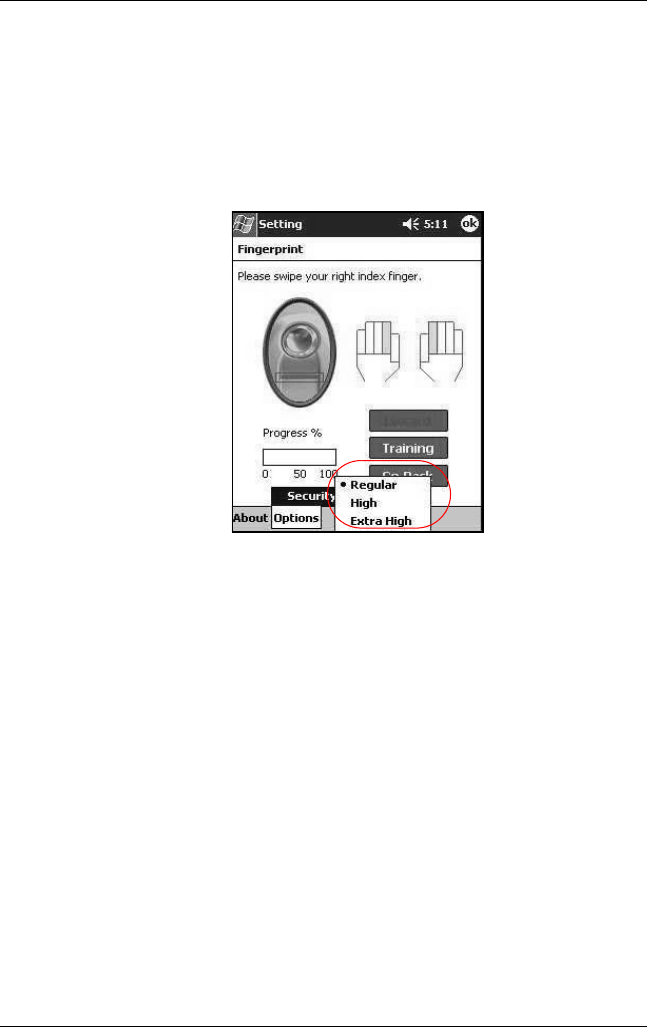
8VHU·V*XLGH ²
8VLQJ6HFXULW\)HDWXUHV
Setting the Security Level
1. From the Today screen, tap Start > Settings > Password.
2. In the Fingerprint screen, tap Options > Security Level.
3. Select your preferred security level.
4. Tap OK.
You can set the maximum number of attempts allowed for
logging on to your iPAQ Pocket PC.
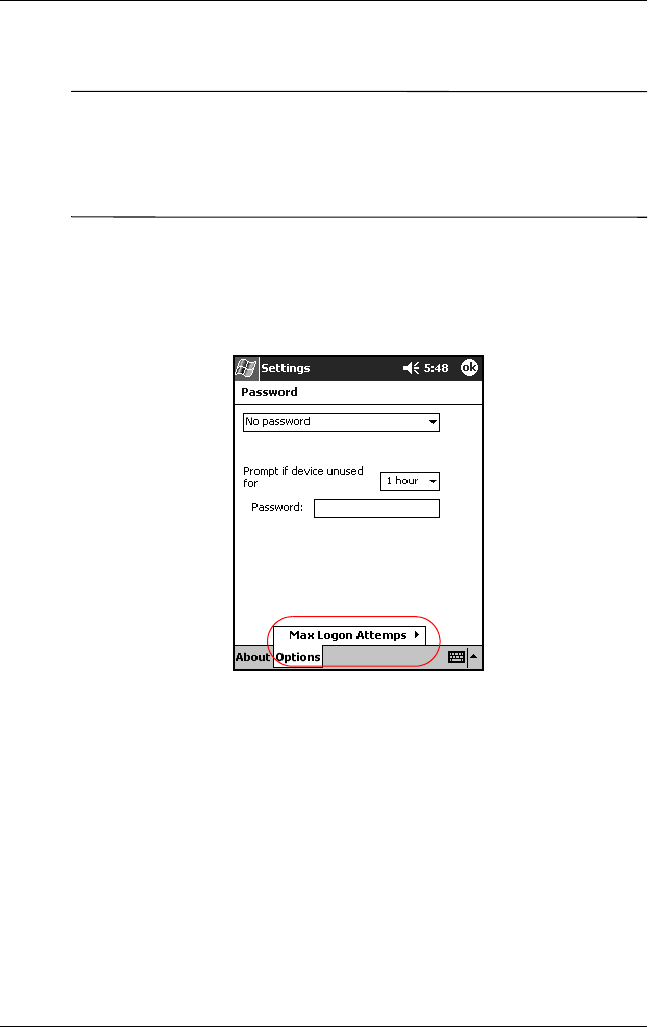
8VLQJ6HFXULW\)HDWXUHV
8VHU·V*XLGH ²
Setting the Maximum Number of Attempts
ÄCAUTION: It is important to consider the maximum number of
attempts. If you unsuccessfully enter your PIN, password, or
fingerprint the maximum number of attempts, you will lose all data
and applications in the RAM and your iPAQ Pocket PC will be
returned to an as-shipped configuration.
1. From the Today screen, tap Start > Settings > Password.
2. When using a PIN or password, tap Options > Max Logon
Attempts.
3. Select the maximum number of attempts.
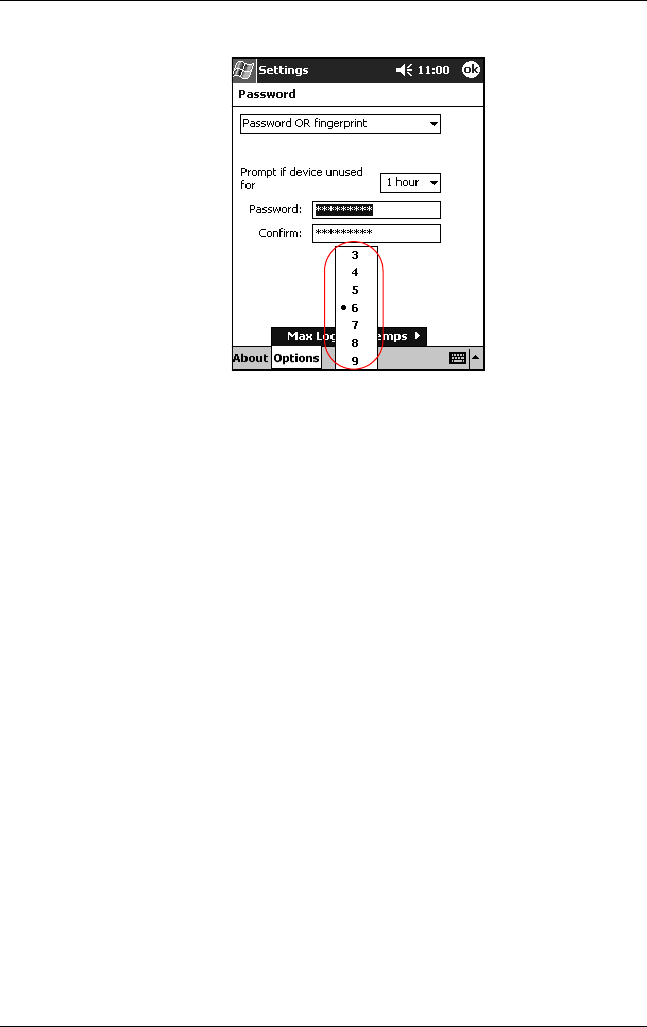
8VHU·V*XLGH ²
8VLQJ6HFXULW\)HDWXUHV
4. Tap OK.

8VHU·V*XLGH ²
7
Applications
Many applications come preinstalled on your new Pocket PC.
Listed below are a few of those applications. In this chapter we
discuss each application’s function and general use.
Note: For a complete list of the software preinstalled on your PC,
refer to Chapter 1, in section “Getting to Know Your iPAQ Pocket
PC.”
■DockWare
■iPAQ Image Zone
■iPAQ Backup
■Pocket Informant
■Pocket Panel Lite
■iTask
■HP ProtectTools
■HP Mobile Printing
Note: For more detailed information for using these programs,
refer to the Help files located on your iPAQ Pocket PC. To access
these Help files, from the Start menu, tap Programs > Help and
select a program.

8VHU·V*XLGH ²
$SSOLFDWLRQV
Installing Applications
To install more applications on your Pocket PC:
1. Use the HP iPAQ cradle to connect your Pocket PC to your
personal computer.
2. Follow the instructions in the Installation Wizard provided
with the program you want to install.
3. Check the screen on your Pocket PC to see if any further
steps are necessary to complete the program installation.
Removing Applications
To remove applications on your Pocket PC:
1. From the Start menu,tap Settings > System tab > Remove
Programs.
2. Select the checkbox for the programs you want to remove,
and then tap Remove.
Note: By removing any application from your Pocket PC, you
increase storage memory (used to store data and document files)
and program memory (used to run programs) on the unit.
Using DockWare
DockWare is a personalized desk clock, calendar, and screensaver
for your Pocket PC. You can select preinstalled pictures to be
used as a slideshow in the background or you can add your own
personal pictures.

$SSOLFDWLRQV
8VHU·V*XLGH ²
Starting DockWare
The DockWare program settings are turned on by default on your
Pocket PC. After 5 minutes of inactivity, the screen goes into
“DockWare” mode. The software displays the current calendar
and a large display of the current time along with running a
slideshow of pictures in the background.
Also, you can start DockWare immediately by tapping on Start >
Programs >DockWare icon. Using the stylus, tap and hold
anywhere on the screen to view the DockWare options.
Stopping DockWare
The application stops as soon as you touch the screen or push any
button on the Pocket PC, with the exception of scrolling up or
down to view a picture. Also, DockWare stops running if an
alarm or any other popup window appears.
Be aware of the following:
■If your Pocket PC is running on battery power, this
application does not automatically start.
■If DockWare is running and you take your Pocket PC out of
the cradle, the application continues to run on battery power
until you stop it.
To disable DockWare, tap and hold anywhere on the screen, and
then uncheck Starts Automatically from the popup menu. This
menu item acts as a toggle switch to start and stop the DockWare
software program. Therefore, if you want to start DockWare
again you need to select this option again.

8VHU·V*XLGH ²
$SSOLFDWLRQV
Adding Pictures
DockWare comes with preinstalled pictures which can be found
in the \My Documents\My Pictures folder. To add your own
pictures to display:
1. Connect your Pocket PC to the desktop PC where the pictures
are located.
2. Run ActiveSync to synchronize both computers. Refer to
Chapter 2, “Synchronizing with Your Computer,” for
instructions on running ActiveSync.
3. Go to Start > Explore > Mobile Device and open the Mobile
Device window.
4. Open the folder found under \My Documents\My Pictures.
5. Copy your pictures to this location.
Note: DockWare lists bitmap files with the .bmp extension and
lists JPEG files with either the .jpg or .jpeg extension.
Note: For more information on using DockWare, tap Start >
Programs > DockWare > Help.
Using iPAQ Image Zone
When you use iPAQ Image Zone you can review and share
images from your iPAQ Pocket PC. Also, you can print, send,
record and e-mail images directly from your Pocket PC, or create
slideshows to share your pictures with friends and family.
Viewing Pictures
1. From the Start menu, tap Programs > iPAQ Image Zone.
Note: The viewer opens in Browse mode by default. Browse mode
displays thumbnail view of the pictures in the current folder.

$SSOLFDWLRQV
8VHU·V*XLGH ²
2. Tap a thumbnail to select the picture. A preview of the picture
and information about it is displayed.
To view images in a different folder:
1. Tap File > Change Folder.
2. Select the desired folder.
3. Tap OK.
Viewing a Picture Full-Screen
To view a picture full-screen, and to be able to zoom in or out:
1. Select the picture by tapping on it thumbnail.
2. Tap View > Image, or tap on the preview window.
3. Zoom in or out using the toolbar buttons. If the picture is too
large to fit on the screen, you can display other parts of the
picture by dragging the stylus on the screen, or by using the
Navigation buttons.
Recording Sound With a Picture
You can record sound for each picture. When the picture is
displayed, the associated sound is played. Pictures with sound
have a speaker icon in their thumbnails.
To add sound to a picture:
1. Select the picture by tapping on its thumbnail.
2. Tap the Cassette icon on the menu bar.
3. Tap the Record button on the Recording toolbar.
4. Speak into the microphone or record the sound.
5. Tap the Stop button on the Recording toolbar.
To change audio options:
1. Tap File > Options > Audio tab.
2. Select your audio options.
3. Tap OK.

8VHU·V*XLGH ²
$SSOLFDWLRQV
Viewing a Slideshow
You can view a slideshow of the images in the current folder. To
start the slideshow, tap View > Slideshow.
During the slideshow, tap anywhere on the screen to display the
on-screen controls which you can use to move forward or
backward through the slides, or to end the slideshow. You can
also use the Navigation buttons to move forward or backward
through the slides.
You can control display options such as:
■Sequence
■Delay
■Rotation
■Transition Effect
To change slideshow settings:
1. Tap File > Options > Slideshow tab.
2. Select the settings and effects you want to use in your
slideshow.
3. Tap OK.
Printing Pictures
You can print pictures from iPAQ Image Zone if HP Mobile
Printing has been installed from the Companion CD.
To print a picture:
1. Select the picture to be printed by tapping on its thumbnail.
2. Tap File > Print.
Note: For more information on using iPAQ Image Zone, tap
Start > Programs > iPAQ Image Zone > Help.

$SSOLFDWLRQV
8VHU·V*XLGH ²
E-mailing Pictures
Using iPAQ Image Zone, you can e-mail pictures to all of your
family and friends. To send pictures as e-mail attachments:
1. From the Start menu, tap Programs > iPAQ Image Zone.
2. Tap the e-mail icon located at the bottom of the screen.
3. Tap E-mail Attachment, and then Next.
4. Enter the e-mail address, and then tap Send.
Note: Instant Share is not supported on the HP iPAQ hx4700
series Pocket PC.
Using iPAQ Backup to Backup/Restore
Use iPAQ Backup or Microsoft ActiveSync Backup to back up
and restore information on your iPAQ Pocket PC.
Note: Your iPAQ Pocket PC came preinstalled with iPAQ Backup.
However, you must install ActiveSync on your computer before
using ActiveSync Backup.
To help reduce the chance of losing information, you should back
up information on a regular schedule.
iPAQ Backup saves your data in a backup file. You can designate
a file name and a location for the file to be saved. iPAQ Backup
performs a back up to a memory card, main memory, or the iPAQ
File Store folder. Close all programs on your iPAQ Pocket PC
before backing up or restoring your information.
CAUTION: Restoring your information replaces the current information
on your iPAQ Pocket PC with the information saved in your backup.

8VHU·V*XLGH ²
$SSOLFDWLRQV
To backup/restore using iPAQ Backup:
1. From the Start menu, tap or tap Programs > iPAQ
Backup.
2. Tap the Backup tab or the Restore tab.
3. Select the files and folders to be backed up or restored.
4. Select file location for backed-up data.
5. Set backup or restore options and press OK.
6. Press the Backup or Restore button, and then press the Start
button on the next screen.
Using ActiveSync To Backup/Restore
Close all programs on your iPAQ Pocket PC before backing up or
restoring your information.
ÄCAUTION: Restoring your information replaces the current information
on your iPAQ Pocket PC with the information saved in your backup.
To backup/restore using ActiveSync:
1. Connect the iPAQ Pocket PC to your computer.
2. From your computer, open Microsoft ActiveSync.
3. From the Start menu, tap Programs >
Microsoft ActiveSync.
4. From the Tools menu, click Backup/Restore.
5. Click the Backup or Restore tab, and select your options.
6. Click Backup Now or Restore Now.

$SSOLFDWLRQV
8VHU·V*XLGH ²
Using Pocket Informant
Pocket Informant (PI) is a complete utility for managing your
appointments and tasks. It enhances your built-in Contacts,
Calendar, and Tasks applications with more powerful tools on
your Pocket PC, while still allowing you to synchronize with
ActiveSync.
Note: Pocket Informant is turned on by default the first time you
use your Pocket PC.
If you do not want to use Pocket Informant:
1. From the Start menu, tap Programs > Pocket Informant.
2. Tap the Support menu, and then Support > Override System
PIM Shortcuts.
Note: Once you have selected to turn off Pocket Informant, you
must perform a soft reset for the change to take effect.
Pocket Informant Toolbar
The five main components that are available on the Toolbar, just
above the Command bar, are Calendar, Notes, Tasks, Contacts,
and Search.
Component Function
Calendar A scheduling feature fully integrated with contacts
and other features. You can view the calendar by the
agenda, day, week, or month.
Notes A written or recorded reminder (memo) to yourself.
Tasks A personal or work-related errand (or job) you want to
track through completion. A task can occur once or
repeatedly (a recurring task).

8VHU·V*XLGH ²
$SSOLFDWLRQV
Menus and Options
Pocket Informant provides the following menus and options
located at the bottom of the screen:
■New button enters new or edit existing data.
■Support menu changes color schemes, view options, take
screenshots, import/export calendars, manage your PI data,
and turn on the infrared beam to exchange data.
■Go to Today button goes directly to the current date in the
calendar view.
■Toolbar button provides the option of changing between
three possible toolbars: Filter, New Entry, or ABC (used for
Contacts) located at the top of the screen.
■Calendar Preferences menu -- used to switch calendar views
such as the Agenda, Day, Week, or Month View or any other
frequently changed options.
Note: For more information on Pocket Informant, tap Start >
Programs > Help on your Pocket PC or go to the more extensive
help file located on the Companion CD.
Contacts A list of people, inside or outside of your organization,
about whom you can save several types of
information, such as street and e-mail addresses,
telephone and fax numbers, etc.
Search A comprehensive filter which provides wildcard
support, date spans (duration), and specific category
filter support.
Component Function
(Continued)

$SSOLFDWLRQV
8VHU·V*XLGH ²
Using Pocket Panel Lite
This feature allows you to manage battery power and adjust the
Pocket PC backlight. Pocket Panel Lite displays on the Today
screen for easy accessibility. In addition to using the Today screen
shortcut (plug-in), you can access the Pocket Panel Lite
application by selecting the Start menu, then tap Programs >
Pocket Panel Lite.
Note: For more information on Pocket Panel Lite, tap Start >
Programs > Help <?> on your Pocket PC. <Where does the user
go for more information?> It’s not in EVT v41.
Using iTask
The iTask application, sometimes called iPAQ Task Manager,
allows you to quickly access the most frequently used features on
your iPAQ Pocket PC.
From iTask you can manage tasks that are already running,
launch new programs, and more. Each task that is currently
running on the Pocket PC shows up in a list.
Tap on a task to bring the current program into the foreground or
tap and hold to bring up the Task Menu.
To start iTask, from the Start menu, tap Programs > iTask.
HP ProtectTools
This security application comes preinstalled on your Pocket PC
and offers on-device security protection with the use of
encrypting passwords and data. For more information on the
security application, encrypting data and creating vaults, refer to
Chapter 6, “Using Security Features.”

8VHU·V*XLGH ²
$SSOLFDWLRQV
HP Mobile Printing
HP Mobile Printing enables you to print directly from your
Pocket PC to Bluetooth, infrared, and network printers. For
complete setup and installation instructions, refer to HP Mobile
Printing located on the Companion CD.

$SSOLFDWLRQV
8VHU·V*XLGH ²

8VHU·V*XLGH ²
8
Using Wi-Fi
<Exact settings and user interface subject to change. More
information to come.>
Getting Acquainted
With wireless access, you do not need to use cables to connect
your HP iPAQ to the Internet. Instead, access points transmit data
to and from your wireless device. Your HP iPAQ can connect to
an 802.11b WLAN or connect directly to other WLAN-enabled
devices. With Wi-Fi, you can:
■Access the Internet
■Send and receive e-mail
■Access corporate network information
■Use virtual private networks (VPNs) for secure remote access
■Use hotspots for wireless connectivity
Note: Use of dial-up and wireless Internet, e-mail, corporate
networks, and other wireless communications, such as
Bluetooth-enabled devices, may require separately purchased
additional hardware and other compatible equipment, in addition
to a standard Wi-Fi infrastructure and a separately purchased
service contract. Check with your service provider for availability
and coverage in your area. Not all web content may be available.
Some web content may require installation of additional software.

8VLQJ:L)L
8VHU·V*XLGH ²
Getting Started with Wi-Fi
Use this section to learn how to use Wi-Fi, automatically connect
to a network, manually enter new network settings, and search for
networks.
Powering Wi-Fi On or Off
To use Wi-Fi on your HP iPAQ, you need to turn on Wi-Fi and
set up your device.
Note: The Wi-Fi antenna for the HP iPAQ is located in the top of
the unit. If you cover up the top of the HP iPAQ after you have
turned on Wi-Fi, signal strength diminishes.
To turn the Wi-Fi on or off:
1. From the Today screen, tap the iPAQ Wireless icon () in
the Command bar located at the bottom of the screen.
2. Tap the Wi-Fi button.
When Wi-Fi is powered on, the Wi-Fi icon on the iPAQ
Wireless screen turns from gray to to amber to green and the
Wi-Fi light-emitting diode (LED), located on the top left
corner of the unit, is solid blue indicating one or more radios
are on.
Note: Even though the indicator is blue to indicate Wi-Fi is turned
on, it does not necessarily mean a connection has been
established with another device or access point.
If Wi-Fi is off, the Wi-Fi icon turns from green to gray.

8VHU·V*XLGH ²
8VLQJ:L)L
Battery Saving Tip: Turn Wi-Fi off when you are not using it.
When Wi-Fi is on, be sure one of the Wi-Fi power saving
modes is selected. Refer to “Changing Wi-Fi Power Saving
Modes” in Chapter 3, “Managing the Battery” for more
information.
Note: Some Access Points and networks do not support one or
more of the power saving modes that are available. If you cannot
connect with a particular wireless network, try turning off the
Wi-Fi Power Save modes.
Automatically Connecting to a Network
1. If one or more broadcast networks are present, the Network
Indicator icon ( ) appears in the Navigation bar. Tap the
network you want to connect to, and then tap whether the
network connects to the Internet (does not use proxy settings)
or Work (uses proxy settings).
2. If you are prompted for a Network Key (WEP), enter it and
tap Connect. If you are not sure, contact your network
administrator.
Manually Entering New Network Settings
A wireless network can be added either when the network
is detected (the Network Indicator icon is showing in the
Navigation bar) or manually by entering setting information.
To manually add a wireless network:
1. Be sure Wi-Fi is on.
2. Tap the Connections icon ( or ) > Settings >
Advanced tab > Select Networks button.
3. Enter or select the network name (or tap New) you want to
use to either connect to the Internet using an ISP or a Virtual
Private Network (VPN) for work. Tap OK once completed.
4. Set up your Dialing Rules and Exceptions and press OK.

8VLQJ:L)L
8VHU·V*XLGH ²
The next step is to setup your network interface cards.
5. From the iPAQ Wireless screen, tap > Settings.
6. Select Add New ... in the list box on the General tab to start
configuring wireless networks.
Note: If a network was detected in step 3, the SSID is
automatically entered and cannot be changed.
7. Enter a SSID into the Network Name box.
8. In the Connects to: box, select where your network connects
to (The Internet or Work).
9. If you want to connect to an ad-hoc connection, tap the This
is a device-to-device (ad-hoc) connection checkbox.
10. If authentication information is needed, from the Configure
Wireless Network screen, tap the Network Key tab.
Note: To determine whether authentication information is needed,
see your network administrator.
11. To configure the type of network authentication to use, select:
a. To use Shared Key authentication, tap the
Authentication (Shared mode) listbox. Type the
network key in the Network Key: box.
b. To use data encryption, tap the Data encryption
(WEP enabled) listbox.
c. If a network key is provided by your network
automatically, tap the The Key is provided for
me automatically checkbox.
12. For increased security, tap 802.1x tab and select the Use
IEEE802.1x network access control checkbox. You should
only check this option if it is supported by your network
environment. Ask your network administrator if you are
unsure.

8VHU·V*XLGH ²
8VLQJ:L)L
13. Select EAP type (PEAP or Smart Card/Certificate) from the
listbox.
14. Once you have completed entering the network settings, tap
OK and OK again to exit this menu.
Searching for Networks to Access
Networks that you have already configured are preferred
networks and can be found on the iPAQ Wireless screen >
Settings > Wireless Networks list box. You can choose whether
to connect only to preferred networks or to have your HP iPAQ
search for and connect to any available network (preferred or
not).
1. From the iPAQ Wireless screen, tap > Settings > Wireless
tab.
2. In the Networks to access box, tap the type of network you
want to connect to (All Available, Only access points, or
Only computer-to-computer).
3. To connect only to networks that have already been
configured, clear the Automatically connect to
non-preferred networks checkbox.
Note: If you check the Automatically connect to non-preferred
networks checkbox, your HP iPAQ detects any new networks
and provides you the opportunity to configure them.
Managing Wireless Network Settings
In managing your wireless networks, sometimes it is necessary to
change network settings. In the next two sections, learn how to
view, edit and delete available wireless network settings.

8VLQJ:L)L
8VHU·V*XLGH ²
Viewing or Editing a Wireless Network
To view or edit an existing or available wireless network:
1. Be sure Wi-Fi is on.
2. From the iPAQ Wireless screen, tap > Settings > Wireless
tab.
3. In the Wireless networks box, tap the desired network name.
4. Edit the existing settings as necessary, and then tap OK to
save the changes.
Deleting a Wireless Network
To delete an existing or available wireless network:
1. Be sure Wi-Fi is powered on.
2. From the iPAQ Wireless screen, tap > Settings > Wireless
tab.
3. In the Wireless networks box, tap and hold the network you
want to delete.
4. Tap Remove Settings.
Monitoring Signal Strength and Status
To view the signal strength between your HP iPAQ and an access
point Wi-Fi connection:
1. Tap the Connections icon ( or ) >in the Navigation bar.
2. When the Connectivity box displays, you will be able to
view the type of network the HP iPAQ is connected to (for
example, Work or Internet) and an icon displaying the signal
strength.
Note: The Signal Strength icon will not be displayed if a
connection is not present.

8VHU·V*XLGH ²
8VLQJ:L)L
3. To make changes to the connection settings, tap Settings.
4. To exit the Connectivity box, tap the Hide button.
Advanced Network Settings
Use the next few sections to learn how to set up and change
network configuration settings so your HP iPAQ can
communicate with other networks.
Advanced Wi-Fi Terms
It is recommended that you become familiar with the following
terms as you begin to use Wi-Fi technology.
Term Definition
Encryption (WEP) or
IEEE 802.1X
A set of security services used to protect
802.11 networks from unauthorized
access.
Device-to-computer or
ad-hoc
The mode that does not use access points.
It is used in peer-to-peer network
communications.
Domain Name System
(DNS)
The way that Internet domain names are
located and translated into IP addresses. It
is an easy to remember name for an
Internet address. (For example,
www.horseshow.com instead of the IP
address: xxx.xxx.xxx.xxx).
Hotspots Public or private areas where there is a
wireless access point available. This
wireless connection could be located, for
example, at a library or cyber cafe.
Infrastructure This connection mode uses wireless
access points to connect to networks.
Internet Protocol (IP)
Address
A number that identifies each sender or
receiver of information (sent in packets)
across the Internet.

8VLQJ:L)L
8VHU·V*XLGH ²
Looking Up an IP Address
To find the IP address the wireless network is using:
1. Be sure Wi-Fi is on.
2. Connect to a network by tapping the Connections icon (
or ) > Settings > Advanced tab > Select Networks
button.
If you have already connected to a network, skip to step 5.
3. Select the network name you want to use to either connect to
the Internet using an ISP or a Virtual Private Network (VPN)
for work. If you need to change or create a new network
management name, tap the Edit... or New... button. Tap OK
once you have completed this step.
4. From the Connections screen, set up your Dialing Rules and
Exceptions and press OK.
5. From the iPAQ Wireless screen, tap the Wi-Fi Settings
button > Network Adapters tab.
6. Tap the appropriate adapter to modify the settings. The IP
address appears in the IP Address box.
SSID or Network Name SSID is the acronym for the service set
identifier. This identification number uses a
maximum number of 32 characters and is
case sensitive.
Transmission Control
Protocol/ Internet
Protocol
The basic communication language
(protocol) of the Internet.
Wireless Access Point The access point provides a wireless
connection to a network (additional
hardware).
Windows Internet
Naming Service
(WINS)
A way of managing the association of
workstation names and locations with IP
addresses.
Term Definition
(Continued)

8VHU·V*XLGH ²
8VLQJ:L)L
Changing TCP/IP Settings
Note: Most Internet Service Providers (ISPs) and private
networks now use dynamically-assigned IP addresses. You will
not need to change the Transmission Control Protocol/Internet
Protocol (TCP/IP) settings unless your ISP or private network
does not use dynamically-assigned IP addresses. If you are not
sure if your ISP or private network use dynamically-assigned IP
addresses, check with your network administrator.
To change TCP/IP Settings:
1. Contact your ISP or network administrator to determine your
IP address, subnet mask, and/or default gateway (if needed).
2. Be sure Wi-Fi is on.
3. From the iPAQ Wireless screen, tap > Settings > Network
Adapters tab.
4. In the My network card connects to... dropdown box, tap
either The Internet or Work.
Note: If you are connecting to your ISP at home, tap The
Internet. If you are connecting to a private network, such as a
corporate network at work, tap Work.
5. In the Tap an adapter to modify settings box, tap HP iPAQ
Wi-Fi Adapter.
6. Tap the IP Address tab.
7. Tap Use specific IP address and enter the requested
information.
8. Tap OK to save your settings.

8VLQJ:L)L
8VHU·V*XLGH ²
Changing DNS and WINS Settings
Note: Most Internet Service Providers (ISPs) and private
networks now use dynamically-assigned IP addresses. You will
not need to change Domain Name System (DNS) and Windows
Internet Naming Service (WINS) settings unless your ISP or
private network does not use dynamically-assigned IP addresses.
If you are not sure, check with your network administrator.
Servers that require an assigned IP address may also require a
way to map computer names to IP addresses. Your HP iPAQ
supports two name resolution options:
■DNS
■WINS
To change server settings:
1. Contact your ISP or network administrator to determine
which name resolution to use, obtain the specific server
address, and determine whether alternate addresses are
available.
Note: An alternate address may enable you to connect when the
primary server is unavailable.
2. Be sure the Wi-Fi is on.
3. From the iPAQ Wireless screen, tap > Settings > Network
Adapters tab.
4. In the My network card connects to... dropdown box, tap
either The Internet or Work.
Note: If you are connecting to your ISP at home, tap The
Internet. If you are connecting to a private network such as a
corporate network at work, you should tap Work.
5. In the Tap an adapter to modify settings box, tap HP iPAQ
Wi-Fi Adapter.

8VHU·V*XLGH ²
8VLQJ:L)L
6. Tap the Name Servers tab and enter the requested
information.
7. Tap OK to save your settings.
Setting Up VPN Server Connections
A VPN connection enables you to securely connect to servers,
such as a corporate network, via the Internet. To set up a VPN
server connection:
1. Contact your network administrator for your user name,
password, domain name, TCP/IP settings, and host name
or IP address of the VPN server.
2. Tap the Connections icon ( or ) in the Navigation bar >
Settings >Task tab on the Connections screen.
3. Under My Work Network, tap Add a new VPN server
connection.
4. Follow the instructions on the Make New Connection
screen.
Note: For online Help for any screen in the New Connection
wizard or while changing settings, tap the ?.
Changing VPN Server Connections
1. Be sure Wi-Fi is on.
2. Tap the Connections icon ( or ) >in the Navigation bar,
and then Settings >Task tab.
3. Under My Work Network, tap Manage existing
connections > VPN tab.
4. Tap the VPN connection you want to change, and then tap
Edit.
5. In the Name box, enter new name for the connection (for
example, your company’s name).

8VLQJ:L)L
8VHU·V*XLGH ²
6. In the Host name/IP box, enter the VPN server name or
IP address.
7. Next to VPN type, tap the type of authentication to use with
your device (IPSec/L2TP or PPTP). If you aren’t sure
which option to choose, ask your network administrator.
8. Tap Next.
9. If you selected IPSec/L2TP on the previous screen, tap the
type of authentication. If you select A pre-shared key, enter
the key provided by your network administrator, and then tap
Next.
Note: If you selected PPTP in the previous screen, this step is
skipped.
10. Enter the user name, password, and domain name provided
by your network administrator.
Note: If a domain name was not provided, you may be able to
connect without entering one.
11. To change advanced settings, tap the Advanced button.
Note: You will not need to change advanced settings unless:
■The server to which you are connecting does not use
dynamically-assigned IP addresses and you need to enter
your TCP/IP settings,
or
■You need to change server DNS or WINS settings.
12. Tap the Finish button to save the changes.
Starting VPN Server Connections
To start a connection through a VPN server, be sure Wi-Fi is
powered on, and then select the VPN network. Your HP iPAQ
will automatically begin connecting.

8VHU·V*XLGH ²
8VLQJ:L)L
Setting Up Proxy Server Settings
If you are connected to your ISP or private network during
synchronization, your HP iPAQ should download proper proxy
settings from your computer. If these settings are not on your
computer or need to be changed, you will need to set them up
manually. To set up proxy server settings:
1. Contact your ISP or network administrator for the proxy
server name, server type, port, type of Socks protocol used,
and your user name and password.
2. Be sure Wi-Fi is on.
3. Tap the Connections icon ( or ) >in the Navigation bar,
and then Settings >Task tab.
4. Under My Work Network, tap Edit my proxy server >
Proxy Settings tab.
5. Tap the This network connects to the Internet and This
network uses a proxy server to connect to the Internet
checkboxes.
6. In the Proxy server box, enter the proxy server name.
7. If you need to change port number or proxy server type
settings, tap the Advanced button and change the desired
settings.
8. Tap OK.
Wi-Fi Security Protocol Utilities
Your HP iPAQ supports the IEEE 802.1X standard for wireless
encryption for customers whose network supports this feature.
Contact your company’s IT Administrator to set up the following
features.

8VLQJ:L)L
8VHU·V*XLGH ²
802.1X Certificate Enroller
This utility allows you to request a user certificate from a
certificate server. Once the certificate has been received and
stored on your HP iPAQ, you can access the network using one of
the 802.1X protocols. Refer to “Manually Entering New Network
Settings” earlier in this chapter for information on selecting one
of these protocols.
To retrieve a certificate:
1. Be sure your HP iPAQ has an ActiveSync connection to a
computer on the same network as the certificate server.
2. Tap Start > Settings > System tab > Certificates.
3. Complete the on-screen certificate request form by entering
your name, password, and the server in which you want to
retrieve the certificate.
4. Tap the Retrieve Certificate button to download the
certificate from the server. The status box at the bottom of
the screen will indicate whether the attempt to retrieve the
certificate was successful.
Note: The enrollment tool is specifically designed to interact with
Microsoft Certificate Servers. Alternate Certificate Authority
servers will require a custom enrollment application which can
be developed using the Embedded Visual C 4.0 tool and the
Software Development Kit for Windows Mobile 2003-based
Pocket PCs.
LEAP Registration Utility
Cisco Lightweight Extensible Authentication Protocol (LEAP) is
an 802.1X authentication protocol that uses a username and
password pair to authenticate access by a wireless client to a
wireless router.

8VHU·V*XLGH ²
8VLQJ:L)L
Use of the LEAP registration utility is required to log on to a
LEAP-authenticated network. Most of the other types of secure
networks are set up automatically by the HP iPAQ Wi-Fi
connection software. However, accessing a LEAP-authenticated
network requires initial registration using this utility. Once you
have authenticated and accessed this type of network, a
connection can take place automatically whenever you access the
LEAP-authenticated network.
To register the LEAP utility:
1. Tap Start > Programs > LEAP.
2. Tap New to create a LEAP profile. A LEAP profile must
contain the following information:
❏SSID
❏Username
❏Password
❏Domain
❏Authentication type required by the LEAP server
3. Tap Modify to make changes to the selected LEAP profile
from the Wireless LEAP list. Changes to the LEAP profile
can also be made by tapping on an entry in the Wireless
LEAP list.
4. Tap Delete to delete the selected LEAP profile from the
Wireless LEAP list.

8VHU·V*XLGH ²
9
Using Bluetooth
Your iPAQ Pocket PC comes with built-in Bluetooth technology
that allows short-range connections and provides fast, reliable,
and secure wireless communication.
With Bluetooth powered on, you can send information or perform
the following tasks wirelessly between two Bluetooth devices,
within a range of approximately 10 meters (30 feet):
■Exchange contacts, calendar items, and tasks
■Send or exchange business cards
■Transfer files
■Synchronize with a computer through an ActiveSync
connection
■Partner with a Bluetooth-enabled cell phone and use the cell
phone as a wireless modem
■Connect to other Bluetooth devices (Virtual COM port)

8VHU·V*XLGH ²
8VLQJ%OXHWRRWK
■Print to a Bluetooth printer
■Create a personal area network (PAN) to chat, play
games, etc.
Note: Use of dial-up and wireless Internet, e-mail, corporate
networks, and other wireless communications, such as
Bluetooth-enabled devices, might require separately purchased
additional hardware and other compatible equipment, in addition
to a standard Wi-Fi infrastructure and a separately purchased
service contract. Check with your service provider for availability
and coverage in your area. Not all Web content may be available.
Some Web content might require installation of additional
software.
Getting Acquainted with Bluetooth
Before you start using Bluetooth to establish wireless
connections, take a few minutes and familiarize yourself with:
■Terms used in this chapter
■Supported Services
■Bluetooth Settings
■Bluetooth Manager
Note: For more detailed help, refer to the Help files installed on
your iPAQ Pocket PC. From the Start menu, tap Programs >
Help > Bluetooth.

8VLQJ%OXHWRRWK
8VHU·V*XLGH ²
Understanding Terms
The following Bluetooth terms are used throughout this chapter.
The Term... Means...
Authentication Verification of a numeric passkey before a
connection or activity can be completed.
Authorization Approval of a connection or activity before
it can be completed.
Bonding (Paired
devices)
Create a trusted connection between your
device and another. After a bond is
created, the two devices become paired.
A paired device does not require
authentication or authorization.
Device address Unique electronic address of a Bluetooth
device.
Device discovery Location and recognition of another
Bluetooth device.
Device name Name that a Bluetooth device provides
when discovered by another device.
Data Encryption A conversion process that is used for
protecting data.
Link key Code used to securely pair devices.
Passkey Code you enter to authenticate
connections or activities requested by other
devices.
Personal Information
Manager (PIM)
Collection of programs used to manage
daily business tasks (for example:
Contacts, Calendar, and Tasks).
Profiles Collection of Bluetooth settings.
Service discovery Determination of which programs you have
in common with other devices.

8VHU·V*XLGH ²
8VLQJ%OXHWRRWK
Supported Services
The functions that Bluetooth supports are called services. You
can communicate only with Bluetooth devices that support at
least one of the following services:
■Basic Printer profile (BPP)
■Dial-up Networking (DUN) profile
■Facsimile (Fax)
■File Transfer Protocol (FTP)
■Generic Access Profile (GAP)
■Hard Cable Replacement Profile (HCRP)
■LAN Access Profile (LAP)
■Object Exchange (OBEX) Protocol
■Object Push Protocol (OPP)
■Personal Area Network (PAN) profile
■Serial Port Profile (SPP)
■ActiveSync -- Uses SPP to connect to ActiveSync on a
computer
Working with Bluetooth Settings
From the tabs in Bluetooth Settings, you can:
■Turn Bluetooth on and off
■Enter or change your iPAQ Pocket PC Bluetooth name
■Set your connection preferences
■Enable Bluetooth services
■Specify security settings
■Define settings for sharing and connecting

8VLQJ%OXHWRRWK
8VHU·V*XLGH ²
■Select a user profile
■View software and port information
Use the arrows to the right to scroll through the tabs.
Turning On/Off Bluetooth
To turn on Bluetooth:
1. From the Today screen, tap the iPAQ Wireless icon located
in the Navigation bar at the bottom of the screen.
2. On the iPAQ Wireless screen, tap the Bluetooth icon.
When Bluetooth is turned on, the Bluetooth LED on the front of
your Pocket PC is blue.
To turn off Bluetooth, tap the Bluetooth icon again. When
Bluetooth is turned off, the Bluetooth LED turns off and no
incoming or outgoing Bluetooth connections are possible.
Battery Saving Tip: Turn Bluetooth off when you are not
using it.
Opening Bluetooth Settings
1. From the Today screen, tap the iPAQ Wireless icon in the
Command bar.
2. On the iPAQ Wireless screen, tap Bluetooth > Settings
button.
NOTE: Bluetooth must be powered on to enable the Bluetooth
Settings button. You cannot access the settings if you press the
Bluetooth Settings button while in a disabled state. For this
reason, tapping the Bluetooth button is included in all following
instructions. If Bluetooth is already powered on when you are
performing the tasks, do not tap the Bluetooth button again.
Tapping the Bluetooth button when it is already on will turn it off.

8VHU·V*XLGH ²
8VLQJ%OXHWRRWK
Setting Accessibility Properties
Before your Pocket PC interacts with other Bluetooth devices,
you need to enter or change the accessibility properties to define
how you want your Pocket PC to interact.
To access the Accessibility screen:
1. From the Today screen, tap the iPAQ Wireless icon in the
Command bar.
2. On the iPAQ Wireless screen, tap Bluetooth > Settings >
Accessibility tab.
3. Highlight the name in the Name field and enter your new
Device ID name. The device name is what other devices see
on their screen when they locate your device.
4. Select Allow other devices to connect.
5. Select either All devices or Paired devices only.
ÄCAUTION: Selecting All devices allows any device, even those
unknown to you, to connect to your Pocket PC. After they are connected,
security settings for specific services apply as specified in the Bluetooth
Settings. Selecting Paired devices only allows only devices that you
trust to connect to your Pocket PC.
NOTE: Paired devices share and exchange an internally generated
secure Link Key before connecting.
6. Select Other devices can discover me if you want to allow
other devices to search and locate your Pocket PC.
Otherwise, leave this box unchecked.
NOTE: If another device has your device’s address and you have
selected Other devices can discover me, that device may be able
to locate and connect to your device even though you did not
select for it to be discovered.
7. Tap OK to save your changes.

8VLQJ%OXHWRRWK
8VHU·V*XLGH ²
Enabling Bluetooth Services
You can use any of the following security options when
transferring files, creating a serial port connection, exchanging
business card information, configuring dial-up networking, and
joining a personal network.
Automatically Enabling Services
To automatically enable services:
1. From the Today screen, tap the iPAQ Wireless icon in the
Command bar.
2. Tap Bluetooth > Settings > Services tab.
3. In the Services box, select the service you want to enable:
File Transfer, Information Exchange, Serial Port,
Personal Network Server, Hands free, or Dial-up
Networking Server.
4. The Service settings automatically enable the service and
authentication settings. Tap on the appropriate checkbox to
change these settings to your preference.
5. Tap OK to return to the iPAQ Wireless Screen if you enabled
Personal Network Server or Dial-up Networking Server.
If you enabled File Transfer, Information Exchange,
Serial Port, or Hands free, tap the Advanced... button and
follow the directions below for the appropriate service
setting.
File Transfer Advanced Settings
When you enable File Transfer, you need to set a shared folder
from which to transfer outgoing or in which to receive incoming
files.
1. Tap the folder icon and locate a desired file folder.
2. Tap OK to save the settings and exit the screen.
3. Tap OK again to return to the iPAQ Wireless screen.
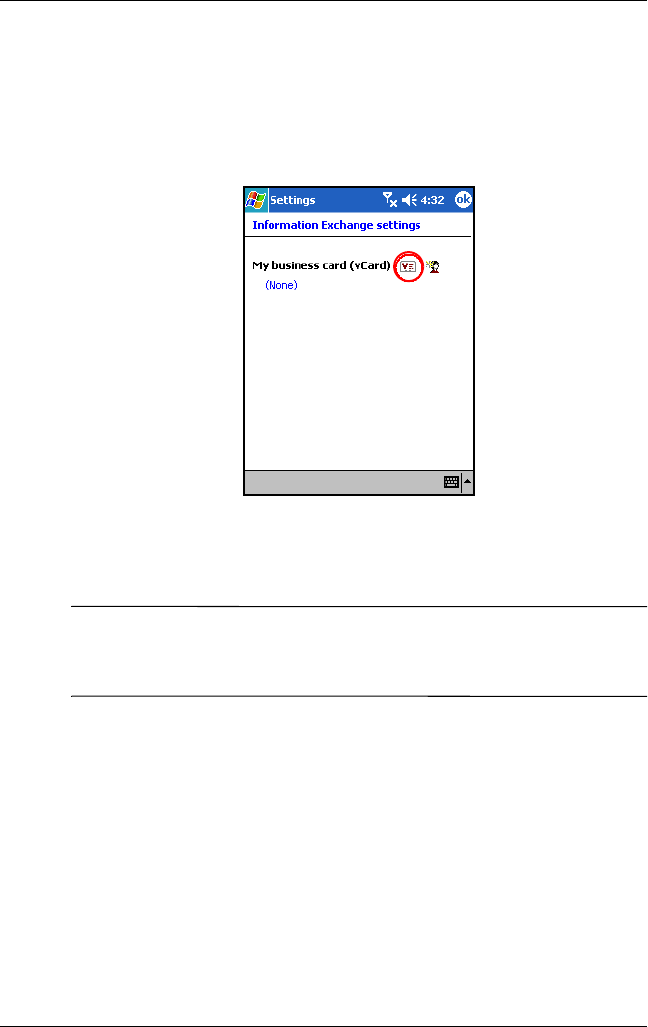
8VHU·V*XLGH ²
8VLQJ%OXHWRRWK
Information Exchange Advanced Settings
If you selected Information Exchange and tapped the Advanced
button, the following screen displays.
1. Tap the My business card (vCard) icon.
2. Select your business card information from the Contact
Information List and tap OK to save the settings.
3. Tap OK again to return to the iPAQ Wireless screen.
NOTE: To create a new business card, tap the Contacts icon next
to the vCard icon and create a new business card. Tap OK when
you are finished.
Serial Port Advanced Settings
If you selected Serial Port and tapped on the Advanced button:
1. Change the Inbound COM Port and Outbound COM Port
numbers if they are incorrect.
2. Tap OK to save the settings and exit the screen.
3. Tap OK again to return to the iPAQ Wireless screen.

8VLQJ%OXHWRRWK
8VHU·V*XLGH ²
Hands Free Advanced Settings
If you selected Hands Free and tapped on the Advanced button:
The hands-free settings are automatically set.
1. Tap the checkboxes to select or deselect any settings.
2. Tap OK to save the settings and exit the screen.
3. Tap OK to return to the iPAQ Wireless screen.
Requiring Authorization to Access Services
If you elect to require authorization to access services, you must
authorize each connection. Your Pocket PC will then always ask
you if the connection should be permitted.
To require authorization to access services:
1. From the Today screen, tap iPAQ Wireless >Bluetooth >
Settings > Services tab.
2. Tap the tab for the service you want to enable: File Transfer,
Information Exchange, Serial Port, Dial-up Networking,
Personal Network Server, or Audio Gateway.
3. Select Authorization required.
4. Tap OK.
Secure Connections using a Passkey or Bond
To establish a secure connection with another device, you can use
the passkey feature or an established bond. You can also add data
encryption to this type of security.
A passkey is a code you enter to authenticate connections
requested by other devices. The passkey must be known and
used by both parties or the connection will not be allowed.
To require a passkey or bond:
1. From the Today screen, tap iPAQ Wireless >Bluetooth >
Settings > Services tab.
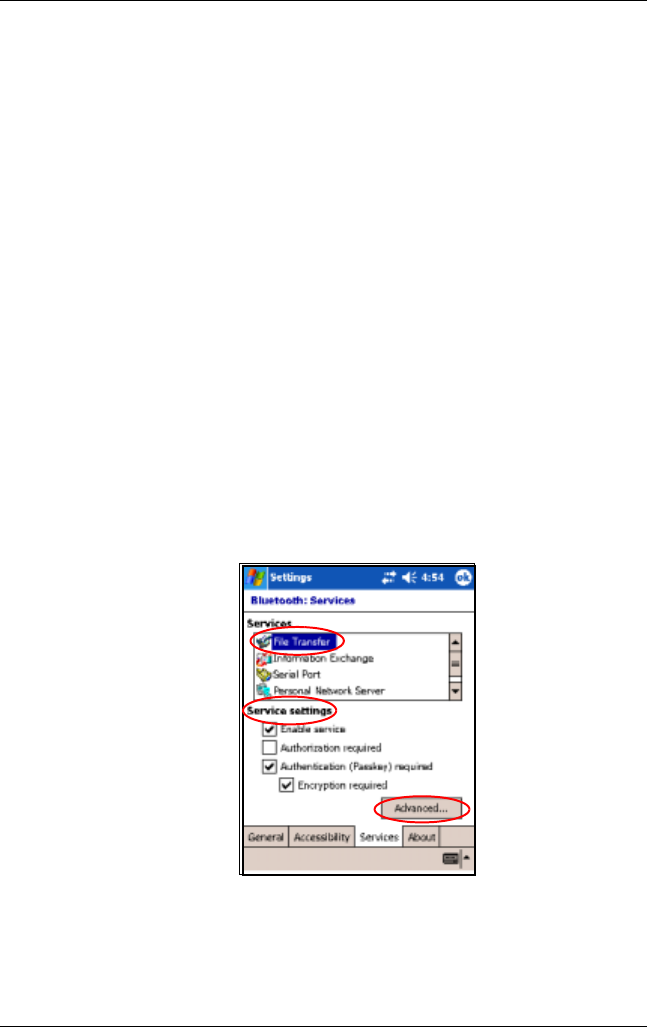
8VHU·V*XLGH ²
8VLQJ%OXHWRRWK
2. Tap the tab for the service you want to enable: File Transfer,
Information Exchange, Serial Port, Personal Network
Server, Hands free, or Dial-up Networking Server.
3. Select Authentication (Passkey) required.
4. Select Encryption Required if you want to require all data
exchanged between the devices to be encrypted.
5. Tap OK.
Setting a Shared Folder
You can determine the folder that other devices access when they
connect to your Pocket PC.
To select a shared folder:
1. From the Today screen, tap the iPAQ Wireless icon >
Bluetooth > Settings > Services tab.
2. Under Services, tap File Transfer.
3. Under Service Settings, select your preferred settings.
4. Tap the Advanced tab.
5. Tap the Folder icon and locate a desired file folder.
6. Tap OK.

8VLQJ%OXHWRRWK
8VHU·V*XLGH ²
Understanding Profiles
Use profiles to quickly enable selected personal settings in
multiple environments.
Creating a Profile
To create a profile:
1. From the Today screen, tap the iPAQ Wireless icon in the
Command bar.
2. Tap Bluetooth >Settings > General tab > Profile icon.
3. Tap the New button.
4. Enter a descriptive name.
5. Select an existing profile to use as a template.
6. Tap OK.
Activating a Profile
When a new profile is created, you will need to activate it.
To activate a profile after creating it:
1. From the Today screen, tap the iPAQ Wireless icon in the
Command bar > Bluetooth > Settings.
2. From the General tab, select it from the Current Profile
down arrow list.
3. Tap OK.
Saving Bluetooth Configuration Settings
in a Profile
To save the Pocket PC Bluetooth configuration settings to any
profile:
1. From the Today screen, tap the iPAQ Wireless icon in the
Command bar > Bluetooth > Settings.
2. From the General tab, tap the Profile icon.

8VHU·V*XLGH ²
8VLQJ%OXHWRRWK
3. Select a profile from the Add/Delete Profiles list or create a
new one.
4. Tap OK.
5. Set up your Pocket PC. You should specify the desired
connection, sharing, and security settings in all Bluetooth
Services selections.
6. Tap OK to close Bluetooth Services. The changes are
automatically saved.
Renaming a Profile
1. From the Today screen, tap the iPAQ Wireless icon in the
Command bar > Bluetooth > Settings.
2. From the General tab, tap the Profile icon.
3. Select a profile from the Add/Delete Profiles list.
4. Tap the Rename button.
5. Enter a new descriptive name.
6. Tap Enter.
7. Tap OK.
Deleting a Profile
1. From the Today screen, tap the iPAQ Wireless icon >
Bluetooth > Settings.
2. From the General tab, tap the Profile icon.
3. Select a profile from the Add/Delete Profiles list.
4. Tap the Delete button.
5. Tap Ye s to confirm you want to delete the profile.
6. Tap OK.

8VLQJ%OXHWRRWK
8VHU·V*XLGH ²
Working with Bluetooth Manager
Use Bluetooth Manager to:
■Establish connections
■Exchange business cards
■Control the on-screen display
■Display shortcuts
Opening Bluetooth Manager
From the Today screen, tap the iPAQ Wireless icon in the
Command bar > Bluetooth > Manager.
The first screen that displays is My Shortcuts.
NOTE: Bluetooth must be powered on to enable the Bluetooth
Manager button. You cannot access Manager if you press the
Manager button while in a disabled state. For this reason, tapping
the Bluetooth power-on button is included in all following
instructions. If Bluetooth is already powered on when you are
performing the tasks, do not tap the Bluetooth button again.
Tapping the Bluetooth button when it is already on will turn it off.
Locating and Selecting a Device
Several tasks require you to locate a device and connect to it.
When you are required to locate a device, the Bluetooth browser
assists by searching for your desired function that supports other
Bluetooth devices.
Pairing Devices
You can pair devices so they must exchange a computer generated
security key prior to each connection. It is generated from a
unique Bluetooth device address, a random number, and a
user-defined password.

8VHU·V*XLGH ²
8VLQJ%OXHWRRWK
After two devices are paired, they have a trusted relationship with
each other. No additional input is needed from the user.
Therefore, connections and activities can be performed between
the paired devices without constant authorization from the user.
To pair devices:
1. From the Today screen, tap the iPAQ Wireless icon in the
Command bar > Bluetooth > Manager.
2. Tap Tools > Paired devices.
3. Tap Add.
4. Tap the Lookup icon.
5. Tap a device.
6. Enter a password in the Passkey field.
7. Tap OK.
8. Enter the same password into the other device.
NOTE: Some devices, such as mobile phones, need to be placed
in a mode to accept a bond from another device. Refer to that
device’s user instructions for more information.
Unpairing Devices
You can remove a paired relationship between devices.
1. From the Today screen, tap the iPAQ Wireless icon in the
Command bar > Bluetooth > Manager.
2. Tap Tools >Paired devices.
3. Tap a device name.
4. Tap Remove.
5. Tap Ye s to remove the pairing.

8VLQJ%OXHWRRWK
8VHU·V*XLGH ²
Connecting to Other Devices
Use ActiveSync, serial and dial-up connections to communicate
with other Bluetooth devices. Establish a partnership with a cell
phone and set up the Bluetooth services it offers.
Identifying the Communications Port
You can identify the virtual COM ports used to create a
serial port connection. You may need to identify these COM
ports for activities such as printing.
Use the inbound COM port when other devices initiate a serial
connection. Use the outbound COM port when you initiate a
serial connection to another device.
To identify the communications port:
1. From the Today screen, tap iPAQ Wireless >Bluetooth >
Settings > Services tab.
2. Under Services, tap Serial Port and tap the Advanced...
button.
3. Note the names of your inbound and outbound COM ports.
4. Tap OK.
Establishing an ActiveSync Connection
You can set up an ActiveSync partnership with a
Bluetooth-enabled computer by first setting up your computer,
then setting up your Pocket PC.
If you own an HP Evo Notebook or Desktop computer, you can
use the Bluetooth Multiport Module presinstalled on that
computer with your Pocket PC.
If you are using other Bluetooth modules or cards on your
computer, refer to the Bluetooth Configuration Manager or
Settings for similar setup procedures, then skip to “Setting Up an
ActiveSync Partnership on Your Pocket PC.”
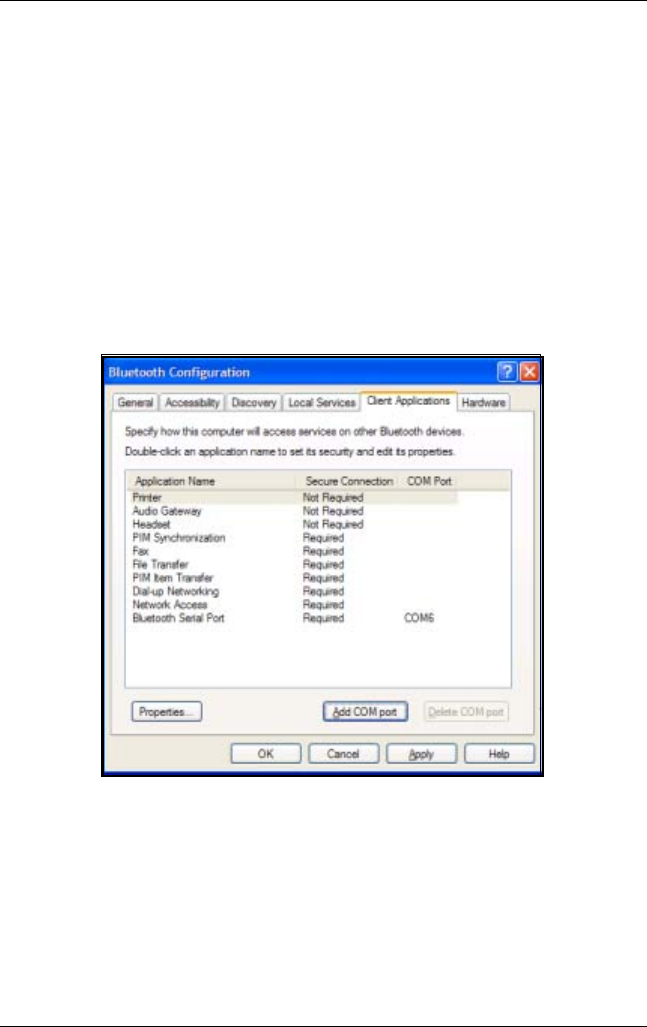
8VHU·V*XLGH ²
8VLQJ%OXHWRRWK
Using the HP Bluetooth Multiport Module for
Evo Notebooks and Desktops
1. Remove your Pocket PC from the USB Synchronization
Cradle.
2. Turn on Bluetooth on both the Pocket PC and the Evo
computer.
3. Right-click the Bluetooth icon in the system tray on your
computer, then click Advanced Configuration.
4. Select the Client Applications tab, then write down the
COM port number listed next to Bluetooth Serial Port.
5. Select Bluetooth Serial Port, then click on the Delete COM
Port button.
6. Click on the Local Services tab, then click Add Serial
Service.
7. Type a name for the serial service, then select Startup
Automatically.
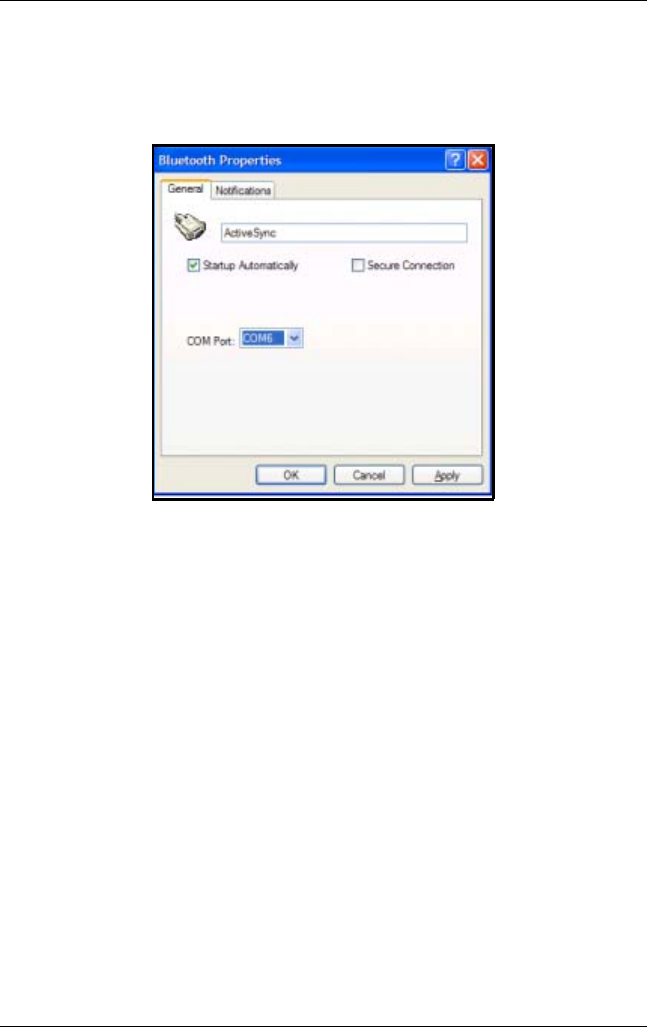
8VLQJ%OXHWRRWK
8VHU·V*XLGH ²
8. Remove the checkmark from the Secure Connection box,
then select the COM port that is the same as the one you
wrote down earlier. Click Apply > OK > OK.
9. Open ActiveSync on your computer, then click File >
Connection Settings.
10. Check the Allow Serial Cable or Infrared Connection to
this COM Port box.
11. Select the COM port that is the same as the one you wrote
down earlier, then click OK.
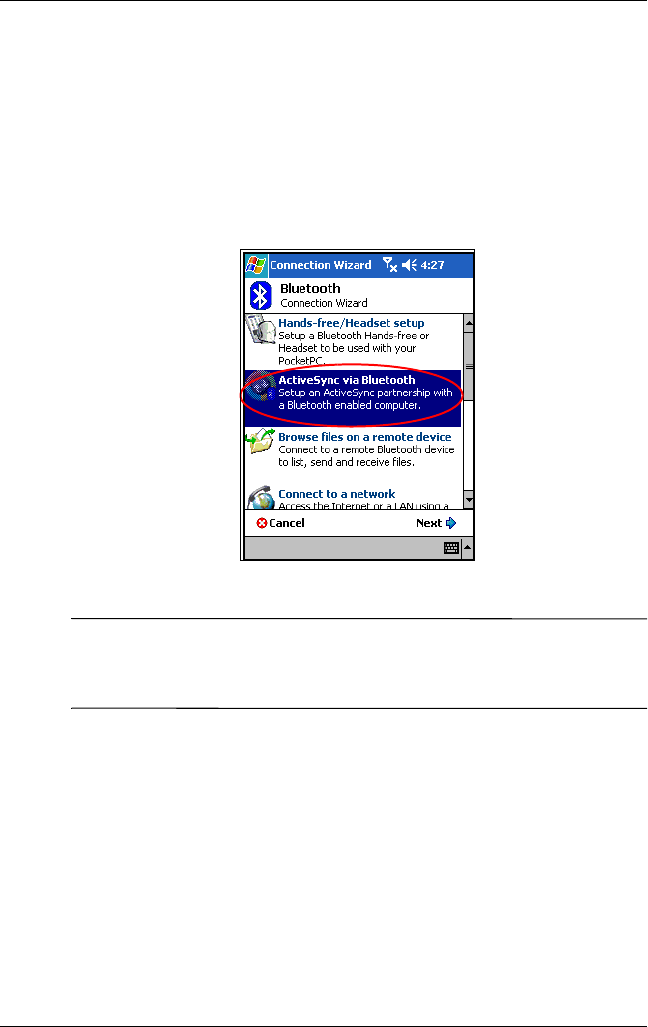
8VHU·V*XLGH ²
8VLQJ%OXHWRRWK
Setting Up an ActiveSync Partnership
on Your Pocket PC
To establish an ActiveSync connection:
1. From the Today screen, tap iPAQ Wireless >Bluetooth >
Manager.
2. Tap New > ActiveSync via Bluetooth >Next.
3. Follow the connection wizard instructions.
NOTE: Be sure the ActiveSync COM port setting on your Pocket
PC is the same as the COM port setting used for Bluetooth on
your computer.
4. From the Bluetooth Browser screen, select the computer you
want to synchronize with. Tap Next.
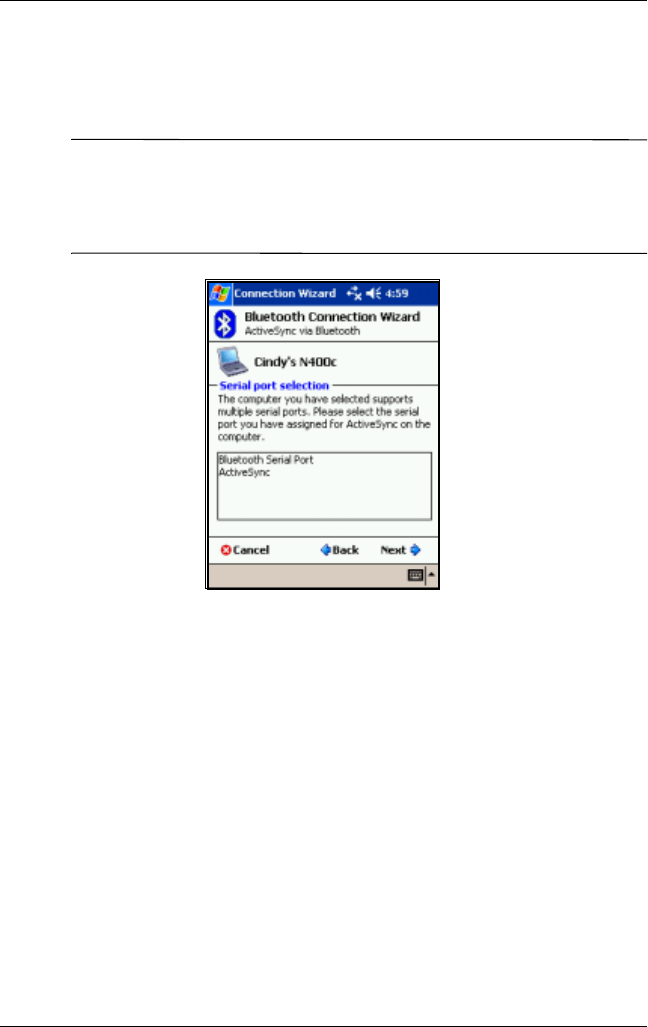
8VLQJ%OXHWRRWK
8VHU·V*XLGH ²
5. Under Serial Port Selection, select the name of the serial
port for the computer selected above, and then tap Next >
Finish.
NOTE: If you are setting up the ActiveSync partnership with an
Evo Notebook or Desktop computer, select the name you typed in
Step 7 of “Using the HP Bluetooth Multiport Module for
Evo Notebooks and Desktops.”
.
Establishing a Serial Connection
Use the wireless Bluetooth serial port connection just as you
would a physical serial cable connection. You must configure the
application that will use the connection to the correct serial port.
To establish a serial connection:
1. From the Today screen, tap the iPAQ Wireless icon >
Bluetooth > Manager.
2. Tap New >Explore a Bluetooth device >Next.
3. Follow the connection wizard instructions.

8VHU·V*XLGH ²
8VLQJ%OXHWRRWK
Dial-Up Networking
When you use dial-up networking (DUN), the remote device
providing the dial-up networking service and the remote
computer to which you are connecting must both have telephone
access.
Devices that can provide dial-up networking include Bluetooth:
■Mobile phones
■Desktop computers
■Modems
Using Dial-Up Networking
To connect to a device that provides modem access:
1. From the Today screen, tap iPAQ Wireless >Bluetooth >
Manager.
2. Tap New > Connect to a Network >Next.
3. Follow the connection wizard instructions.
NOTE: After you create the dial-up networking shortcut with a
device, tap and hold the shortcut icon in the My Shortcuts tab of
the Bluetooth Manager, and tap Connect.
4. Tap New Connection.
5. Tap OK.
6. Enter a name in the Connection Name field.
7. Enter a phone number. You must sometimes enter the country
code and area code, depending on where you are calling.
8. Tap OK to begin dialing.
NOTE: Some mobile phones require a bond between devices
(see the section “Pairing Devices”).

8VLQJ%OXHWRRWK
8VHU·V*XLGH ²
To connect to the Internet and use Pocket Internet Explorer, you
must first connect to a Bluetooth phone from Bluetooth Manager.
To make this connection the default dial-up connection for Pocket
Internet Explorer:
IMPORTANT: All Bluetooth default connections are made
using the following procedure. Default connections cannot be
made through Bluetooth Settings on the iPAQ Wireless screen.
1. From the Today screen, tap Start > Settings >
Connections tab.
2. Tap the Connections icon > Advanced tab.
3. Tap Select Networks.
4. Enable Bluetooth Settings from the dropdown list.
NOTE: The Bluetooth modem connection you created can be
viewed only from the Bluetooth Settings on the Connections
Task page.
Joining a Personal Area Network
Connect two or more Bluetooth devices to share files, collaborate
or play multiplayer games.
To establish a Personal Area Network connection:
1. From the Today screen, tap iPAQ Wireless >Bluetooth >
Manager.
2. Tap New >Join a personal network >Next.
3. Follow the Connection Wizard instructions.
Working with Files
You can exchange information with a connected device and use
the Bluetooth File Explorer to:
■Navigate through the directories.
■View files and folders.

8VHU·V*XLGH ²
8VLQJ%OXHWRRWK
■Create new folders.
■Send and receive files from a remote device.
■Delete and rename files on a remote device.
Creating a File Transfer Connection
1. From the Today screen, tap iPAQ Wireless >Bluetooth >
Manager.
The first screen that displays is My Shortcuts.
2. Tap New > Browse files on a remote device >Next.
3. Follow the connection wizard instructions.
NOTE: The remote device must have Bluetooth turned on and set
up to allow discovery before the connection can occur.
Sending Files
1. Tap and hold the file transfer shortcut icon, and tap Connect.
2. Tap File >Send a File…
3. Locate the file(s) to send.
4. Tap the file(s) to send it.
5. Tap OK.
Creating a Folder on a Remote Device
1. Tap and hold the file transfer shortcut icon, and tap Connect.
2. Navigate to the location you want for the new folder.
3. Tap File >Create a folder.
4. Enter a folder name while New Folder is selected, and tap
Enter.
5. Tap OK.

8VLQJ%OXHWRRWK
8VHU·V*XLGH ²
Receiving a File from a Remote Device
1. Tap and hold a file transfer shortcut icon, and tap Connect.
2. Navigate to the file location on the remote device.
3. Tap the file.
4. Tap File >Get.
5. Tap OK.
Deleting a File from a Remote Device
1. Tap and hold a file transfer shortcut icon, and tap Connect.
2. Navigate to the file location on the remote device.
3. Tap the file.
4. Tap File >Delete.
5. Tap Ye s to verify you want to delete the selected file.
6. Tap OK.
Using Business Card Exchange
Using the business card exchange, you can:
■Set up your own business card
■Send a business card to one or more devices
■Request a business card from one or more devices
■Exchange business cards with one or more devices
You must establish a default contact name to send or exchange
business card information.
You must first specify your default business card on the
Information Exchange tab in Bluetooth Settings. This name
becomes the default for business card transfers.

8VHU·V*XLGH ²
8VLQJ%OXHWRRWK
Setting Up Your Business Card Information
To set up your business card information:
1. Create a contact in the Contacts program that includes your
name, title, and other relevant information.
2. From the Today screen, tap iPAQ Wireless >Bluetooth >
Settings > Services tab.
3. Under Services, select Information Exchange.
4. Tap the Advanced... button.
5. Tap the My business card (vCard) icon.
6. Choose your contact from the list.
7. Tap OK.
Sending Business Cards
1. From the Today screen, tap the iPAQ Wireless icon in the
Command bar > Bluetooth > Manager.
2. Tap Tools > Business Card Exchange.
3. Tap the Send icon.
4. Tap the device where you want to send your business card.
5. Tap OK.
NOTE: Be sure the receiving device has been enabled to accept
the transfer.
Requesting Business Cards
1. From the Today screen, tap the iPAQ Wireless icon in the
Command bar > Bluetooth > Manager.
2. Tap Tools > Business Card Exchange.
3. Tap the Request icon.

8VLQJ%OXHWRRWK
8VHU·V*XLGH ²
4. Tap the device from which you want to request a business
card.
5. Tap OK.
Exchanging Business Cards
You can exchange business card information with another device.
If available, the device’s information will be sent directly into
your Contacts list in Pocket Outlook.
To exchange business cards:
1. From the Today screen, tap the iPAQ Wireless icon in the
Command bar > Bluetooth > Manager.
2. Tap Tools > Business Card Exchange.
3. Tap the Exchange icon.
4. Tap the device with which you want to exchange your
business card.
5. Tap OK.
Opening a Connection
1. From the Today screen, tap the iPAQ Wireless icon in the
Command bar > Bluetooth > Manager.
2. Tap and hold the icon or list name, and then tap Connect.
3. Tap OK.

8VHU·V*XLGH ²
8VLQJ%OXHWRRWK
Viewing Connection Status
You can view:
■Connection’s name
■Device’s name
■Connection status
■Length of connection
■Signal strength
To view the connection status:
1. From the Today screen, tap the iPAQ Wireless icon in the
Command bar > Bluetooth > Manager.
2. Tap and hold an active connection icon or list name, and
then tap Status.
3. Tap OK.
Closing a Connection
1. From the Today screen, tap the iPAQ Wireless icon in the
Command bar > Bluetooth > Manager.
2. Tap and hold the connection icon or list name.
3. Tap Disconnect from the menu.
4. Tap OK.
Viewing Connection Information
1. From the Today screen, tap the iPAQ Wireless icon in the
Command bar > Bluetooth > Manager.
2. Tap and hold the connection icon or list name.
3. Tap Properties from the menu.
4. Tap OK.

8VLQJ%OXHWRRWK
8VHU·V*XLGH ²
Working with Connections
You can create shortcuts to open and view status information for
all connections.
Creating a Shortcut
Creating a shortcut to one or more services does not establish
a connection. It only places a shortcut to that service on the
Shortcut tab of the Bluetooth Manager.
To create a shortcut:
1. From the Today screen, tap the iPAQ Wireless icon in the
Commnd bar > Bluetooth > Manager.
2. Tap New, and then a type of service, and tap Next.
3. Follow the connection wizard instructions.
NOTE: Paired devices are designated by a checkmark.
Deleting a Shortcut
1. From the Today screen, tap the iPAQ Wireless icon >
Bluetooth > Manager.
2. Tap and hold the connection icon or list name to be deleted.
3. Tap Delete from the menu.
4. Tap Ye s to verify the selected shortcut should be deleted.
5. Tap OK.

8VHU·V*XLGH ²
8VLQJ%OXHWRRWK
Viewing Shortcuts
You can view shortcuts as icons or in a list format.
1. From the Today screen, tap the iPAQ Wireless icon >
Bluetooth > Manager.
2. Tap View.
3. Tap List or Icon.
4. Tap OK.

8VHU·V*XLGH ²
10
Connecting to the Internet
Use your iPAQ Pocket PC to connect to the Internet or your Work
network.
To send and receive e-mail with Inbox and to view Web sites
with Pocket Internet Explorer, you must set up a remote
connection with devices such as a Secure Digital Input/Output
(SDIO) modem card, ethernet card, or the wireless 802.11b
internal radio. Another option is to use a Bluetooth-enabled
device such as a phone or LAN Access point.
Note: Use of dial-up and wireless Internet, e-mail, corporate
networks, and other wireless communications, such as
Bluetooth-enabled devices, might require additional hardware
and other compatible equipment that can be purchase separately,
in addition to a standard Wi-Fi infrastructure and a separately
purchased service contract. Check with your service provider for
availability and coverage in your area. Not all Web content may
be available. Some Web content may require installation of
additional software.
Note: For more information on this subject, refer to the Help file
on your iPAQ Pocket PC by tapping Start > Help >
Connections.

8VHU·V*XLGH ²
&RQQHFWLQJWRWKH,QWHUQHW
Connecting to a Private Network
1. Before you start, be sure to have your server phone number,
user name, and password. This information can be obtained
from your network administrator.
2. Tap Start > Settings > Connections tab > Connections icon.
3. In My Work Network, follow the instructions for each type
of connection. For more information on Bluetooth
connections, see Chapter 9, “Using Bluetooth.” For more
information on Wi-Fi connections, see “Setting Up VPN
Server Connections” or “Setting Up Proxy Server Settings”
in Chapter 8, “Using Wi-Fi.”
Entering an Internet Address
With Pocket Internet Explorer and a connection to the
Internet, you can view Web sites on your iPAQ Pocket PC by
typing an address or Uniform Resource Locator (URL) in the
Address bar.
Note: Web sites that use Hypertext Markup Language (HTML)
4.0, Dynamic HTML (DHTML), animated Graphic Interchange
Format (GIF) images, and Java applets might not work correctly
in Pocket Internet Explorer without additional software.
To enter an Internet address (URL) on your iPAQ Pocket PC:
1. From the Start menu, tap Internet Explorer > Address Bar.
Note: If the Address Bar is not visible, tap the View tab >
Address Bar to turn it on.
2. Enter the Internet address (URL) into the Internet Explorer
Address bar.
3. Tap the Go icon.
This is the common way to access a web site on the Internet.

&RQQHFWLQJWRWKH,QWHUQHW
8VHU·V*XLGH ²
Using a Favorites List
With Pocket Internet Explorer and a connection to the Internet,
you can view Web sites on your iPAQ Pocket PC by selecting one
from your Favorites list.
To select a Web site from your Favorites list:
1. From the Start menu, tap Internet Explorer.
2. Tap the Favorites icon and the Web site you want to view.

8VHU·V*XLGH ²
11
Expansion Cards
You can expand the memory and connectivity of your iPAQ
Pocket PC. Use optional expansion cards for:
■Expanding the memory of your iPAQ Pocket PC by using a
Compact Flash (CF) card
■Adding functionality such as a Secure Digital Input/Output
(SDIO) camera
■Viewing the content of Secure Digital and Multimedia
Memory Cards (SD/MMC)
Note: Expansion cards must be purchased separately and are not
included with your iPAQ Pocket PC.
To locate information about expansion cards, visit the following
HP Web site: www.hp.com/go/ipaqaccessories.
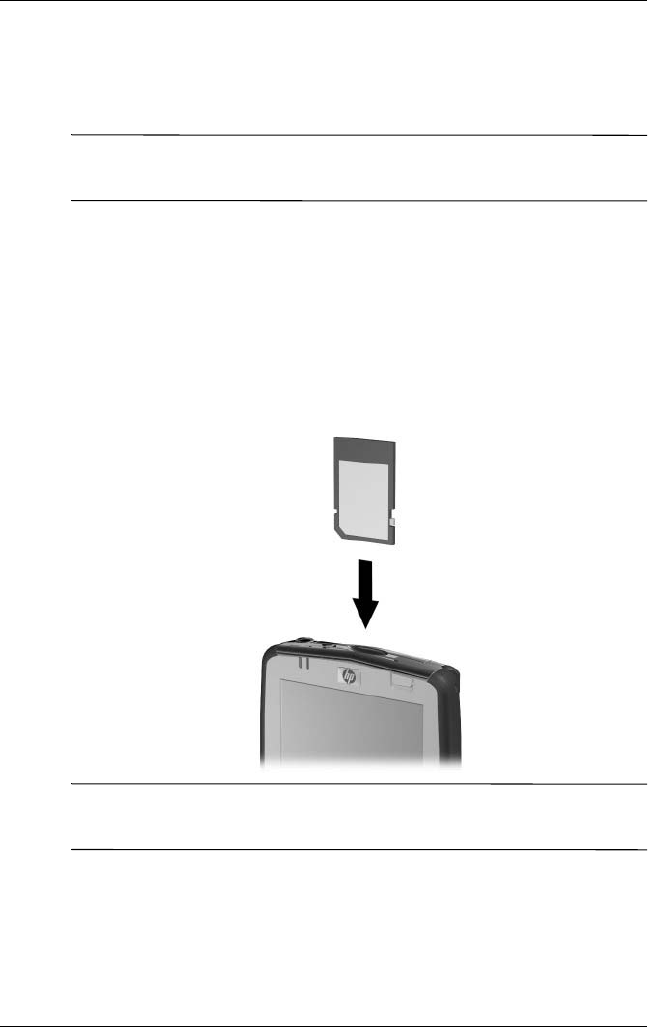
([SDQVLRQ&DUGV
8VHU·V*XLGH ²
Installing a Secure Digital (SD)
Expansion Card
Note: You install a SD card the same way you install a CF card
into the expansion slot.
To install a Secure Digital (SD) card into the expansion slot on
the iPAQ Pocket PC:
1. Locate the slot on the top of the iPAQ Pocket PC.
2. Remove the protective plastic card.
3. Insert the expansion card into the expansion slot and push the
connection edge of the card firmly into the expansion slot.
Note: If your expansion card is not recognized, follow the card
manufacturer’s instructions to install it.
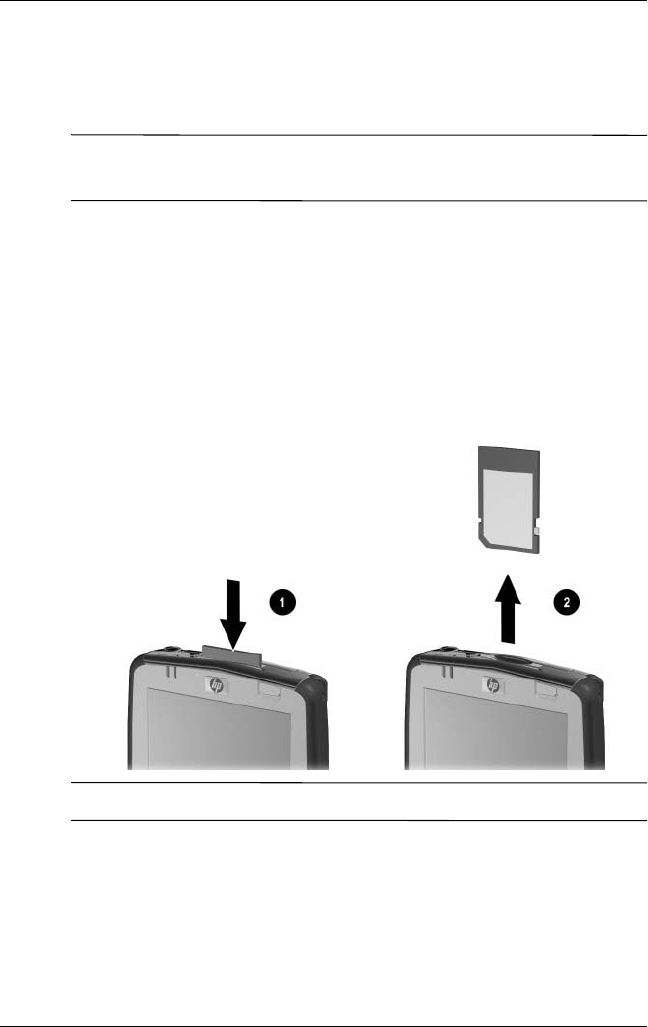
8VHU·V*XLGH ²
([SDQVLRQ&DUGV
Removing a Secure Digital (SD)
Expansion Card
Note: You remove a SD card the same way you remove a CF card
into the expansion slot.
To remove a Secure Digital (SD) expansion card from the
expansion slot on the iPAQ Pocket PC:
1. Close all applications that are using the expansion card.
2. Remove a card from the Secure Digital expansion slot by
slightly pushing down on the card 1 to unlock it.
3. When the card disengages and pops up 2, pull it from the
expansion slot.
ÄCAUTION: SD cards must first be unlocked before removal.
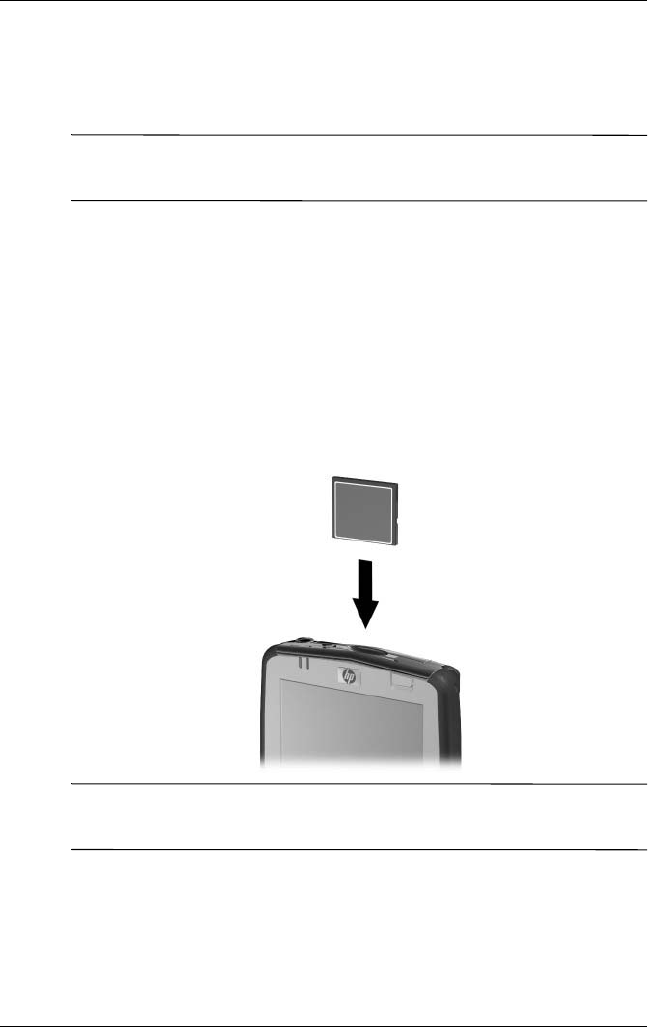
([SDQVLRQ&DUGV
8VHU·V*XLGH ²
Installing a Compact Flash (CF)
Expansion Card
Note: You install a CF card the same way you install a SD card
into the expansion slot.
To install a CF card into the expansion slot on the iPAQ Pocket
PC:
1. Locate the CF Type II slot on the top of the iPAQ Pocket PC.
2. Remove the protective plastic card.
3. Insert the expansion card into the expansion slot and push the
connection edge of the card firmly into the expansion slot.
Note: If your expansion card is not recognized, follow the card
manufacturer’s instructions to install it.
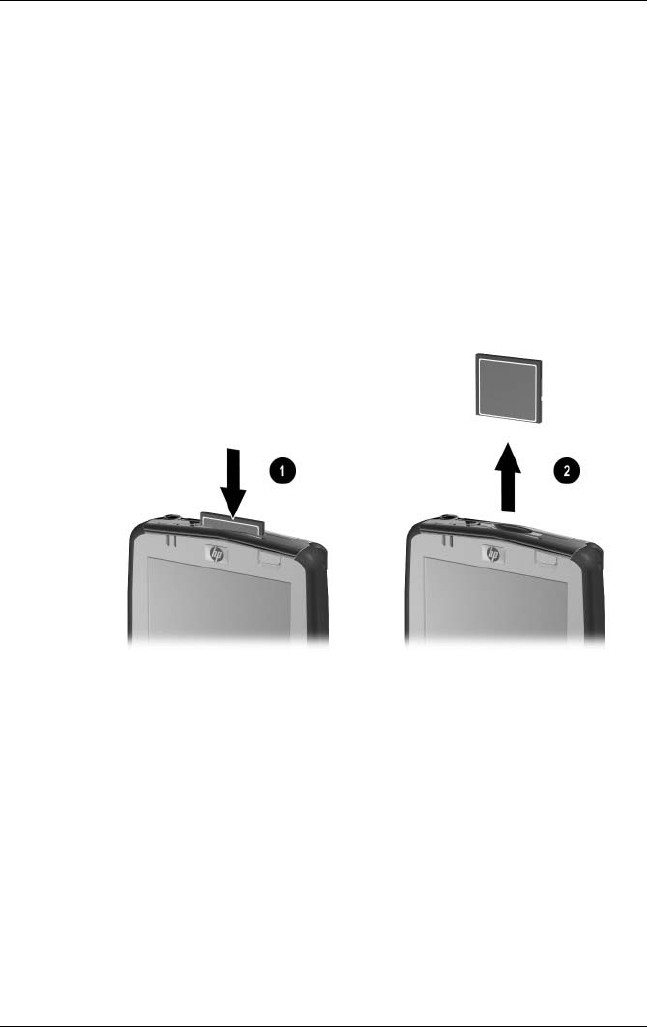
8VHU·V*XLGH ²
([SDQVLRQ&DUGV
Removing a Compact Flash (CF)
Expansion Card
To remove a CF expansion card from the Compact Flash Type II
expansion slot on the iPAQ Pocket PC:
1. Close all applications that are using the expansion card.
2. Pull on the CF card lip to remove the card from the CF
expansion slot.
Viewing the Content of Memory Cards
Use File Explorer to view the files that are located on your
optional Secure Digital card.
1. From the Start menu, tap Programs > File Explorer.
2. Tap the root directory of My Device, and select the Storage
Card folder to see a list of files and folders.

8VHU·V*XLGH ²
12
Troubleshooting
Use the following suggestions to troubleshoot problems with the
iPAQ Pocket PC.
Common Problems
Problem Solution
I cannot see
anything on the
screen.
■Be sure the iPAQ Pocket PC is powered on.
■Be sure the iPAQ Pocket PC is connected to the AC
Adapter and the Desktop Cradle.
■Reset the device by using the stylus to lightly press the
Reset button.
■Remove and replace the battery.
I cannot keep
my battery
charged.
■Always keep the iPAQ Pocket PC connected to the AC
Adapter when you are not using it.
■In the backlight settings, adjust the bar to a lower level
to conserve more battery power.
■Turn off Bluetooth and Wi-Fi when not in use.
The backlight
keeps turning
off.
■In Backlight Settings, increase the amount of time the
backlight stays on if not in use.
■Select the option to turn on the backlight when you
touch the screen or push a button.
(Continued)

8VHU·V*XLGH ²
7URXEOHVKRRWLQJ
I want to travel
with my iPAQ
Pocket PC.
■Back up your information.
■Take a copy of your backup with you on a SD memory
card.
■Disconnect all external devices.
■Take the AC Adapter and Charger Adapter with you.
■Keep your iPAQ Pocket PC in a protective case and
keep it in your carry-on luggage.
I want to travel
internationally
with my iPAQ
Pocket PC.
Be sure you have the plug adapter appropriate for the
country you are visiting.
I want to turn off
Bluetooth and
Wi-Fi for air
travel.
To turn off all wireless features, from the Today screen, tap
Start >iPAQ Wireless, and then ALL OFF button at the
bottom of the screen.
I want to ship
my iPAQ Pocket
PC to a repair
facility.
1. Back up your information.
2. Disconnect all external devices.
3. Pack your iPAQ Pocket PC and any external devices
requested by Customer Support in protective
packaging. Include any additional documentation or
items as instructed by Customer Support.
(Continued)
Problem Solution

7URXEOHVKRRWLQJ
8VHU·V*XLGH ²
I cannot connect
to a network.
■Be sure you have added the necessary server
information.
■Be sure the network you are attempting to connect to is
not busy.
■If you are using an SDIO Ethernet card, be sure the
proper drivers for your card are installed.
■Be sure your user name and password are correct.
■Ta p Start > Settings > Connections tab >
Connections and check your connection settings. Tap
OK when you are finished to save your changes.
■Be sure the WEP key is correct.
■Be sure the IP Address is correct.
■Be sure the hardware you are using with your iPAQ
Pocket PC is properly configured and operational.
■Reset the device by using the stylus to lightly press the
Reset button.
When I try to
open the Inbox,
I receive an
error or the
application
hangs.
Limit the number of e-mail services you create.
I get an error
when I try to
record a note
in Calendar or
in Tasks.
Try using a more compressed recording format in Calendar
or Tasks (8,000 Hz, Mono [8 KB/s] is the most compressed
format available). To switch to a more compressed
recording format, from the Today screen, tap Start >
Settings > Input > Options tab.
I want to see the
current date.
The current date is displayed at the top of the Today
screen.
I cannot
see all my
appointments.
Be sure the appointment you created is in the selected
category.
(Continued)
Problem Solution

8VHU·V*XLGH ²
7URXEOHVKRRWLQJ
I cannot find
the document
or workbook
Isaved.
Pocket Word and Excel recognize and display documents in
only one folder below My Documents. For example, if you
created another folder in the Personal folder in My
Documents, the documents in that folder will not be shown.
To find your document or workbook, from tap Start >
Programs > File Explorer. Open the folder you created,
and then tap the file in which you are looking.
My device is
always asking
me for a
password.
Ta p Start > Settings > Personal tab > Password to be
sure the password settings are configured as you want.
I cannot find
files sent to me
by another
device.
Check My Documents, which is the default save location
used to receive files.
Problem Solution

7URXEOHVKRRWLQJ
8VHU·V*XLGH ²
ActiveSync
Use the following suggestions to troubleshoot problems with
ActiveSync on your iPAQ Pocket PC. For more detailed
information on Microsoft ActiveSync, refer to Chapter 2,
“Synchronizing with Your Computer.”
Problem Solution
I cannot connect
to my computer
using the
Desktop Cradle.
■Be sure you have installed Microsoft ActiveSync 3.7 or
higher on your host computer before connecting your
iPAQ Pocket PC to it.
■Be sure your iPAQ Pocket PC is connected to the
Desktop Cradle, and that the cradle is connected to
your computer.
■Be sure your iPAQ Pocket PC is securely seated in the
cradle and is making contact with the cradle connector.
■Be sure you are running Microsoft Windows 98SE, Me,
2000, or XP and that you have installed Microsoft
ActiveSync 3.7.1 or a later version on your computer.
Also be sure you are connecting directly to a USB port
on your computer and not through a USB hub.
■Uninstall and reinstall ActiveSync.
■If you are running personal firewall software, try
disabling it. If you are then able to synchronize, contact
the software vendor to information on configuring the
required exclusions to eliminate this problem.
I connected my
iPAQ Pocket PC
before installing
Microsoft
ActiveSync.
1. Disconnect the iPAQ Pocket PC from your computer.
2. In Windows 98 or 2000, click Start > Settings >
Control Panel > System. The Device Manager opens
automatically. Locate and select the “unknown” USB
device record and click Remove (Uninstall in
Windows 2000).
3. Restart your computer and allow it to detect the USB
device.
4. Install Microsoft ActiveSync 3.7.1 or higher.
5. Reconnect the iPAQ Pocket PC to the computer.
(Continued)

8VHU·V*XLGH ²
7URXEOHVKRRWLQJ
Microsoft
ActiveSync
cannot locate
my iPAQ Pocket
PC when
I synchronize.
■Be sure the device is on.
■Be sure all cables are securely connected.
■Remove your iPAQ Pocket PC from the HP iPAQ
Cradle or disconnect it from the Autosync Cable, power
on the unit by pressing the Power button, then put it
back in the synchronization cradle or connect it to the
cable.
■Reset the device by using the stylus to lightly press the
Reset button.
■Check Connection Settings in ActiveSync on your
computer to ensure the communications port you are
using is active.
I cannot open
e-mail in the
Inbox after I
restore using
Microsoft
ActiveSync.
Use Microsoft ActiveSync to synchronize your iPAQ Pocket
PC with your computer. For more information, refer to the
“Synchronizing with Your Computer” section in Chapter 2.
I tried to
synchronize
a workbook
and the file
is unresolved
in Microsoft
ActiveSync.
Pocket Excel does not support all Excel formatting;
therefore, Microsoft ActiveSync cannot synchronize the file.
Problem Solution

7URXEOHVKRRWLQJ
8VHU·V*XLGH ²
Expansion Cards
Use the following suggestions to troubleshoot problems with
expansion cards on your iPAQ Pocket PC. For more information
on expansion cards, refer to Chapter 11, “Expansion Cards.”
Problem Solution
I cannot get my
iPAQ Pocket PC
to recognize the
expansion card.
■Be sure you have firmly pushed the expansion card
down into the iPAQ Pocket PC.
■Be sure you have inserted the appropriate card into the
appropriate slot.
■Be sure to install any third party drivers.
I cannot insert
my card.
■Be sure the label is facing the front of the unit.
■Be sure you are not inserting the card at an angle.
■Be sure you insert the connection area first.
I cannot remove
my SD card.
Push the SD card in to release the locking mechanism. The
card will pop out slightly and then can be easily removed.
My iPAQ Pocket
PC cannot
recognize
my card.
■Be sure you have loaded any drivers that came with the
expansion card you purchased.
■Reset the device by using the stylus to lightly press the
Reset button.

8VHU·V*XLGH ²
7URXEOHVKRRWLQJ
Bluetooth
Use the following suggestions to troubleshoot problems with
Bluetooth on your iPAQ Pocket PC. For more information on
Bluetooth, refer to Chapter 9, “Using Bluetooth.”
Problem Solution
I cannot
discover
another device.
■Be sure Bluetooth is turned on.
■Move closer to the device.
■Be sure you have not limited your ability to see devices.
■Be sure the device you are attempting to connect to is
on and allows access to being discovered by other
devices.
I can see other
devices, but I
cannot connect
or exchange
data with them.
■Be sure Bluetooth is turned on.
■Move closer to the device.
■Be sure the other device has not restricted your access.
■Try initiating pairing from the other device. Some
Bluetooth-enabled device can only initiate pairing and
cannot respond to pairing requests from other devices.
Other devices
cannot find or
connect to my
device.
■Be sure Bluetooth is turned on.
■Move closer to the device.
■Be sure you have not restricted other devices from
finding yours.
■Check your Bluetooth settings to ensure you have
allowed your device to be discovered and others to
connect.
(Continued)

7URXEOHVKRRWLQJ
8VHU·V*XLGH ²
Other devices
do not receive
my correct
business card
information.
■Be sure you have correctly set up your business card
information in Bluetooth Settings.
■Check Bluetooth Settings to be sure you have not
restricted this function.
The iPAQ
Pocket PC
cannot find my
Bluetooth-
enabled Mobile
phone.
■Be sure your mobile phone is in discoverable mode.
■Contact your mobile phone manufacturer and ask if
there is a firmware upgrade.
Problem Solution

8VHU·V*XLGH ²
7URXEOHVKRRWLQJ
Wi-Fi
Use the following suggestions to troubleshoot problems with
Wi-Fi issues and your iPAQ Pocket PC. For more information on
Wi-Fi, refer to Chapter 8, “Using Wi-Fi.”
Problem Solution
I cannot connect
to an access
point.
■Be sure the Wi-Fi is on.
■Be sure the device identified the network you want to
connect to.
■Be sure you provided any necessary authentication
keys if prompted by the system.
■Be sure your iPAQ Pocket PC is within range of the
access point.
I am connected
to an access
point, but I
cannot browse
the Internet.
If the wireless network you are connected to connects to
Work, the network may require a proxy. To set up the proxy:
1. Ask your network administrator for the proxy settings.
2. From the Today screen, tap Start > Settings >
Connections tab > Connections icon > Set up my
proxy server.
3. Refer to Chapter 8, in section “Setting Up Proxy Server
Settings” for more information.
I do not see
my wireless
network on
my iPAQ
Pocket PC.
Your wireless network could be a non-broadcasting
network.
1. From the Today screen, tap Start > Settings >
Connections tab > Connections icon > Settings.
2. Tap the Advanced tab > Select Networks.
3. Follow the instructions on the screen.
My data transfer
rate is too low.
■If Bluetooth is on, turn it off.
■Turn off the Power Save modes for Wi-Fi. Refer to
“Changing Wi-Fi Power Saving Modes” in Chapter 3,
“Managing the Battery” for more information.
(Continued)

7URXEOHVKRRWLQJ
8VHU·V*XLGH ²
I cannot connect
to an available
network that
shows in the list
of networks
without a name.
It is likely that the network is a “hidden” or non-SSID
broadcast network. You must know the network name
(SSID) to be able to connect.
1. Tap Start > Settings > Connections tab >
Connections > Advanced tab > Network Card.
2. Select Add New Settings.
3. Enter the network name (SSID).
4. Select the appropriate values in the Connects to: box.
5. If WEP settings are required, tap the Authentication
tab and enter them.
I cannot connect
reliably to an
available
network or
connections
are frequently
dropped.
■Be sure there is ample signal strength available in the
area.
■If you are using one of the Wi-Fi Power Save modes, try
changing modes or turning off Power Save. Refer to
“Changing Wi-Fi Power Saving Modes” in Chapter 3,
“Managing the Battery,” for more information.
■If you are using Extended Power Save mode, turn off
Bluetooth.
Problem Solution

8VHU·V*XLGH $²
A
Regulatory Notices
Federal Communications Commission
Notice
This equipment has been tested and found to comply with the
limits for a Class B digital device, pursuant to Part 15 of the FCC
Rules. These limits are designed to provide reasonable protection
against harmful interference in a residential installation. This
equipment generates, uses, and can radiate radio frequency
energy and, if not installed and used in accordance with the
instructions, may cause harmful interference to radio
communications. However, there is no guarantee that interference
will not occur in a particular installation. If this equipment does
cause harmful interference to radio or television reception, which
can be determined by turning the equipment off and on, the user
is encouraged to try to correct the interference by one or more of
the following measures:
■Reorient or relocate the receiving antenna
■Increase the separation between the equipment and receiver
■Connect the equipment into an outlet on a circuit different
from that to which the receiver is connected
■Consult the dealer or an experienced radio or television
technician for help
This PDA has been tested and demonstrated compliance when
Bluetooth and WLAN are transmitting simultaneously. This
PDA must not be co-located or operating in conjunction with any
other antenna or transmitter.

5HJXODWRU\1RWLFHV
8VHU·V*XLGH $²
Modifications
The FCC requires the user to be notified that any changes or
modifications made to this device that are not expressly approved
by Hewlett-Packard Company may void the authority to operate
the equipment.
Cables
Connections to this device must be made with shielded cables
with metallic RFI/EMI connector hoods in order to maintain
compliance with FCC Rules and Regulations.
Declaration of Conformity for products
marked with the FCC logo—United
States only
This device complies with Part 15 of the FCC Rules. Operation is
subject to the following two conditions: (1) this device may not
cause harmful interference, and (2) this device must accept any
interference received, including interference that may cause
undesired operation.
For questions regarding your product, contact:
Hewlett-Packard Company
P. O. Box 692000, Mail Stop 530113
Houston, Texas 77269-2000
Or, call 1-800-652-6672
For questions regarding this FCC declaration, contact:
Hewlett-Packard Company
P. O. Box 692000, Mail Stop 510101
Houston, Texas 77269-2000
Or, call (281) 514-3333
To identify this product, refer to the Part, Series, or Model
number found on the product.

8VHU·V*XLGH $²
5HJXODWRU\1RWLFHV
Canadian Notice
This Class B digital apparatus meets all requirements of the
Canadian Interference-Causing Equipment Regulations.
Avis Canadien
Cet appareil numérique de la classe B respecte toutes les
exigences du Règlement sur le matériel brouilleur du Canada.
Japanese Notice
Korean Notice
European Regulatory Notice
Radio product for indoor use in Home and Office environment
operating in the 2.4 GHz band – Wireless LAN.
0984

5HJXODWRU\1RWLFHV
8VHU·V*XLGH $²
Declaration of Conformity
This product complies with the following EU Directives:
■Low Voltage Directive 73/23/EEC
■EMC Directive 89/336/EEC
■R&TTE Directive 1999/5/EC
CE Compliance of this equipment is valid only if powered with
an HP-provided and CE marked AC adapter.
Compliance with these directives implies conformity to the
following European Norms (in parentheses are the equivalent
international standards and regulations):
■EN 55022 (CISPR 22) – Electromagnetic Interference
■EN 55024 (IEC 61000-4-2, 3, 4, 5, 6, 8, 11) -
Electromagnetic Immunity
■EN 61000-3-2 (IEC 61000-3-2) – Power line harmonics
■EN 61000-3-3 (IEC 61000-3-3) – Power line flicker
■EN 60950 (IEC 60950) – Product safety
■EN 300 328-2 – Data transmission equipment operating in
the 2.4 GHz ISM band and using 2.4 GHz radio equipment
using spread spectrum techniques
■EN 301 489-1, -17 – General EMC requirements for radio
equipment
The radio functionality of this equipment may be used in the
following EU and EFTA countries:
Austria, Belgium, Cyprus, Czech Republic, Denmark, Estonia,
Finland, France, Germany, Greece, Hungary, Iceland, Ireland,
Italy, Latvia, Liechtenstein, Lithuania, Luxembourg, Malta,
Netherlands, Norway, Poland, Portugal, Slovak Republic,
Slovenia, Spain, Sweden, Switzerland, and United Kingdom.

8VHU·V*XLGH $²
5HJXODWRU\1RWLFHV
Notice for Use in France and Italy
Italy:
E’necessaria una concessione ministeriale anche per l’uso del
prodotto. Verifici per favore con il proprio distributore o
direttamente presso la Direzione Generale Pianificazione e
Gestione Frequenze.
License required for use. Verify with your dealer or directly with
General Direction for Frequency Planning and Management
(Direzione Generale Pianificazione e Gestione Frequenze).
France:
L'utilisation de cet equipement (2.4GHz Wi-Fi) est soumise a
certaines restrictions: Cet equipement peut etre utilise a l'interieur
d'un batiment en utilisant toutes les frequences de 2400 a
2483.5MHz (Chaine 1-13). Pour une utilisation en environement
exterieur, vous devez utiliser les frequences comprises entre
2454-2483.5MHz (Chaine 10-13). Pour les dernieres restrictions,
voir http://www.art-telecom.fr.

5HJXODWRU\1RWLFHV
8VHU·V*XLGH $²
Battery Warning
ÅWARNING: This computer contains a lithium ion rechargeable
battery. To reduce the risk of fire or burns, do not disassemble, crush,
puncture, short external contacts, or dispose of in fire or water.
ÄCAUTION: Danger of explosion if battery is incorrectly replaced.
Replace only with the same or equivalent type recommended by
the manufacturer. Dispose of used batteries according to the
manufacturer’s instructions.
ÄCAUTION: Use only an HP approved battery for your iPAQ Pocket
PC. Inserting a battery that does not comply with HP requirements might
cause the Pocket PC to malfunction.
Because of the type of battery used in your iPAQ Pocket PC, follow
local regulations regarding the safe disposal of the battery. Your
vendor can advise you on local regulations, and/or the existence
of any battery disposal programs in operation.

8VHU·V*XLGH $²
5HJXODWRU\1RWLFHV
Equipment Warning
ÅWARNING: To reduce the risk of personal injury, electrical shock, fire
or damage to the equipment:
■Plug the AC Adapter into an electrical outlet that is easily
accessible at all times.
■Disconnect power from the equipment by unplugging the
AC Adapter from the electrical outlet or unplugging the
Synchronization cable from the host computer.
■Do not place anything on the AC Adapter cord or any of the other
cables. Arrange them so that no one may accidentally step on or
trip over them.
■Do not pull on a cord or cable. When unplugging from the
electrical outlet, grasp the cord by the plug or, in the case of
the AC Adapter, grasp the AC Adapter and pull out from the
electrical outlet.
■Do not use converter kits sold for appliances to power your
iPAQ Pocket PC.
Airline Travel Notice
Use of electronic equipment aboard commercial aircraft is at the
discretion of the airline.
Wireless Notices
In some environments, the use of wireless devices may be
restricted. Such restrictions may apply aboard airplanes, in
hospitals, near explosives, in hazardous locations, etc. If you are
uncertain of the policy that applies to the use of this device,
please ask for authorization to use it prior to turning it on.

5HJXODWRU\1RWLFHV
8VHU·V*XLGH $²
U.S. Regulatory Wireless Notice
ÅWARNING: Exposure to Radio Frequency Radiation
The radiated output power of this device is below the FCC radio
frequency exposure limits. Nevertheless, the device should be used in
such a manner that the potential for human contact during normal
operation is minimized. To avoid the possibility of exceeding the FCC
radio frequency exposure limits, human proximity to the antenna should
be minimized.
Canadian Regulatory Wireless Notice
Operation is subject to the following two conditions: (1) this
device may not cause interference, and (2) this device must
accept any interference, including interference that may cause
undesired operation of the device.
Japanese Regulatory Wireless Notice

8VHU·V*XLGH $²
5HJXODWRU\1RWLFHV
Brazilian Regulatory Wireless Notice
Este equipamento opera em caráter secundário, isto é, não tem
direito a proteção contra interferência prejudicial, mesmo de
estações do mesmo tipo, e não pode causar interferência a
sistemas operando em caráter primário.

8VHU·V*XLGH %²
B
Specifications
System Specifications
Note: Not all models described are available in all regions.
For more information on specifications for your specific model,
on your iPAQ Pocket PC, tap Start > Settings > System tab >
HP Asset Viewer.
System
Feature Description
Processor 316-624Mhz Intel Bulverde technology-based processor
RAM (Random
Access Memory)
64-128 MB SDRAM (55 MB main memory)
ROM (Read Only
Memory
64 MB ROM (Up to ? MB in the iPAQ File Store)
iPAQ File Store
(nonvolatile
memory)
? MB Storage
SD I/O slot SD/SDIO/MMC card support
CF slot Type II Compact Flash card support
Display 4.0 inch transflective type VGA TFT color,
480 x 640 pixels, 64K-color support, LED backlight
with power save mode.
LED Backlight Automatic multi-level brightness adjustment

8VHU·V*XLGH %²
6SHFLILFDWLRQV
Audio Integrated microphone, speaker, 3.5 mm stereo audio
jack, MP3 stereo through audio jack
Infrared (IrDA
and SIR/FIR)
IrDA, data transfer up to 4 Mb per second
External Power 10 watt maximum output AC Adapter
(Continued)
Bluetooth Class II device; typical 10 meters (30 feet) range
Indicators
(Left LED)
(Right LED)
Radio LED indicator:
LED off = all radios are off
Blue solid = one or more radios on
<Could be blinking or solid; final answer to come>
Charge/Notification LED indicator:
4-mode alarm notification:
LED off = not charging and no notifications
Amber flash = charging
Green flash = one or more notification events have
occurred
Amber solid = charging complete
Battery Slim Series: Removable/rechargeable 920-1440 mAh,
3.6 Volt, Lithium ion battery with internal backup battery
to maintain data during main battery replacement.
Extended Series: Removable/rechargeable ? mAh,
3.6 Volt, Lithium ion battery with internal backup battery
to maintain data during main battery replacement.
System
Feature Description

6SHFLILFDWLRQV
8VHU·V*XLGH %²
Physical Specifications
Note: Weight varies on different models.
Operating Environment
US Metric
Length
without flip cover
with flip cover
4.69 in
4.69 in
119.0 mm
119.0 mm
Width
without flip cover
with flip cover
3.02 in
3.17 in
76.6 mm
80.5 mm
Depth
without flip cover
with flip cover
.64 in
.79 in
16.3 mm
20.1 mm
Weight
without flip cover
with flip cover
6.65 - 7.19 oz
7.21 - 7.68 oz
188.5 - 201.8 g
204.5 - 217.8 g
Environment
US Metric
Temperature Operating 32° to 104° F 0° to 40° C
Nonoperating -4° to 140° F -20° to 60° C
Relative Humidity Operating up to 90% up to 90%
Nonoperating above 90% above 90%
Maximum Altitude Operating 15,000 ft 0-4572 m
Nonoperating 40,000 ft 0-12,192 m